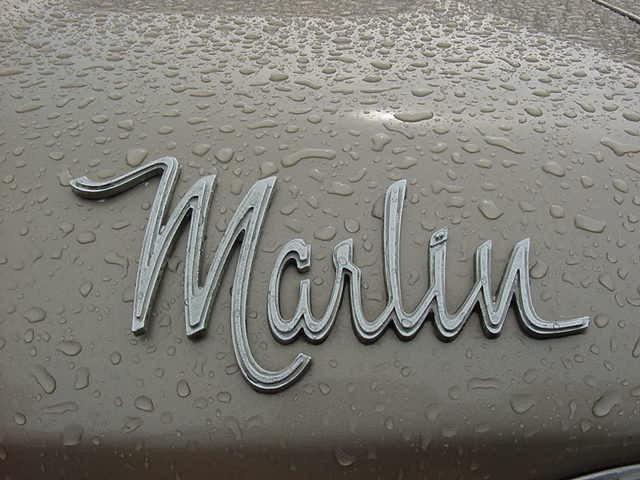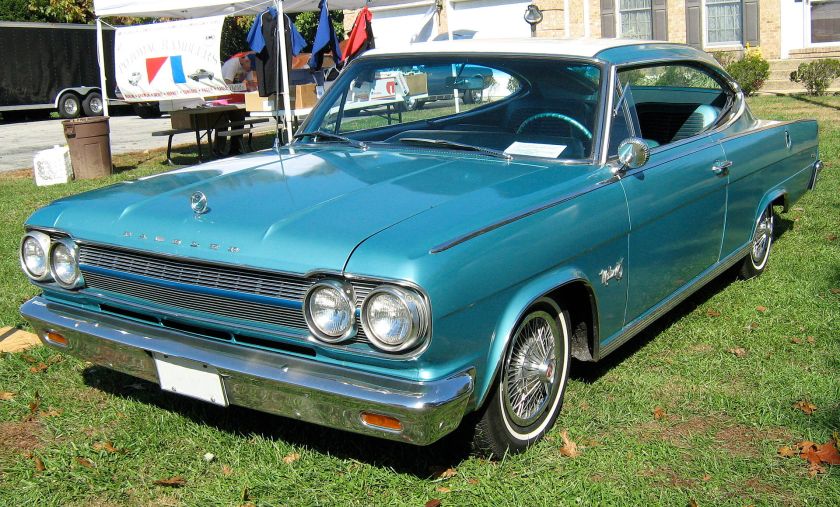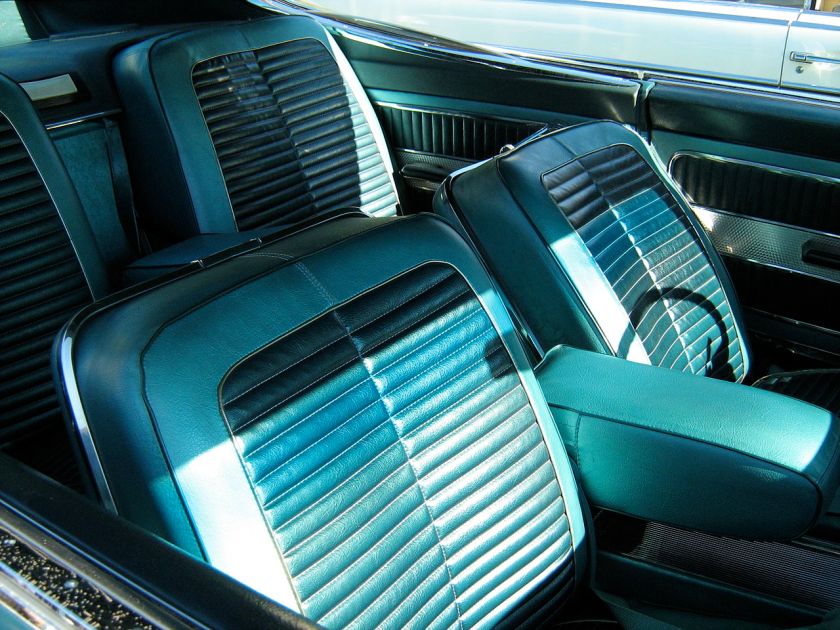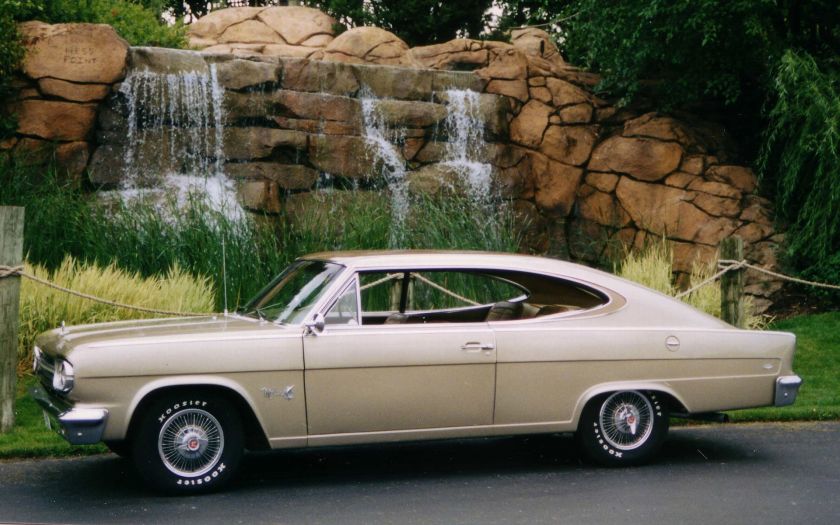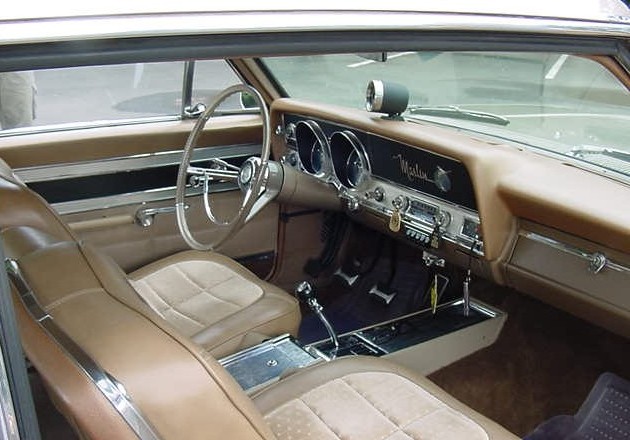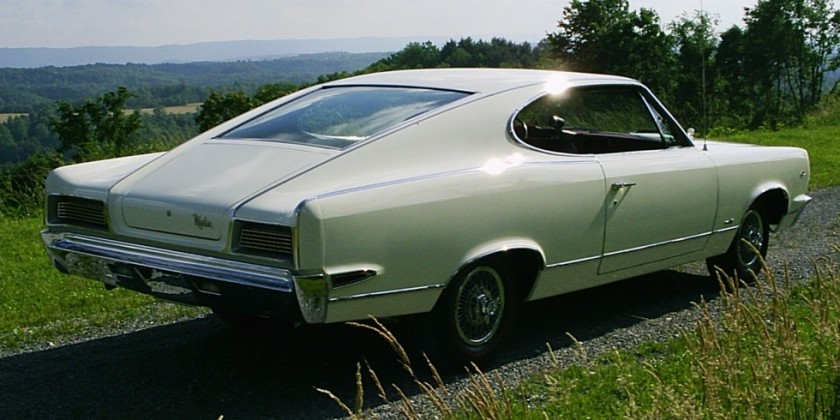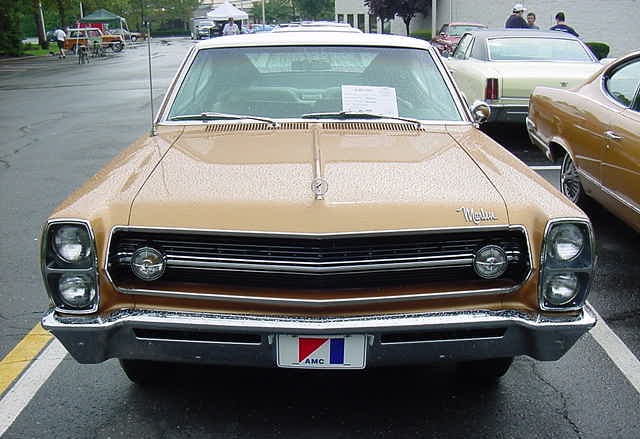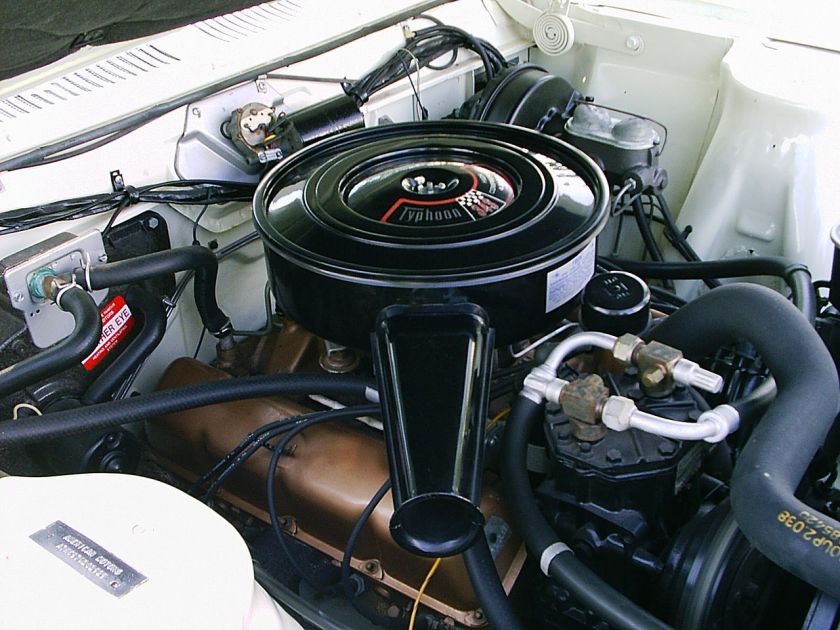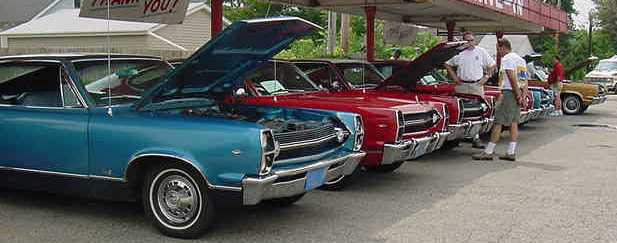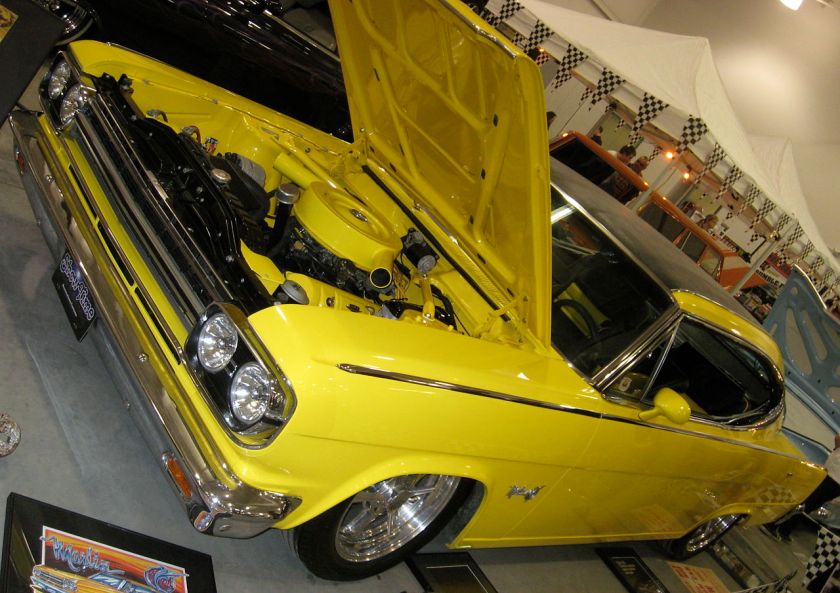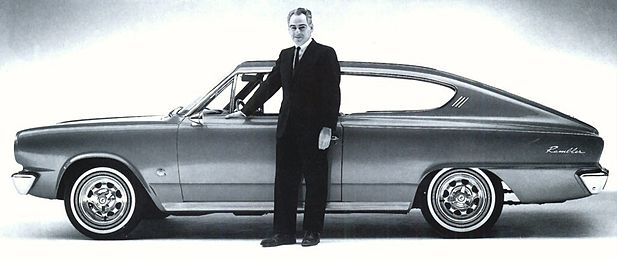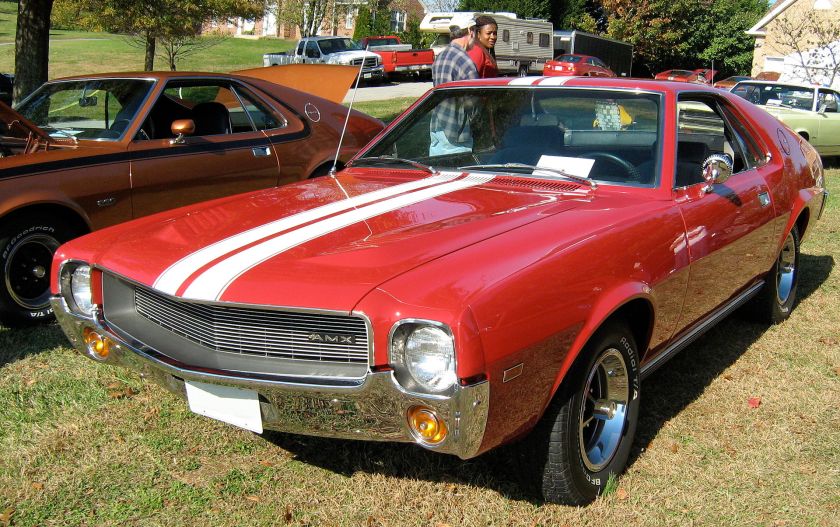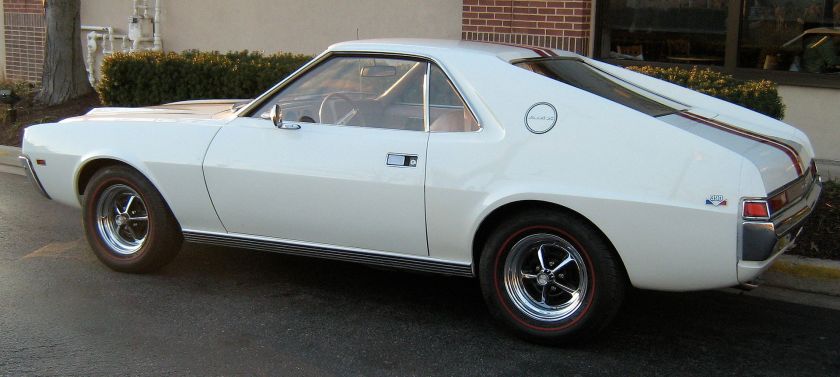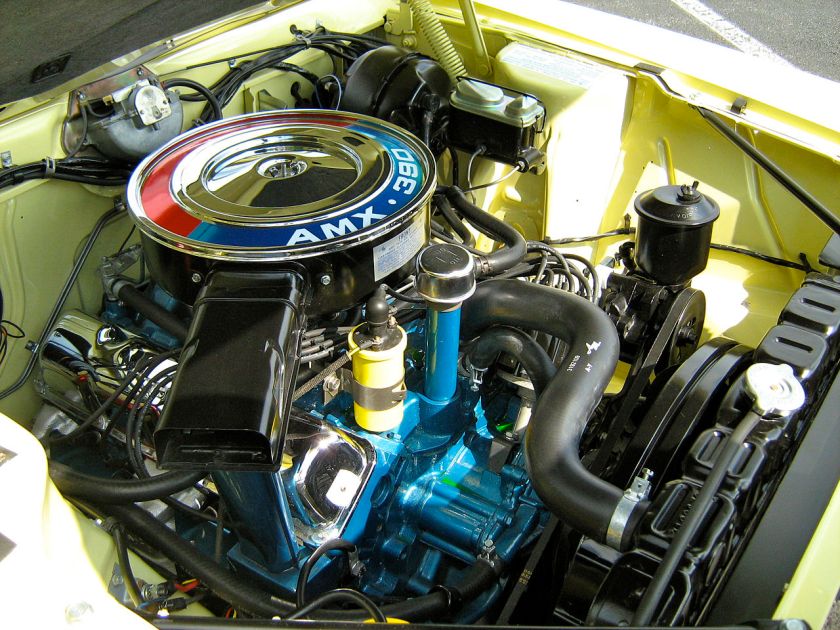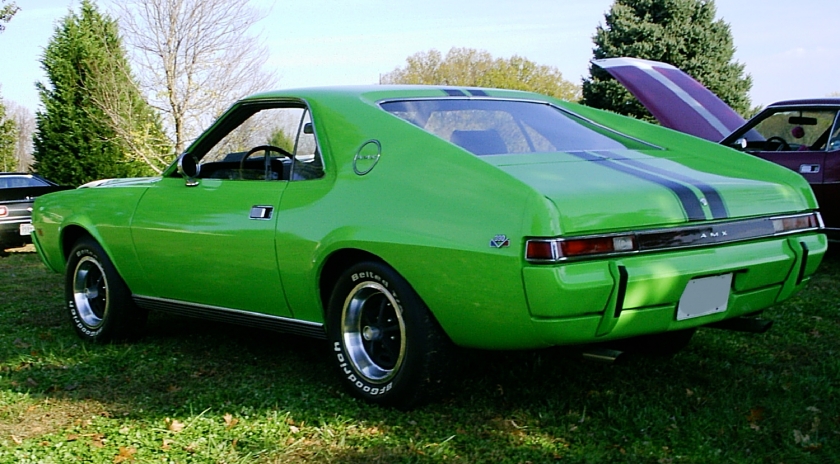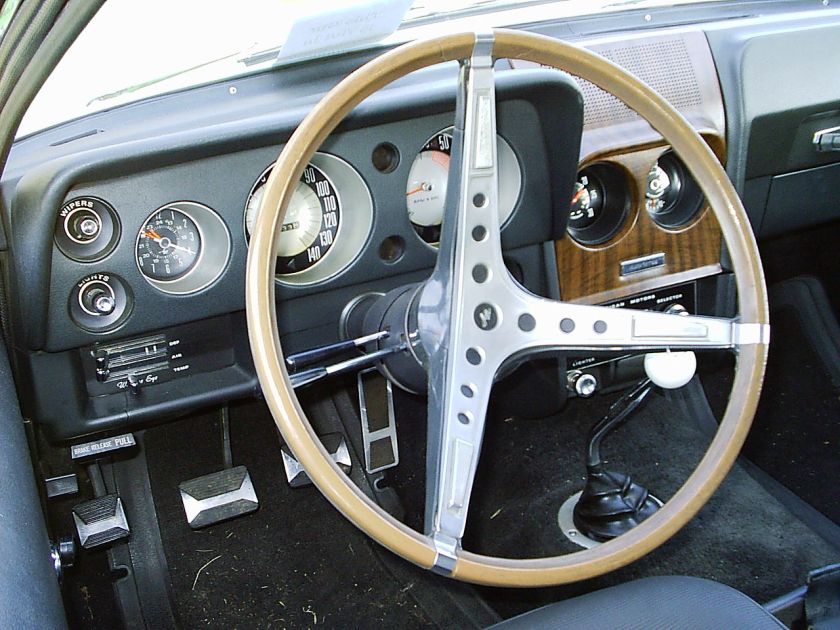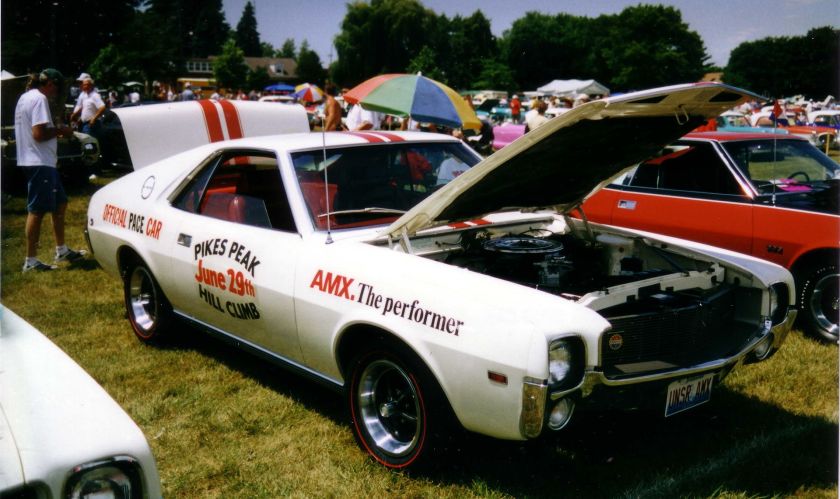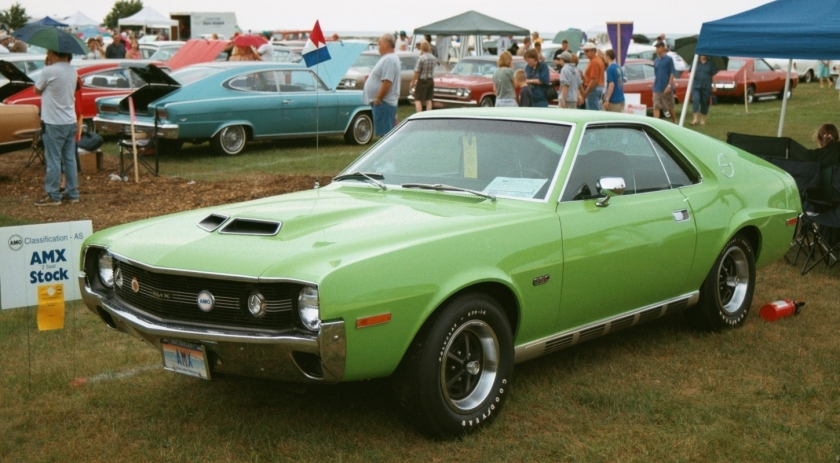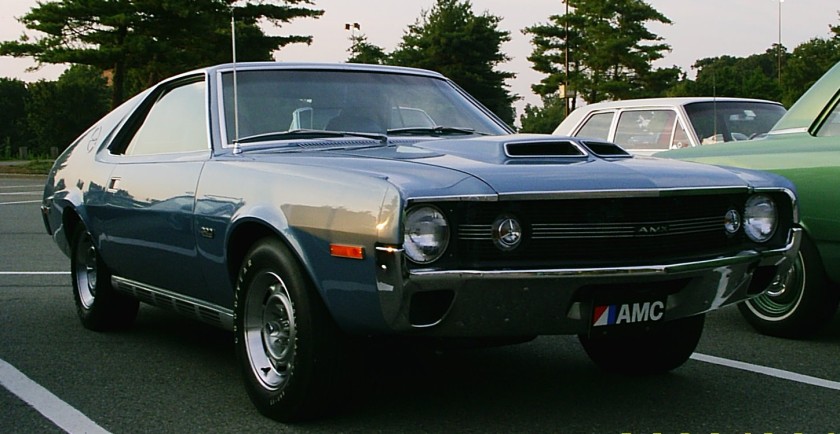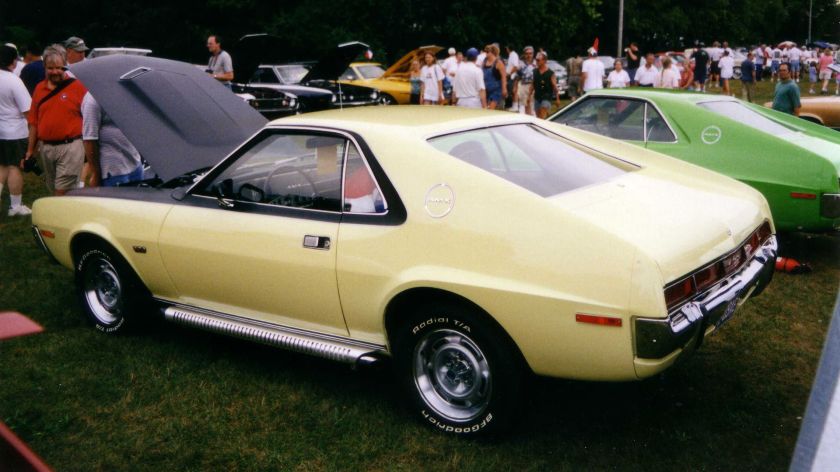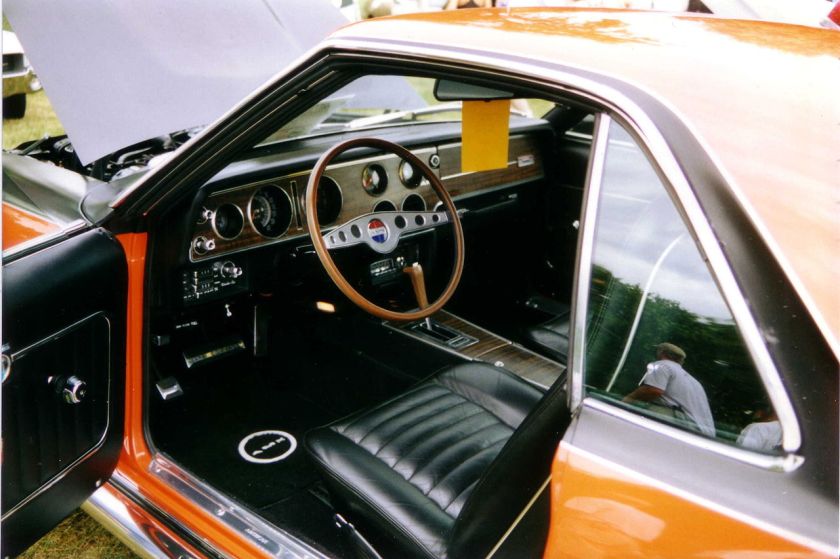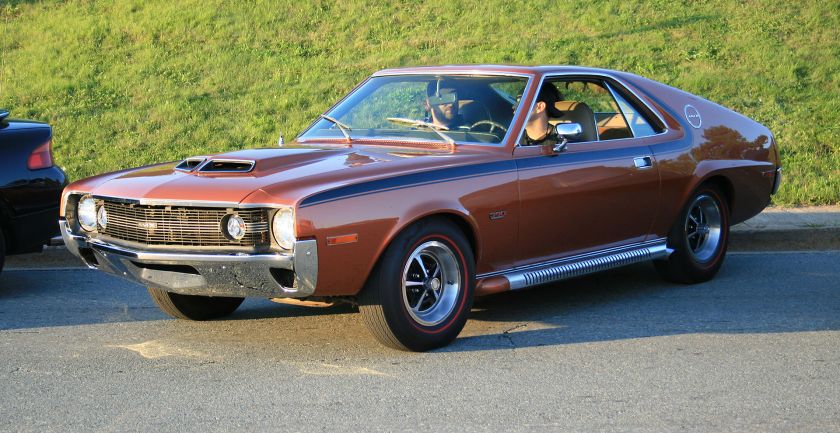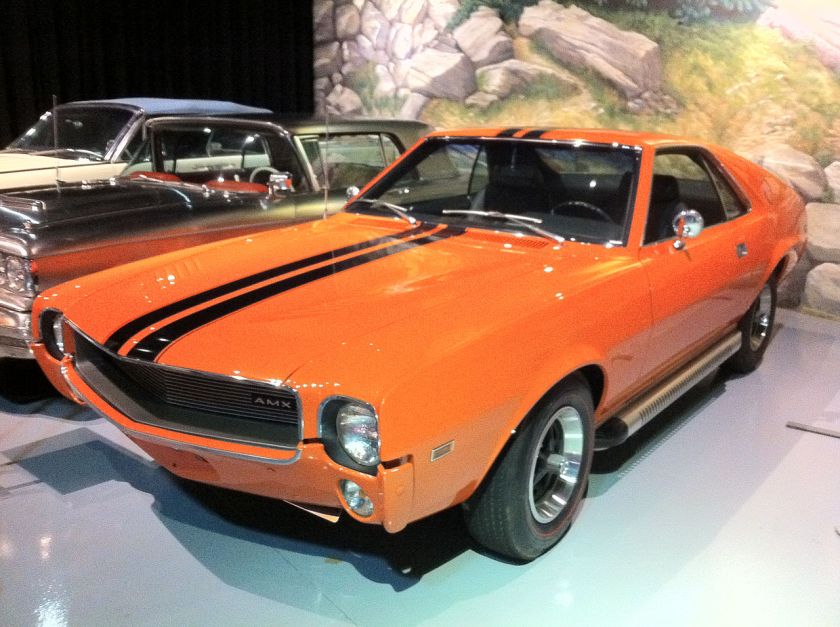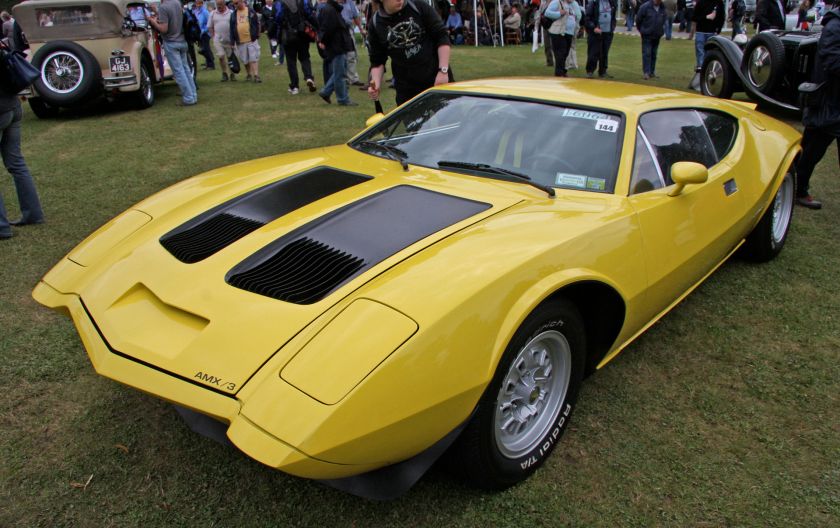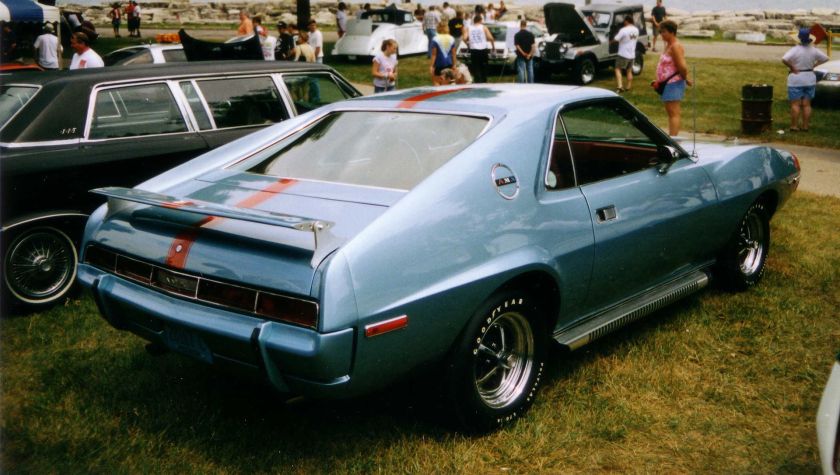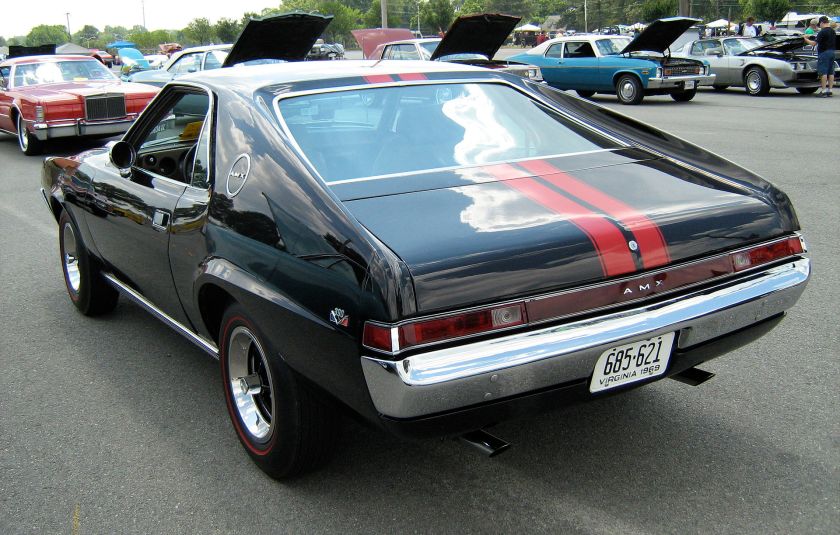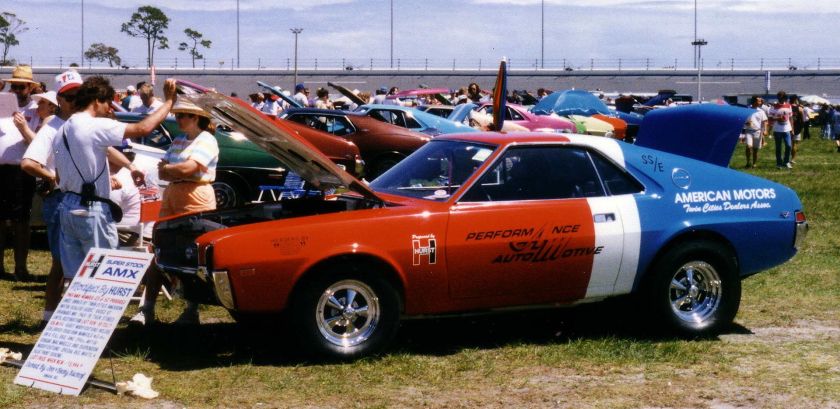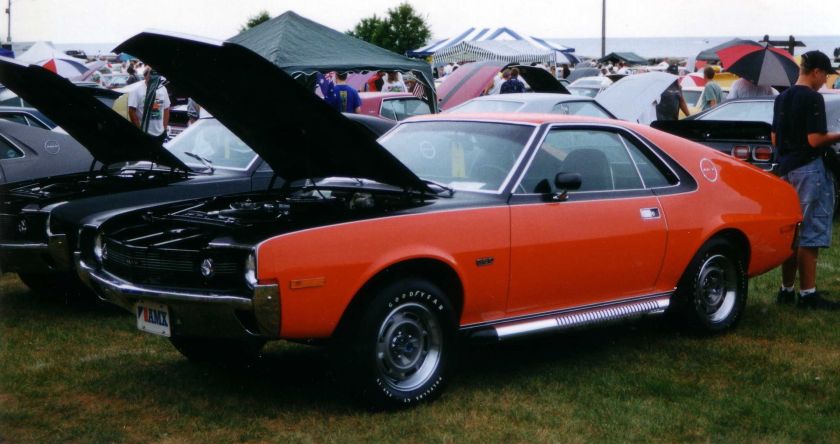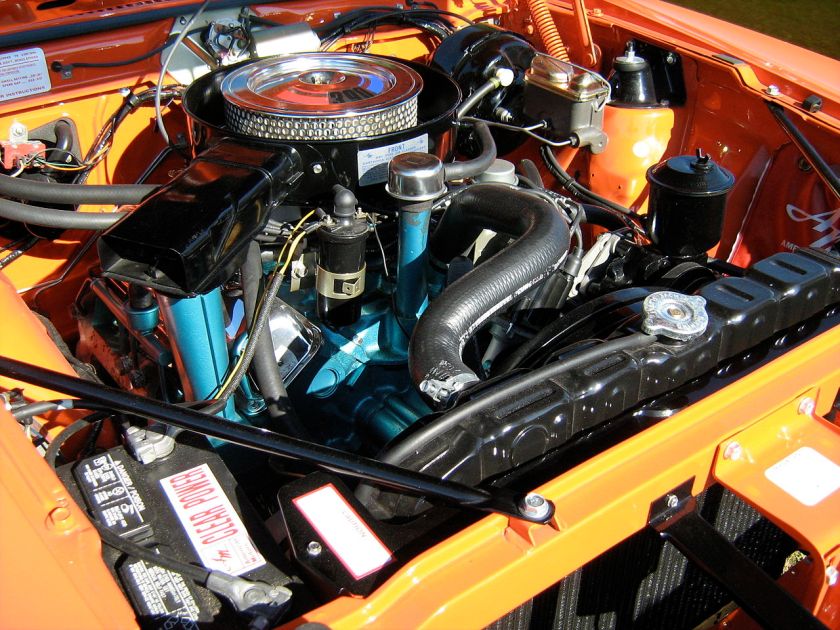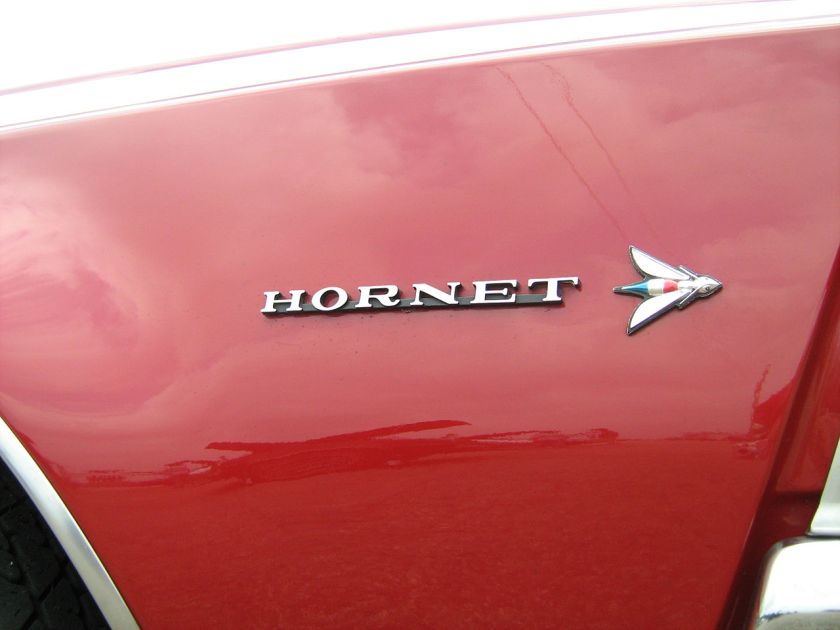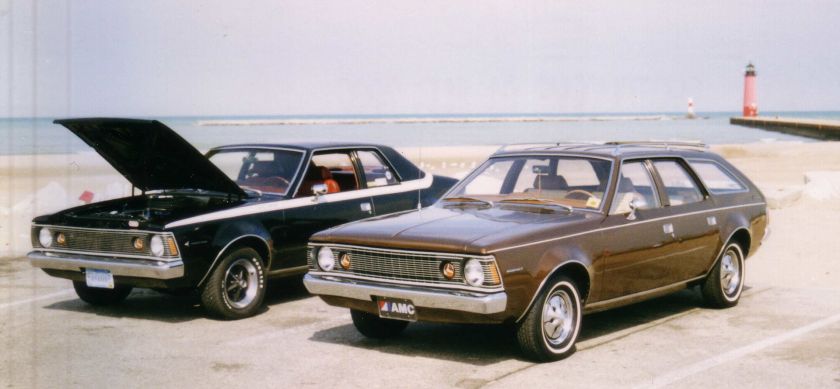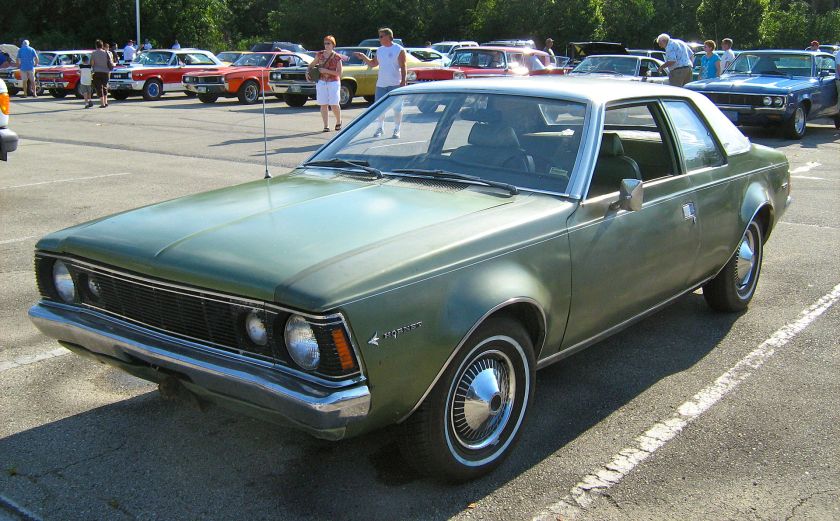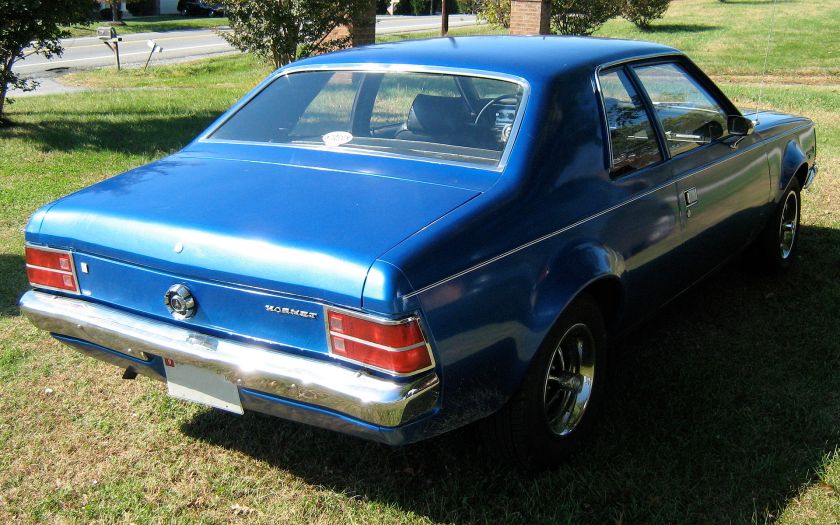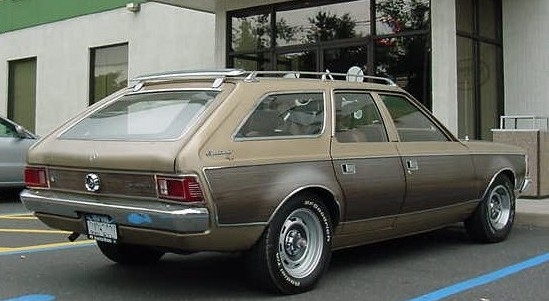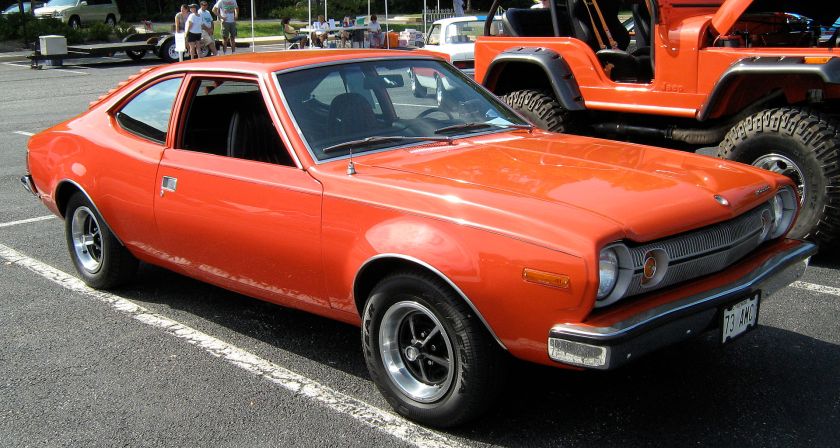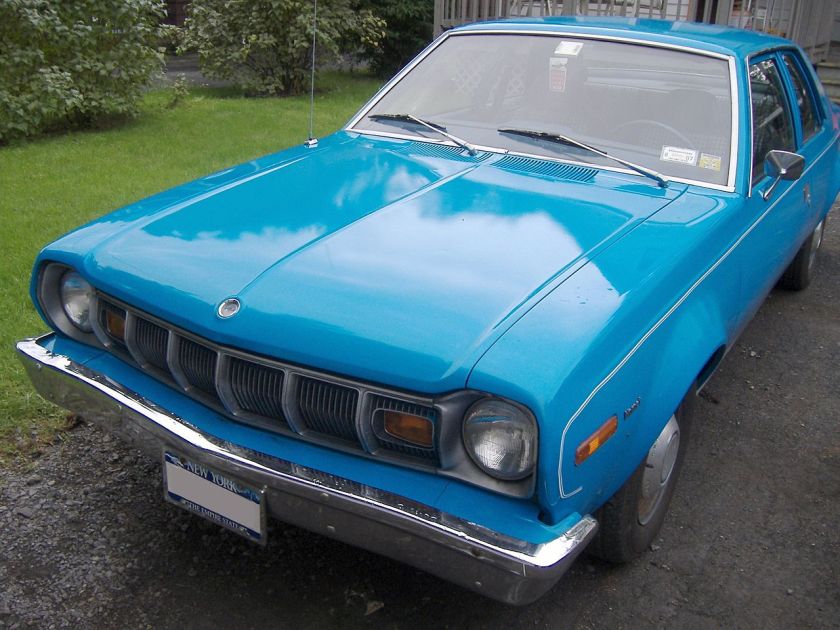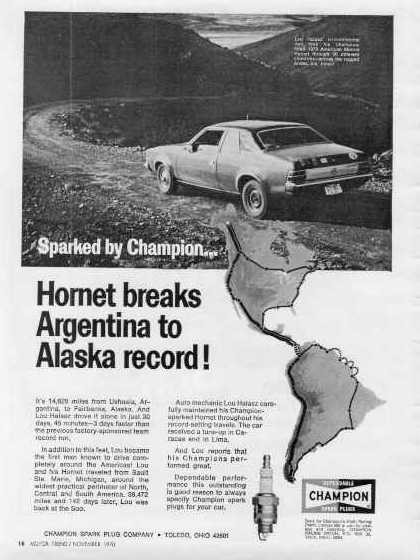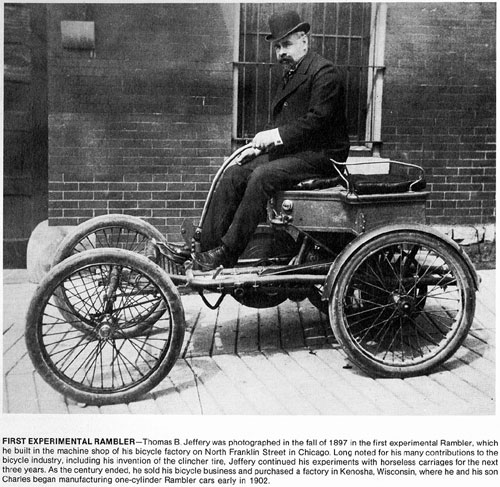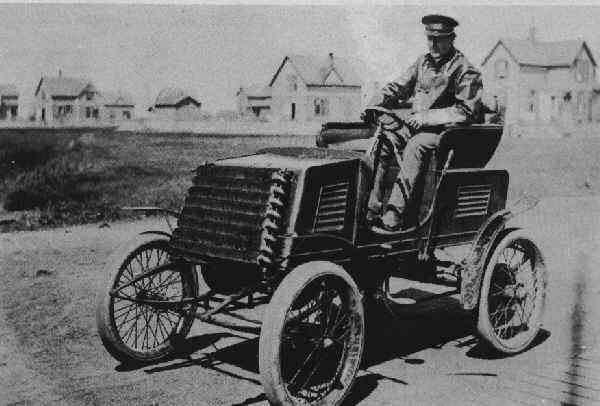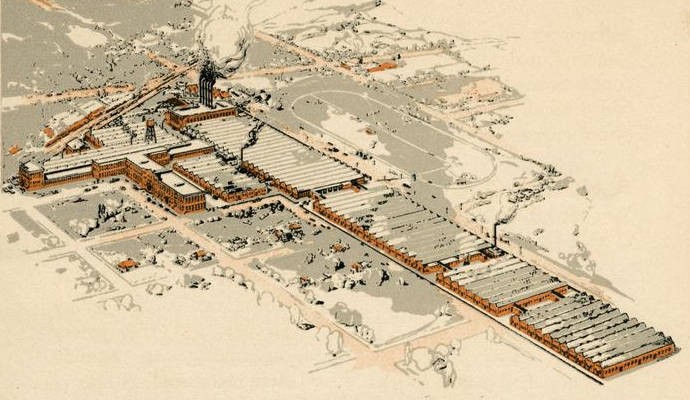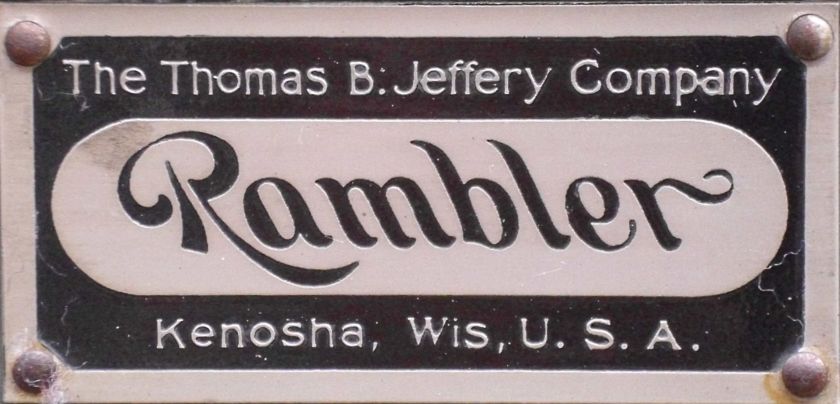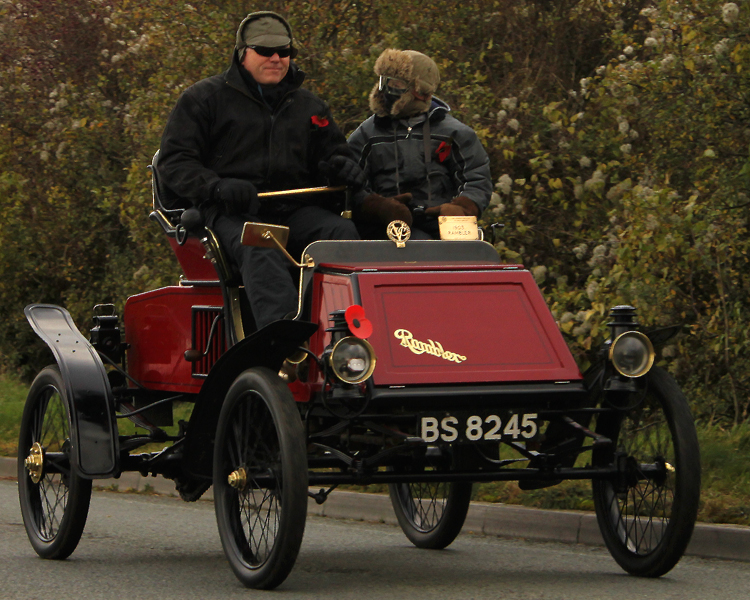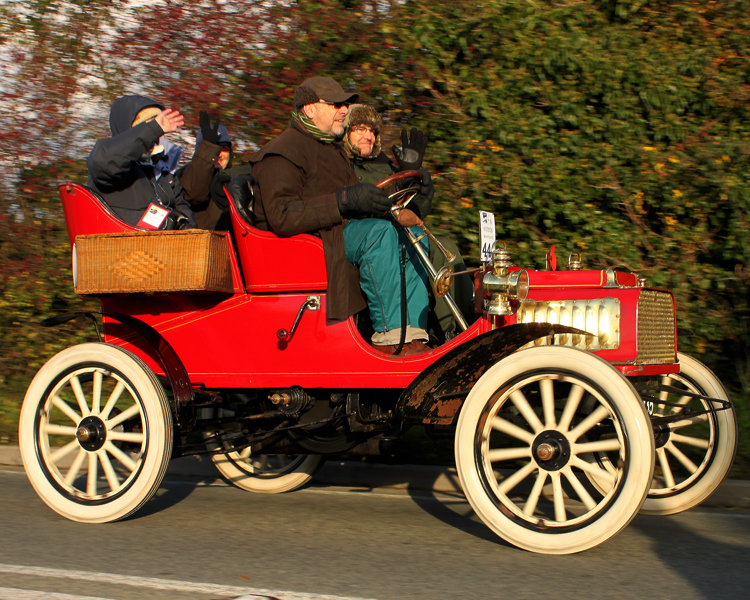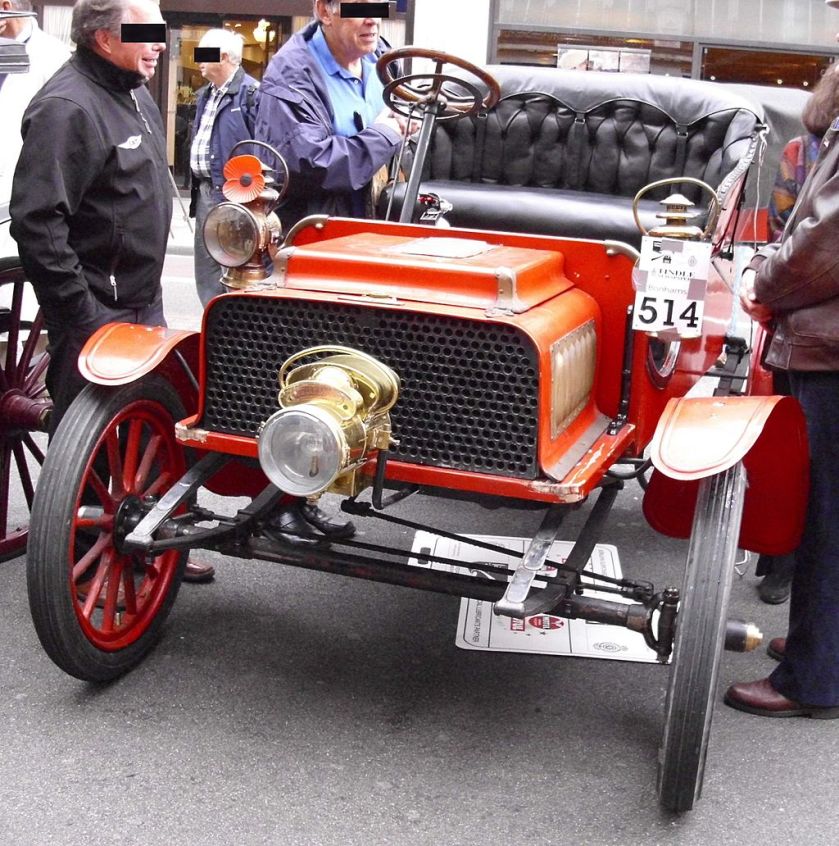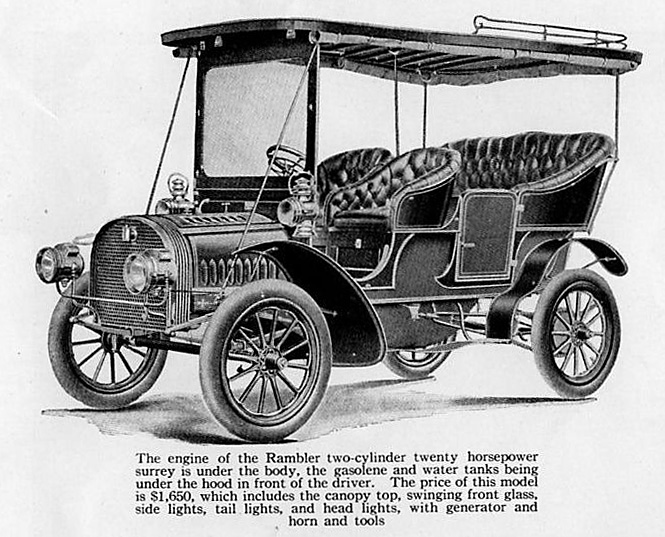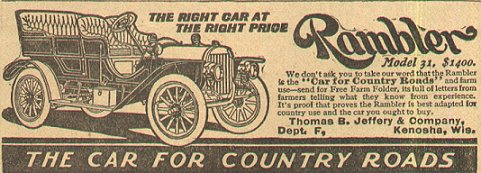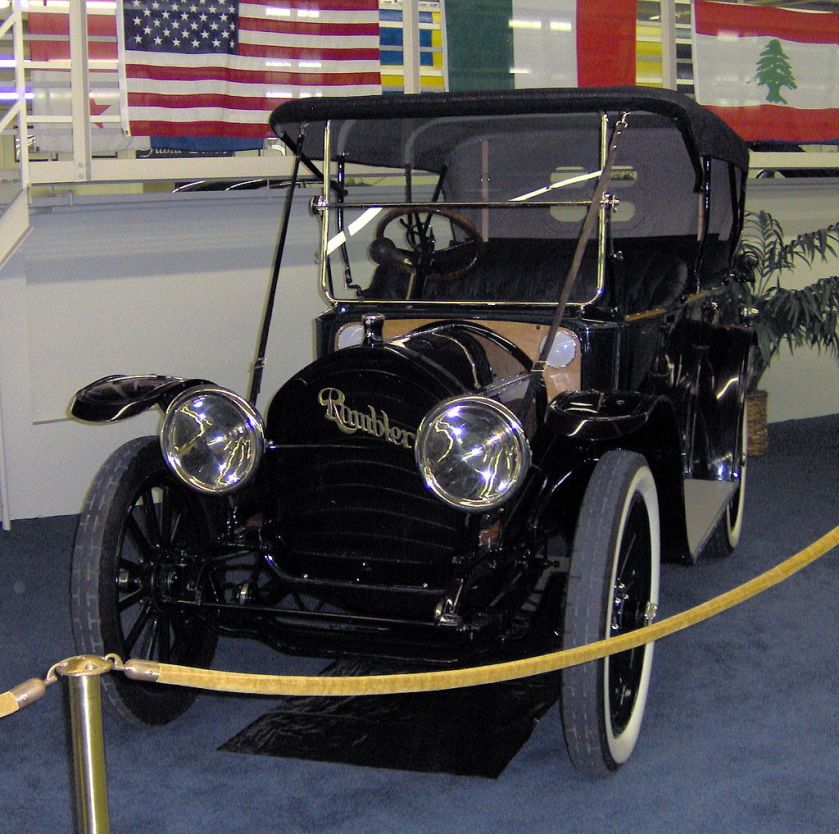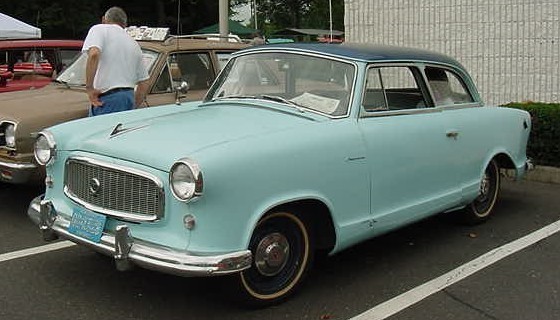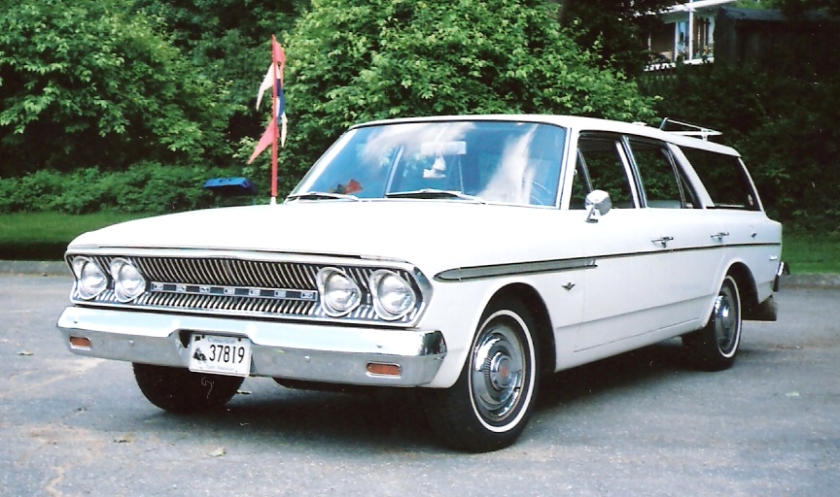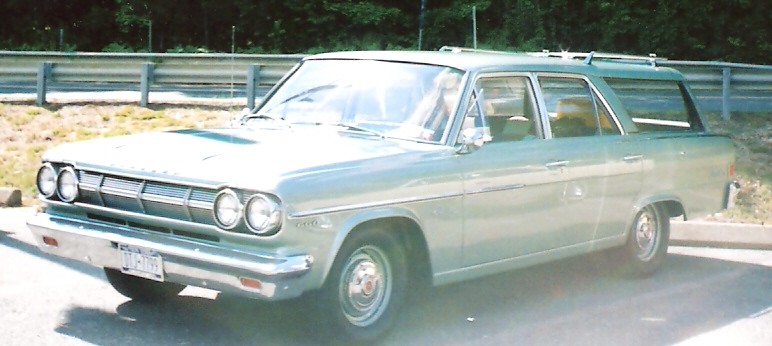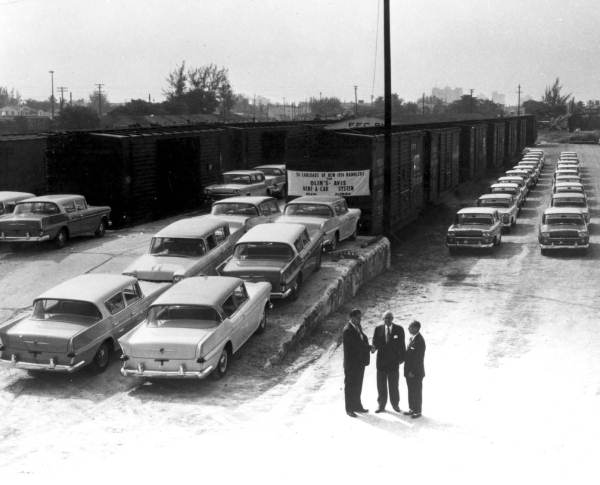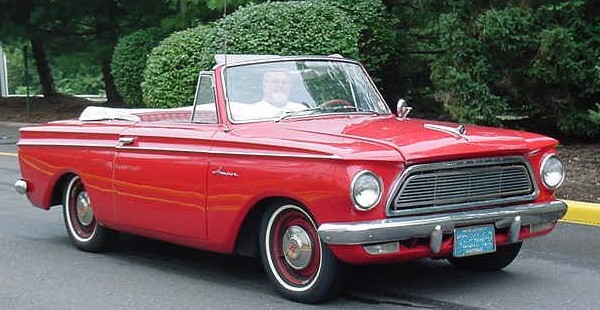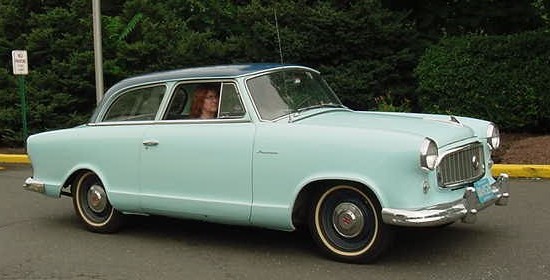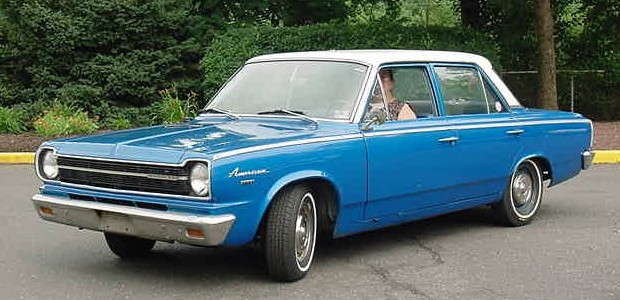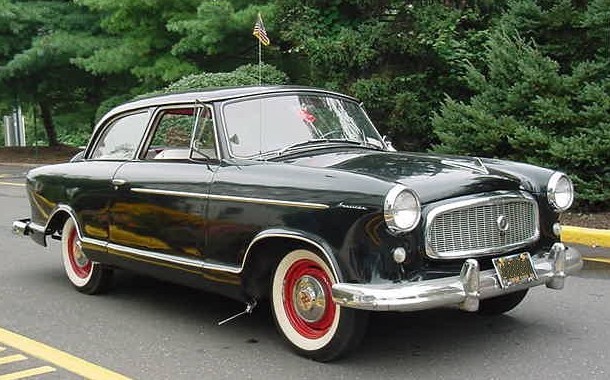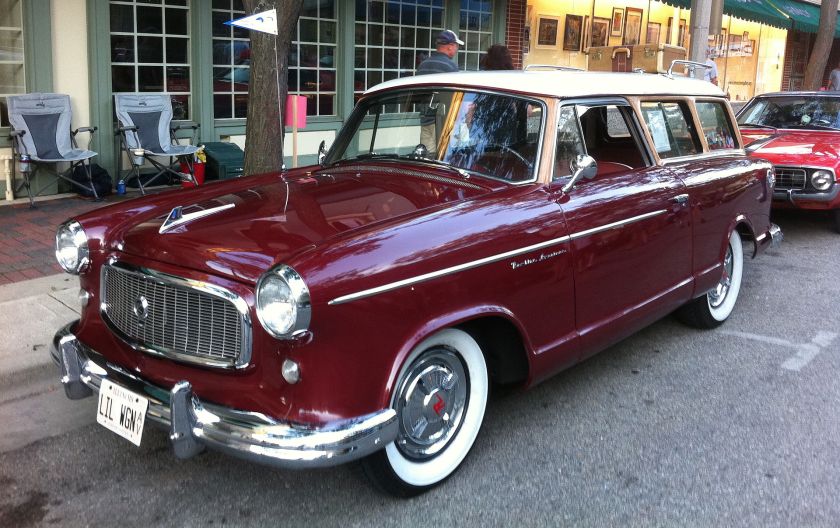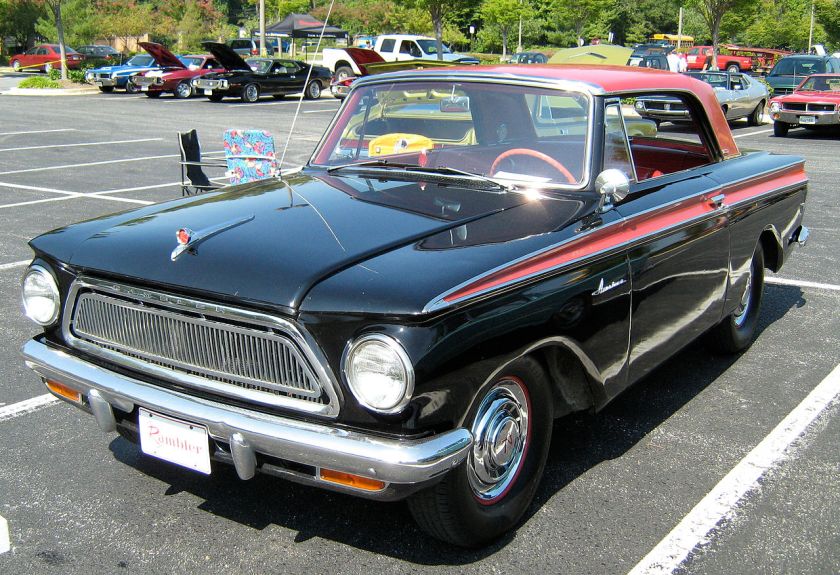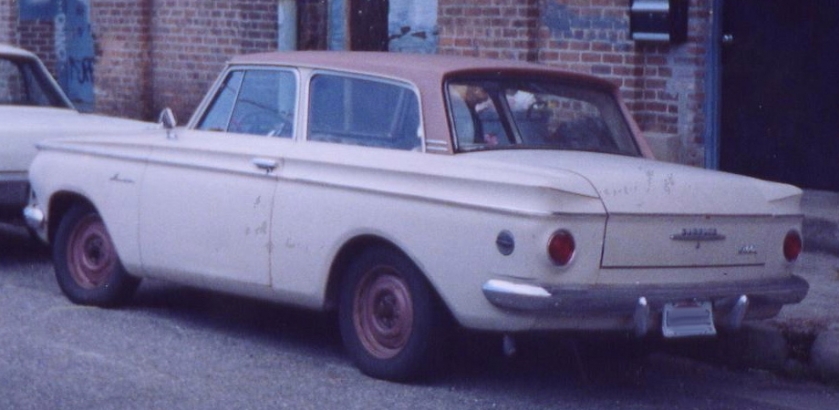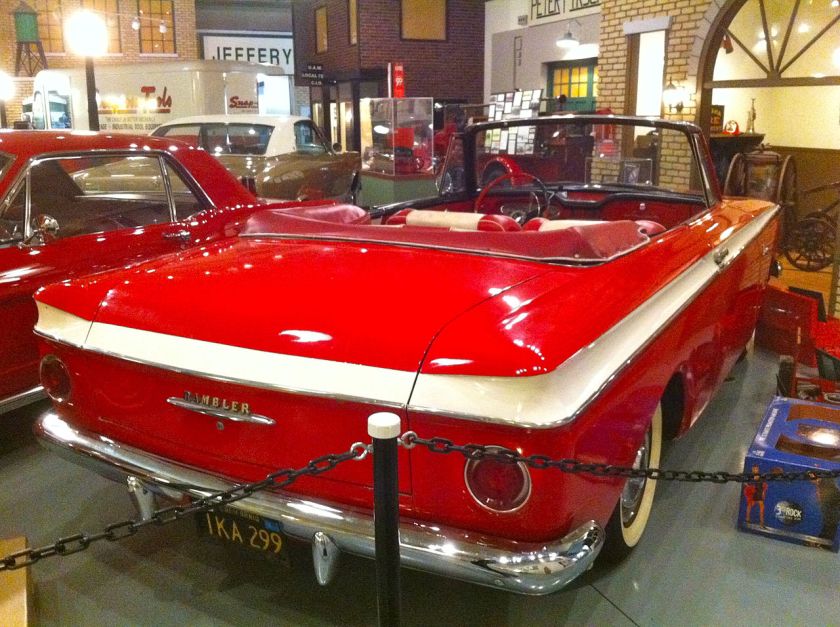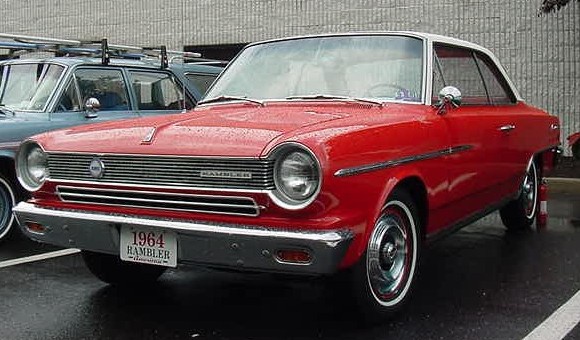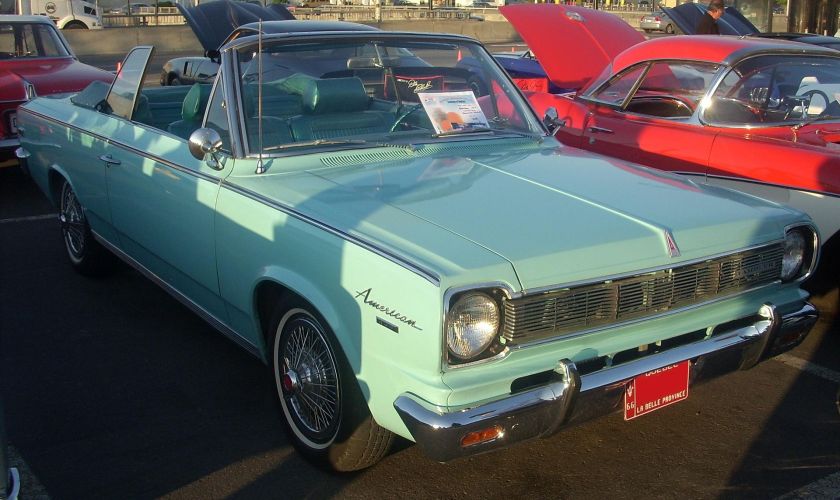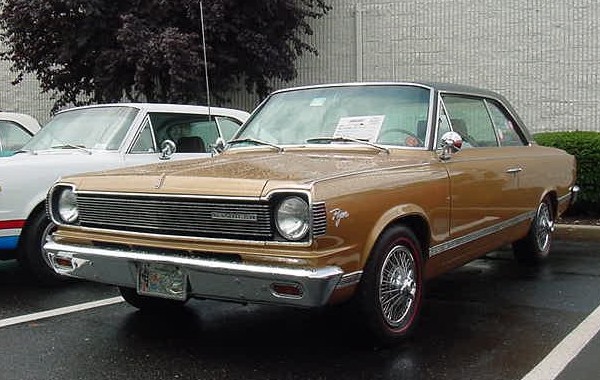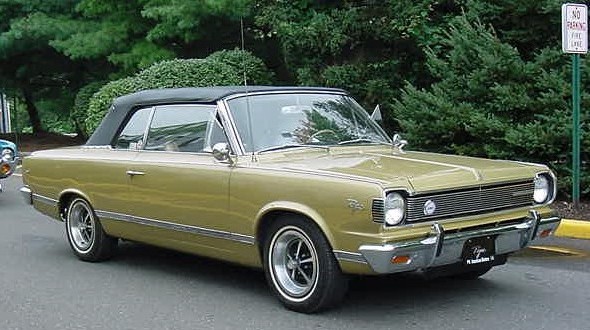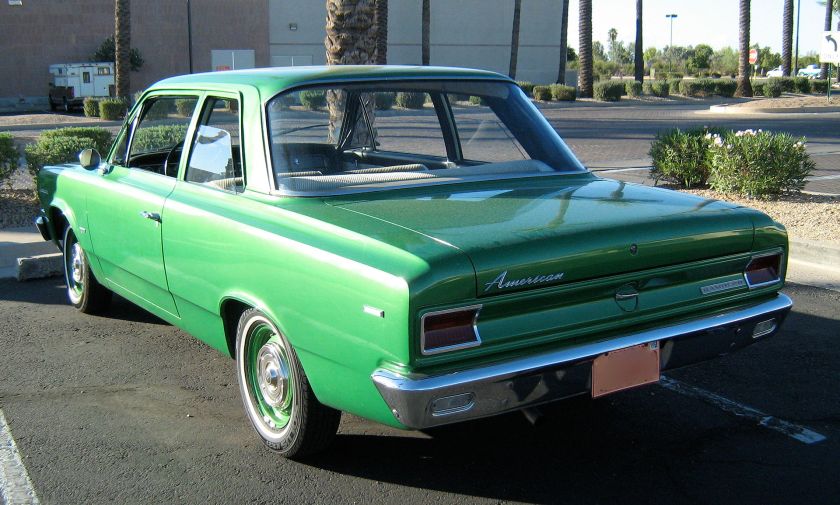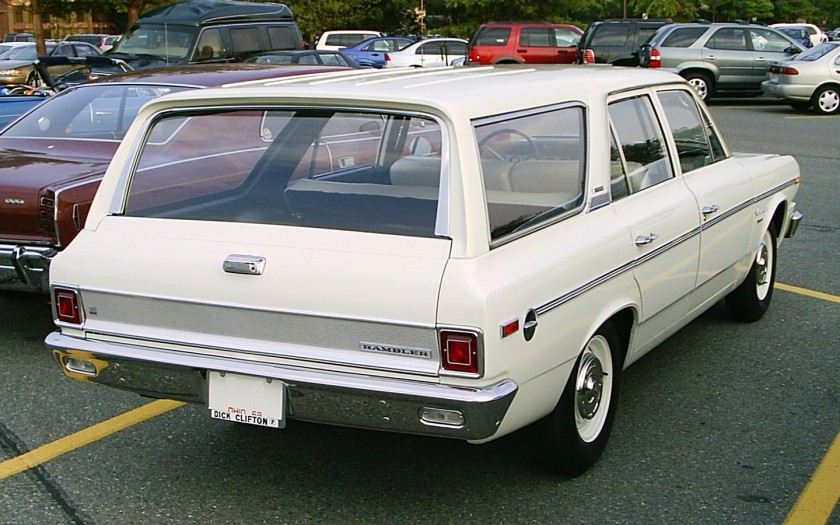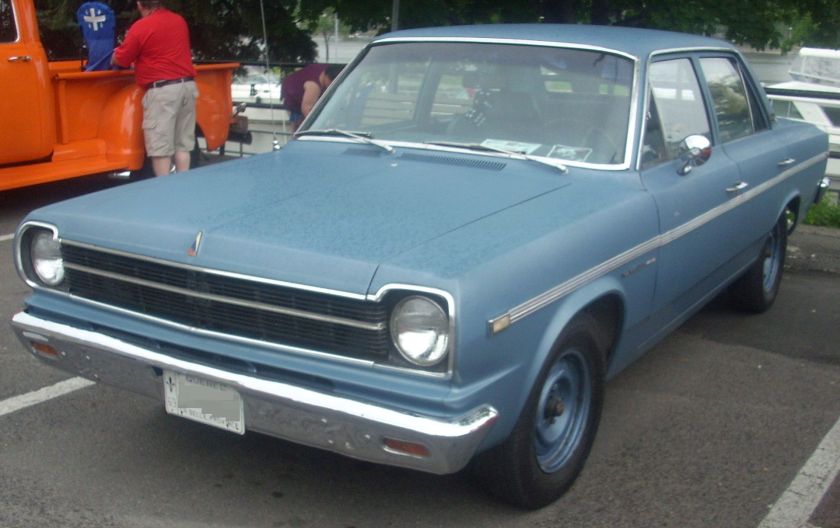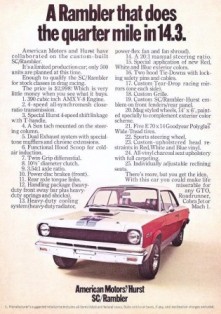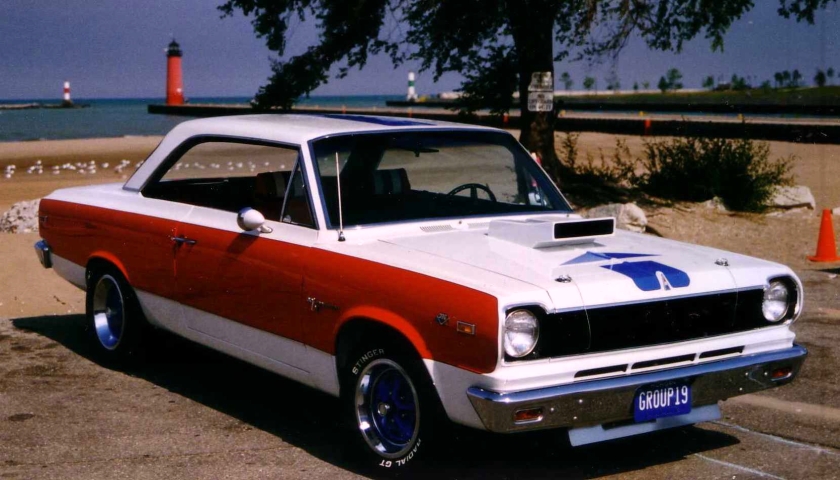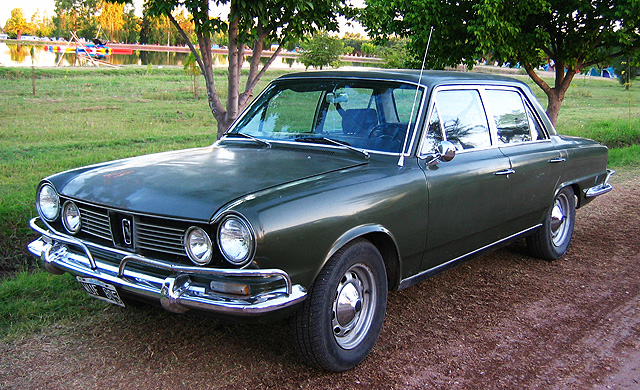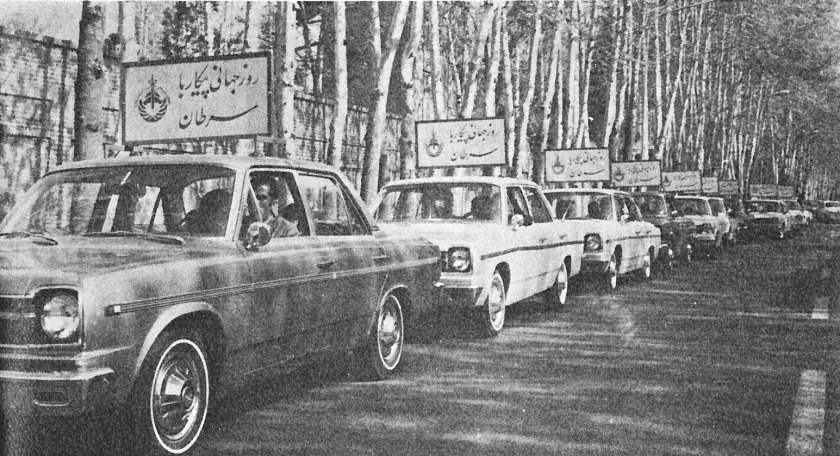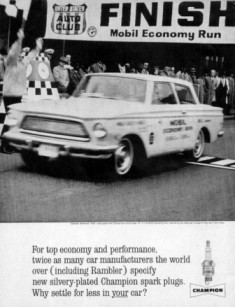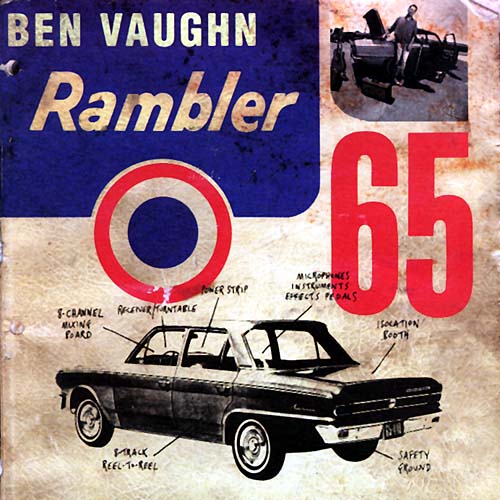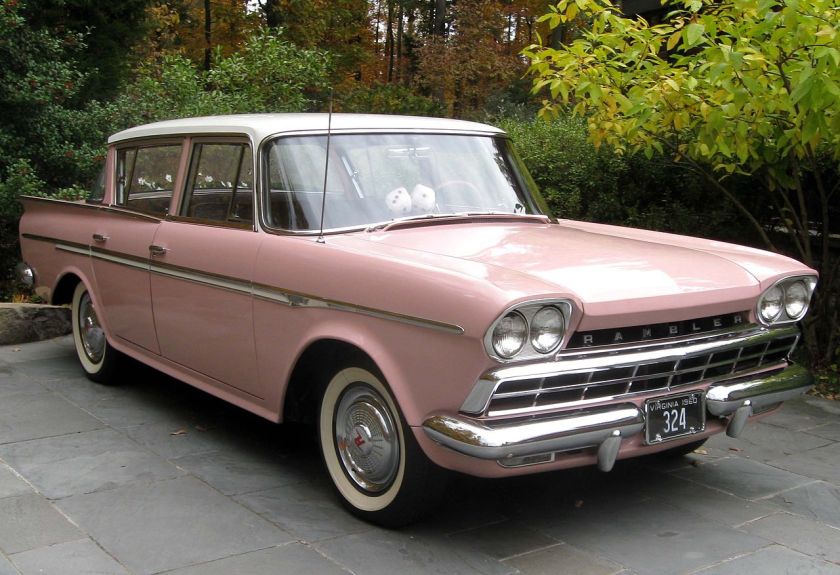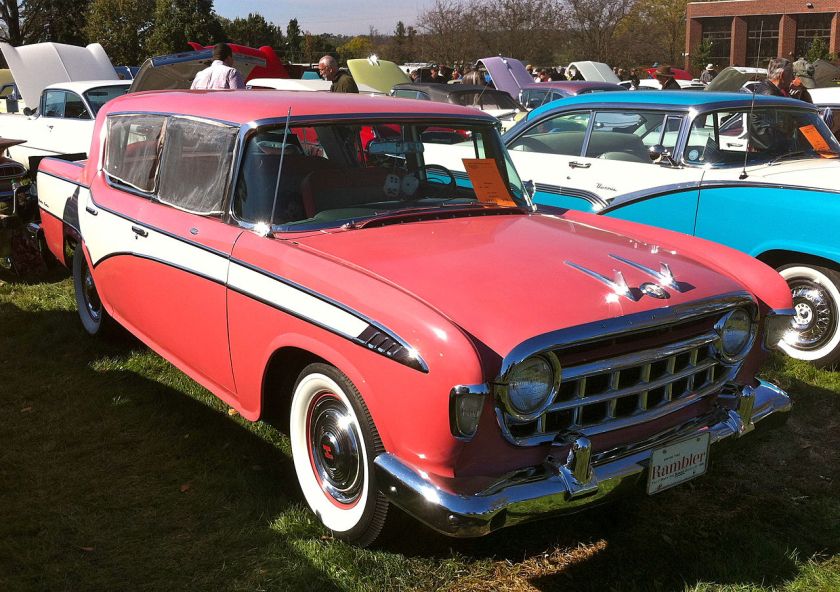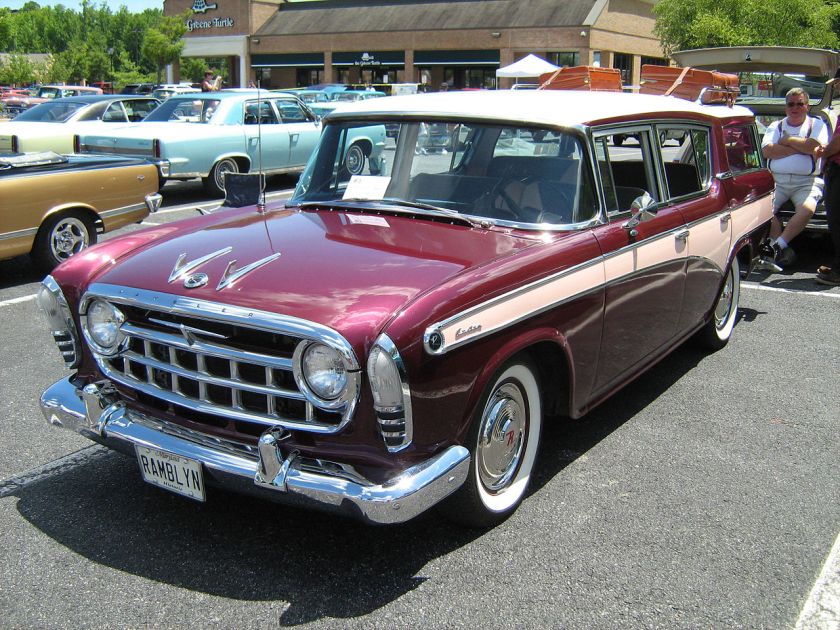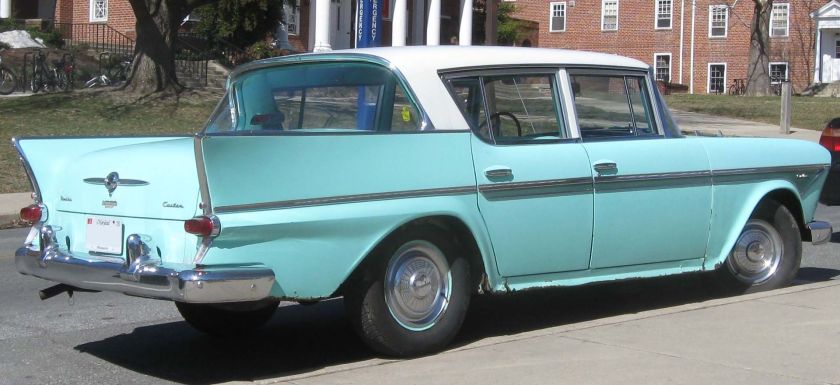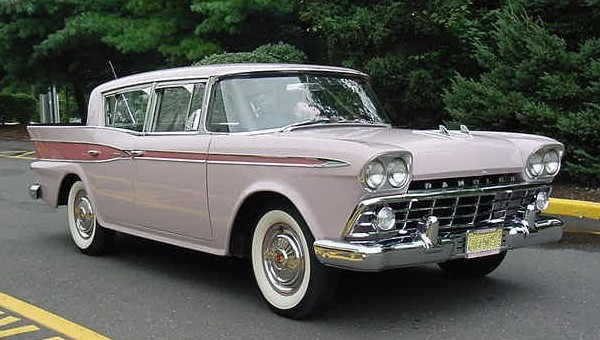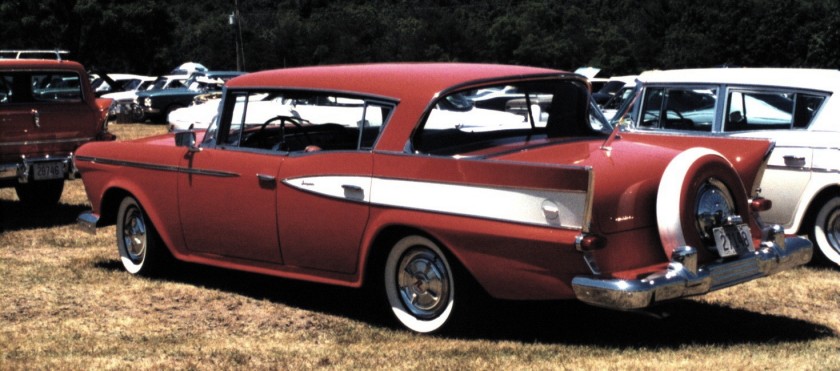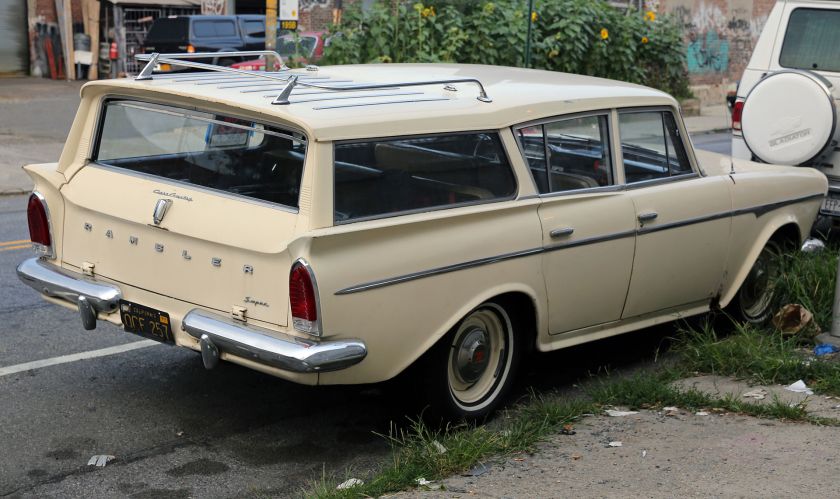1965 AMC Rambler Marlin
RAMBLER automobile Kenosha Wisconsin USA Part III
RAMBLER automobile
Kenosha Wisconsin USA Part II
for part one:
http://myntransportblog.com/2015/03/20/rambler-automobile-kenosha-wisconsin-usa-part-i/
http://myntransportblog.com/2015/03/21/rambler-automobile-kenosha-wisconsin-usa-part-ii/
for nash:
for hudson:
- Rambler Marlin: 1965
Rambler Marlin
| Rambler (AMC) Marlin | |
|---|---|
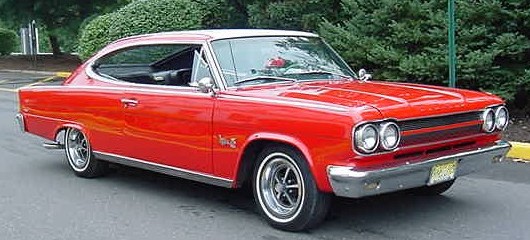 |
|
| Overview | |
| Manufacturer | American Motors (AMC) |
| Production | 1965–1967 |
| Assembly | Kenosha, Wisconsin, United States |
| Designer | Richard A. Teague |
| Body and chassis | |
| Class | Personal luxury car |
| Body style | Fastback 2-door pillarless hardtop |
| Layout | FR layout |
| Platform | Rambler Classic, AMC Ambassador |
| Chronology | |
| Successor | AMC Rebel/Matador/Ambassador |
The AMC Rambler Marlin is a two-door mid-sized fastback car made in the United States by American Motors Corporation from 1965 to 1967. A halo model for the company, it was marketed as a personal luxury car.
In ’65, the car was marketed as “Rambler Marlin”. For ’66, the car featured “Marlin” identification only, named “AMC Marlin”, as was the ’67 model.
It’s fastback roof design was previewed on the 1964 Rambler Tarpon show car, based on the compact Rambler American. 1965 and 1966 model year production Marlins were fastback versions of the mid-sized two-door hardtop Rambler Classic, and 1967 brought a major redesign in which the car was given the new, longer AMC Ambassador full-size chassis. This version had a longer hood and numerous ‘improvements’ including more interior room and new V8 engines.
Origin
As consumer per capita income increased in the early 1960s, the U.S. automobile market expanded. Whereas American Motors’ profitable marketing strategy under George W. Romney had concentrated on compact, economical cars, Romney’s successor as CEO,Roy Abernethy, saw larger, more prestigious and luxurious models as a new profit opportunity. The objective was to compete with the “Big Three” automobile manufacturers (General Motors, Ford, and Chrysler) by expanding AMC’s model lines into additionalmarket segments; particularly by developing a sporty, roomy, 6-passenger sedan that would occupy a unique niche in the market. The idea was that the new car would be a distinctive, low-volume model symbolizing a new Rambler look and spearheading a full product line. To be a distinctive competitor in the big league with the Big Three, it was decided that it should be flashy and intermediate-sized, and in an era when other automakers were stressing the power of muscle cars for their intermediate-sized image vehicles, the new model – the Marlin – was to feature comfort and spaciousness.
Initially, in response to a proposal for a sporty youth-oriented car, a four-seat fastback design study, the Rambler Tarpon, had been built on the compact-sized Rambler American platform. This was shown as a concept car at various auto shows but AMC’s current “GEN-1” V8 engine would not fit in the comparatively small Rambler chassis; also the new “GEN-II” V8 designs were still in development, and market research showed that a six-cylinder engine alone would not satisfy potential customers.
Ultimately, and in line with Roy Abernethy’s new marketing strategy, the decision was made to build the new fastback model on AMC’s intermediate-sized Rambler Classic platform. The development team, under distinguished American designer Richard A. Teague, had to work with considerably smaller budgets than their counterparts at Detroit’s Big Three to create the new Marlin. They created a large, roomy and luxurious fastback which incorporated a number of design features from the Tarpon show car. (The roof was raised over the rear passenger area when Abernethy, who was six-foot-four (193 cm tall), insisted on being able to sit in the back seat of the design studies.) As the car was targeted at the evolving “personal luxury” segment, its long list of standard equipment was supplemented by numerous options that enabled buyers to personalize their Marlins.
1965
| First generation | |
|---|---|
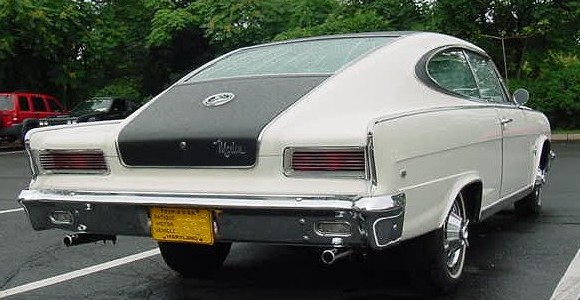 |
|
| Overview | |
| Also called | Rambler Marlin (1965) AMC Marlin (1966) |
| Production | 1965–1966 14,874 built |
| Body and chassis | |
| Class | mid-size personal luxury car |
| Related | Rambler Classic |
| Powertrain | |
| Engine | 232 cu in (3.8 L) 155 hp (116 kW; 157 PS) I6 2-bbl 287 cu in (4.7 L) 189 hp (141 kW; 192 PS) V8 2-bbl 327 cu in (5.4 L) 250 hp (186 kW; 253 PS) V8 2-bbl 327 cu in (5.4 L) 270 hp (201 kW; 274 PS) V8 4-bbl |
| Transmission | 3-speed manual 3-speed with overdrive “Twin-Stick” on console (1965) 4-speed manual (1966) 3-speed automatic 3-speed “Shift-Command” on console |
| Dimensions | |
| Wheelbase | 112 in (2,845 mm) |
| Length | 195 in (4,953 mm) |
| Width | 74.5 in (1,892 mm) |
| Height | 53 in (1,346 mm) |
| Curb weight | 2,992 lb (1,357 kg) V8 |
Launch
American Motors billed the Marlin as a new addition to the company’s self-styled “Sensible Spectaculars” model line. Backed by extensive advertising and merchandising, the car was officially announced on 10 February 1965, and unveiled in Rambler dealer showrooms on 19 March.
New car introductions, more significant in the 1960s than today, were often accompanied by special invitations and heavy publicity. The Marlin was advertised in 2,400 newspapers on its launch day, and American Motors’ news releases positioned it as aimed at buyers wanting a sporty fastback that was also roomy and comfortable. This contrasted it with the smaller Barracuda and Mustang fastbacks that had arrived a year earlier. AMC’s first model following the muscle car launches of the 1960s, the Marlin was intended to outflank competitors as a product they did not offer – a strategy now called “niche marketing“.
It followed signature design features of the Ford Galaxie “Sports Roof”, the Plymouth Barracuda, the Mustang 2+2, and the 1965 fastback models from General Motors, including the Chevrolet Impala “Sport Coupe” versions. A book on American muscle cars says V8-powered Marlins provided appropriate performance for the streamlined appearance.
Press reaction
The new model met with a mixed reception in the press. Popular Mechanics magazine recorded 0 to 60 mph in 10.8 seconds by manually shifting the automatic transmission, and fuel economy of 18.14 mpg-US(12.97 L/100 km; 21.79 mpg-imp) at a steady 60 mph (97 km/h). Tom McCahill‘s road test in Mechanics Illustrated recorded 0 to 60 mph in 9.7 seconds with the 327 engine.
Motor Trend magazine found the Marlin well balanced and said it added to the market’s various personal performance sports cars. The San Francisco Chronicle praised it and noted effortless cruising at 80 mph (129 km/h).” Hot Rod magazine, which described the car as “weirdly attractive”, ran the quarter-mile in 17.43 seconds at 79 mph (127 km/h) with the 327 cu in (5.4 L) and “Flash-O-Matic” transmission.
The Marlin emphasized the stretched-out hardtop (pillar-less) roofline that followed the contemporary styling vogue. Automobile Quarterly magazine thought the car very ugly and expressed dislike for the inadequacy of the rear-view window, the positions of the steering-wheel and stoplights, the softness of the front seats, and the design of the pedals.
Designer reaction
Vincent Geraci (who became chief of product design and product identity at Chrysler after AMC’s buyout), viewed the Marlin as “an exciting program … We took a 1965 body design and turned it into a sportier version. But enlarging the car from its original concept [the Tarpon] and raising the roof produced an adverse effect on overall appearance.”
Bob Nixon (who after AMC’s buyout in 1987 became Jeep‘s design chief at Chrysler) dismissed the project as an “ugly embarrassment” and said that the assignment to create a sporty fastback on the Classic platform was “like trying to build a Corvette on a Buick sedan body. It just doesn’t work.”
Carl Cameron, designer of the original Dodge Charger, named the Marlin as the only competition for his 1966 car even though, he said, the Marlin lacked some of the Charger’s features and it was “very different”. Contrary to the view that the Charger was a “clone” of the Marlin, Cameron said that the starting-point for his design was the fastback 1949 Cadillac, and that any similarity to the Marlin was coincidental. He added that as a result of the exceptionally tall Abernathy’s insistence on being able to sit in the Marlin’s back seat, “those cars had big squared-off roofs” whereas the Charger’s roof treatment was “rounded off, much more pleasing to the eye.”
Vehicle appointments and options
Standard features, which focused on comfort and luxurious appearance, included deluxe exterior trim, individual reclining front seats, front and rear center armrests when bucket seats were selected, and interiors from AMC’s two-door Ambassador model, including dashboard and instrument panel. On the Marlin, the dashboard was trimmed with engine-turned aluminum. Interior door panels were finished with carpeting and stainless steel trim, when many cars at the time had cheaper stamped vinyl glued to cardboard. Retractable front seatbelts where optional. The reclining bucket seats could be ordered with headrests. The Marlin was also one of the first American automobiles with front disc brakes (four-piston design, by Bendix) as standard. It had drum brakes without servo assistance on the rear.
A total of 2,005 Marlins were built with the smallest engine option, a 145 hp (108 kW; 147 PS) 232 I6. The AMC-designed 270 hp (201 kW; 274 PS) 327 cu in (5.4 L) 4-barrel V8, often paired with an automatic transmission that had the shifter in a floor console, accounted for 42% of total production, while less than 6%, regardless of engine option, had the innovative “Twin-Stick” manual transmission (with overdrive). The center console-mounted controls offered one longer stick for the regular gears, with a second shorter lever for overdrive selection. It can be shifted as a 5-speed: from 1st to 2nd, to 2nd+OD, to 3rd, to 3rd+OD. Other options included “Solex” tinted glass (70% of production), power steering, heavy-duty suspension, “Twin-Grip” limited slip differential, air conditioning, adjustable steering wheel, power windows, and a choice of AM radio or an AM/FM monaural unit (50% of production) with “Duo Costic” rear speaker and “Vibra Tone” system to simulate stereophonic sound (stereo broadcasting was not yet widely available in the U.S.). Only 221 Marlins were built without a radio. Wide-ranging interior colors and upholstery choices were available, and options for the exterior, including accent colors for the roof and side window trim, enabled further customization.
Pricing and sales
The MSRP price was US$3,100 (US$23,199 in 2015 dollars), compared with $3,063 for a bench seat (six-passenger) version of the Rambler Classic 770 2-door hardtop, which did not have the extra features and luxurious interior of the Marlin. 10,327 Marlins were sold in the abbreviated first year of production.
1966
The Rambler Marlin became known as the AMC Marlin starting with the 1966 model year. All references to the historic Rambler brand name were removed from the car and promotional materials. This was part of Roy Abernethy’s remake of AMC’s corporate identity, divorcing the larger car lines from the Rambler brand and the economy compact car image. The other changes were minor (e.g. a slight modification to the extruded aluminum grille, a front sway bar made standard on six-cylinder models, and an optional black vinyl roof cover that continued over the trunk opening). New was an electronic tach on the top of the dash.
The year also saw the introduction of the fastback Dodge Charger, a derivative of the intermediate-sized Dodge Coronet, and a sporty model in direct response to the Marlin. Together, the Charger and Marlin were “unusual, distinctive and in a class by themselves.” General Motors and Ford also positioned products similar to the Marlin as specialized “personal luxury” coupes and introduced 2-door fastback versions of their full- and intermediate-sized car lines.
AMC broadened the car’s market appeal by lowering the base price to US$2,601 (US$18,906 in 2015 dollars) and offering more options. For example: high-level trim packages that had previously been standard, as well as the availability of a floor or center console mounted 4-speed manual transmission and a dash-mounted tachometer, affected small changes in pricing and equipment that paralleled the competition. By comparison, Chrysler did a similar thing with the pricing and content of its Dodge Charger from the 1966 to the 1967 model years. Despite these changes, Marlin production fell to 4,547 in 1966.
Popular Science magazine road test comparison of three 1966 sporty fastbacks (Ford Mustang, Plymouth Valiant, and AMC Rambler) highlighted the Marlin’s quiet interior, high quality upholstery and positioned seats with adjustable backrests that “permit almost any driver to find an ideal seat-to-wheel-to-pedal relationship”, as well as the “best-balanced ride on good roads and bad”. The 287 cu in (4.7 L) two-barrel V8 engine with the three-speed automatic achieved 0 to 60 mph in 11.7 seconds, and was the quietest, but least responsive of the group. The test Marlin’s standard drum brakes were criticized as inadequate, with the authors recommending the optional disk brakes.
1967
| Second generation | |
|---|---|
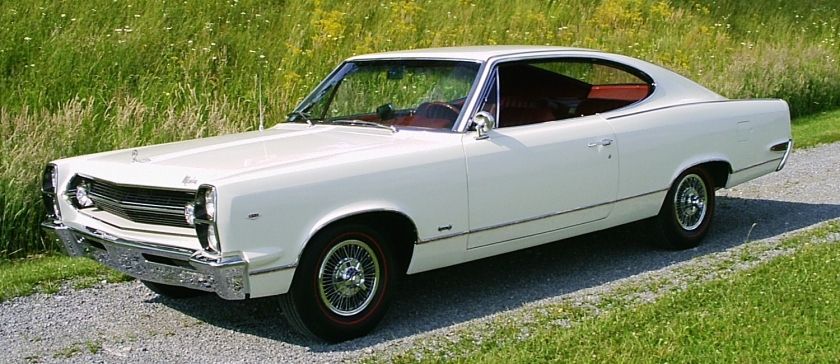 |
|
| Overview | |
| Production | 1967 only 2,545 built |
| Body and chassis | |
| Class | full-size personal luxury car |
| Related | AMC Ambassador |
| Powertrain | |
| Engine | 232 cu in (3.8 L) 155 hp (116 kW; 157 PS) I6 2-bbl 290 cu in (4.8 L) 200 hp (149 kW; 203 PS) V8 2-bbl 343 cu in (5.6 L) 235 hp (175 kW; 238 PS) V8 2-bbl 343 cu in (5.6 L) 280 hp (209 kW; 284 PS) V8 4-bbl |
| Transmission | 3-speed manual 3-speed with overdrive 4-speed manual 3-speed automatic 3-speed “Shift-Command” onconsole |
| Dimensions | |
| Wheelbase | 118 in (2,997 mm) |
| Length | 201.5 in (5,118 mm) |
| Width | 78 in (1,981 mm) |
| Height | 53 in (1,346 mm) |
| Curb weight | 3,342 lb (1,516 kg) V8 |
The Marlin was larger and more expensive for the 1967 model year. It was now built on AMC’s completely redesigned 118 in (2,997 mm) wheelbase “senior” platform, i.e. the AMC Ambassador chassis. The retooling for 1967 design changes that were mostly to the “senior” line of AMC cars (Ambassador, Marlin, Rebel) cost $35 million. (US$ 254,405,128 in 2015 dollars) The overall length of the new Marlin’s body increased by 6.5 inches (165 mm) with more rear seat legroom, as well as being wider resulting in 2.2 inches (56 mm) of additional interior room, but in the process the car gained 350 pounds (159 kg) compared to the previous models.
Making the Marlin larger was a design requirement in anticipation of the 1968 entry of the compact-platform based Javelin. Also the longer, wider car would improve product differentiation among AMC’s various model lines. Motor Trend magazine compared two “Sporty Specialties” – the 1967 AMC Marlin and Dodge Charger – concluded that both are “caught in the middle” because “neither has the compactness of the basic sports-personal archetypes such as the Mustang or Camaro, nor the posh elegance to social climb” to the models such as the Cadillac Eldorado or Buick Riviera. Rather, “both aim at the driver who wants a sporty-type car, but who doesn’t want to give up room and comfort and isn’t ready to move into more expensive category.” The 1967 Marlin was part of the “cool” car sales pie that featured sporty cars with “the popular fastback silhouette”.
The Ambassador chassis allowed for a longer hood that harmonized better with its fastback rear end, and the body was given a less angular appearance. A bright trim strip from the door opening to the rear bumper accentuates the slightly kicked-up “coke bottle” profile of the rear fenders. The front end shared the Ambassador’s protruding, vertically stacked headlights and an all-new recessed extruded aluminum grille with horizontal bars that bowed forward in the center. The grille was a black anodized version of the twin (parking and turn-signal) “rally light” grille on the Ambassador DPL models. The hood ornament was redesigned, with a small chrome marlin fish set in clear plastic inside a chrome ring.
The main feature was the Marlin’s fastback roof with “stylish elliptical C-pillars that ended “between two stubby, squared-off fins” in the rear. The decklid was the same as on the previous model, but now without the large round insignia. A bigger back window improved rear visibility. New taillights were similar to those on the first-generation car. The rear bumper was slightly different from the one used on the Ambassador and Rebel station wagons, the top edge being a continuous horizontal line that fits up against the body.
Teague said the 1967 car was ‘the best-looking Marlin we built.’ Motor Trend magazine described the all-new styling of AMC’s new full-size cars as “attractive” and “more graceful and easier on the eye in ’67.”
The second-generation Marlin did not have its own catalog, but was described within the large Ambassador sales brochure. The Ambassador’s standard features and options also came on the Marlin. The interiors continued to offer premium materials and fittings, including wood-grain trim, and were the same as on the Ambassador 990 and DPL two-door hardtop models (with the exception of the “Custom” package that had two matching pillows) that “rival more expensive cars for luxury and quality, yet are durable enough to take years of normal wear.” Many Marlins were ordered with the reclining buckets seats that not only featured a center armrest between them (with a center cushion for a third occupant or a floor console with gear selector), but also a foldaway center armrest for the rear seat. The interior design was new and featured a safety-oriented dashboard with the instruments and controls grouped in front of the driver, while the rest of the dash was pushed forward and away from the passengers. Protruding knobs and controls were eliminated from any area that the passenger or driver could strike them. The steering wheel was smaller than used before and the column was now designed to collapse under impact. A new lane change feature was made standard for the turn signal.
An entirely new family of V8 engines was offered. The six-cylinder was still available, but rarely ordered -only 355 were built. The base V8 was the 290 cu in (4.8 L) with a 2-barrel carburetor, while a pair of 343 cu in (5.6 L) V8s were optional: a 2-barrel that ran on regular-fuel, as well as a high-compression (10.2:1) premium-fuel version with a 4-barrel carburetor and dual exhaust that produced 280 hp (209 kW; 284 PS) at 4800 rpm and 365 pound-feet (495 N·m) of torque at 3000 rpm. An entirely new four-link, trailing-arm rear suspension system was introduced eliminating the previous torque tube design.
Motor Trend magazine’s road test of the Marlin with the 343 engine reported zero to 60 mph in 9.6 seconds, and ran a 17.6-second quarter mile at 82 mph (132 km/h) with two passengers aboard, which was comparable to the performance of a Dodge Charger with a 383 cu in (6.3 L). Fuel economy with the 280 hp V8 averaged 15.3 mpg-US (15.4 L/100 km; 18.4 mpg-imp) city and 17.6 mpg-US (13.4 L/100 km; 21.1 mpg-imp) highway, while with the 155 hp straight-six the big Marlin averaged 17.3 mpg-US (13.6 L/100 km; 20.8 mpg-imp) city and 20.4 mpg-US (11.5 L/100 km; 24.5 mpg-imp) highway. The Marlin “also handled well” and featured reclining seats that are “well worth the extra $44.65 to anyone who travels long distances.”
Sales of the redesigned Marlin fell to 2,545. This was partly a result of customers’ diminishing confidence in the financial health of the automaker under Abernethy’s leadership, and partly confusion caused by AMC’s move away from its loyal “economy” customer market segments into segments dominated by the domestic “Big Three” (GM, Ford, and Chrysler). Furthermore, buyers did not turn to the “family”-sized fastbacks. Therefore the Marlin ceased production at the end of the 1967 model year.
Racing
The Marlin “was an overlooked performer on the muscle car landscape”, yet it was campaigned without factory support in motorsport venues. Roy Abernethy had instituted a prohibition on automobile racing and he was opposed to corporate sponsorship of activities that glamorized speed and performance. While the Big Three automakers in the U.S. were focusing on high performance during the early 1960s, AMC ran advertising that said: “Why don’t we enter high-performance Rambler V-8s in racing? Because the only race Rambler cares about is the human race.” Nevertheless, the 1965 Marlin was an attempt to attract younger customers. The Marlin was promoted as an image-breaking model and AMC dealerships began sponsoring Ramblers in auto racing.
Dragstrip
Preston Honea achieved drag racing fame with the “Bill Kraft Rambler”. The effort began in 1964 when the Bill Kraft Rambler dealership had installed a highly modified AMC Ambassador V8 engine (the 327 V8 bored out to 418 cu in (6.8 L), four carburetors, special intake manifold) in a 1964 Rambler that ran 112 mph (180 km/h) at the Fontana dragstrip. For the 1965 season, Kraft built a new “Bill Kraft Rambler”, this time a fastback-bodied Marlin Funny Car on alcohol fuel and nitrous injection. The AMC engine was replaced by a Plymouth Hemi. On its first time out, the Hemi-powered car ran a 10.31-second quarter mile at 138 mph (222 km/h).
Oval
Roy Haslam, a 1999 inductee to Victoria Auto Racing Hall of Fame, raced his AMC Marlin Super Stock (image) in Canada and the U.S. He won the July Cup and was 3rd in the season point championships.
Endurance
Brothers Larry and Don Hess raced a Marlin in the 1966 24 Hours of Daytona. Sponsored by Queen City Rambler, a Charlotte, North Carolina AMC dealership, the car ran almost stock, even a with radio antenna. The passenger seats were removed, a roll bar installed, and the factory exhaust system replaced with open headers that exited below the doors. The Marlin retired after 80 laps with overheating and steering problems, and was reportedly sold as a used car after the race.
Special versions
American Motors designers and stylists made two operational show cars. Both used the platform of the first generation Marlin and promoted Rambler’s new emphasis on luxury and glamour.
- The Black Marlin toured the 1965 auto shows along with attractive young women in sailors’ outfits. It was finished in black with “a sleek and stylish interior.”
- The Tahiti luxury version toured the shows in 1966, starting with the North American International Auto Show in Detroit. It was finished in a brilliant fireflake blue with “bright South Seas floral upholstery”, and matching throw pillows.
A design experiment in 1966 was the manufacture of a first-generation Marlin with the front end of the Ambassador.
The Marlin II essentially foretold the switch to the longer wheelbase platform that occurred for the 1967 model year. The car was used by Richard Teague, and was sold in 1967.
George Barris customized a 1966 Rambler Marlin for Rader, a wheel manufacturer, to use for promotion. The car was repainted Candy Red with powdered gold leaf in the clear coat, and had Rader wheels with “thick wall” tires, a reworked mesh grille with four rectangular Cibié headlamps, and Black Pearl Naugahyde on the trunk. Later Barris worked with AMC to produce dealer-installed customizing kits for the AMX.
The roof was cut off a 1966 Marlin for the Florida Marlins, a professional baseball team based in Miami Gardens, Florida. With no seats except for the driver, the car was used in parades and on-field ceremonies at Pro Player Stadium and transported the team’s mascot “Billy the Marlin” for the fans to see during the ball club’s 1997 world championship season.
Legacy
New market segments
The intermediate-size fastback car was not a big hit in the marketplace. However, “there were many who welcomed the new breed of mid-size fastbacks as a breath of fresh air.” According to Consumer Reports, these cars defied “the usual guidelines to size and price class, and they cannot be measured against any standard”.
The Marlin had low sales overall but generated publicity and excitement, attracting potential customers to AMC dealers and creating sales opportunities for other models. American Motors’ claim to fame was as a maker of economical and undistinguished compact cars and the publicity and interest generated by the Marlin’s rather radical design facilitated a shift in public opinion about the automaker, as well as the contribution margin to the company’s sales. The Marlin’s first-year sales helped generate a profit of US$5.2 million (US$ 38,914,889 in 2015 dollars) for AMC in fiscal 1965, despite a three-week strike by the United Auto Workers.
The mid-sixties automobile market in the U.S. was marked an increasing influence of younger buyers who wanted a sporty image. Most of the “sportiness” of these was due to effective marketing. No longer satisfied with “standard” cars the market moved into new segments that included muscle models and personal-luxury cruisers. Many were heavily restyled derivatives of volume models and shared common parts. Moreover, they were image builders and big profit generators for their automakers. The objective of the Marlin was to move AMC in this direction. However, the AMC “had an established image as an expert in the small-car field”, and thus faced problems in marketing the Marlin as a sporty big car. Moreover, “the Marlin actually represented a double leap” for AMC: into performance, as well as personalization. The model had a good start, but sales quickly bottomed out in the 1967 model year. The automaker’s anti-racing philosophy turned around after $40 million (US$ 290,748,718 in 2015 dollars) was spent to develop a new V8 engine family and AMC turned to “competitive events as a means of knocking down its avidly gathered reputation for economy.”
Although the Marlin was discontinued in 1967, it paved the way for a successful replacement—the compact 1968 AMC Javelin. Therefore, the Marlin’s introduction in 1965 can be viewed as stopgap marketing move by AMC, influenced by the company’s lack of a V8 engine at that time to fit the compact Rambler chassis. As a mid-sized car, the Marlin was not a dashing, affordable pony car, and after three years of production, it would “step aside in favor of another two-door: the hip, new Javelin.”
Political connection
The Marlin was the subject of political controversy in Republican candidate Mitt Romney‘s 2002 Massachusetts gubernatorial election campaign.
In a television advertisement Romney and his wife Ann tenderly describe their first date and falling in love. Mrs. Romney recalls her husband pulling up in “some goofy-looking car” and running out of gas on the way home. Romney describes being embarrassed by the fact that in high school he drove a car that he says was “kinda awful.”
What Romney did not say in the ads was that the car was a brand new Marlin, from the company that was headed by his father, George W. Romney, from 1954 to 1962.
The rival Shannon O’Brien campaign responded that Romney “actually drove a cool car”—a “personal luxury car” according to AutoWeek magazine. The press release by the Democratic ticket chided: “…the fact that Mitt Romney was embarrassed by his brand new car shows just how out of touch with regular working people he is.”
Crossfire connection
Some of the main design components of the Marlin’s design returned in 2004 with the Chrysler Crossfire. The rear-wheel drive, two-seat sports car was developed when Chrysler was merged with German automaker Daimler-Benz (forming DaimlerChrysler) and shared most of its components with the Mercedes-Benz SLK320. The original concept car was styled by Eric Stoddard, the car was further refined by Andrew Dyson and built by the German coachbuilder Karmann. Both the Marlin and Crossfire became “known more for their rear view than their front styling.”
The new coupé displayed a fastback roof with broad rear fenders, a rear end treatment that prompted many automotive journalists to comment on the Crossfire’s resemblance to the AMC Marlin. Examples include automotive journalist Rob Rothwell, who wrote “…when I first espied the rear lines of the Chrysler Crossfire I was instantly transported back to 1965 and my favorite car of that year, the Rambler Marlin.” Automotive editor toThe Detroit News described the “distinctive boat-tail rear end that reminds more than one observer of the old Rambler Marlin.” Motor Trend also compared the “provocative boattail theme” of the 2004 Crossfire’s sheetmetal to that of the AMC Marlin. Even the handling characteristics of the Crossfire were compared by one British journalist to “a detuned 1967 AMC Marlin with locked-solid suspension.”
Collectibility
The distinctive Marlin has found a niche among old car hobbyists and collectors of historic vehicles as evidenced by the backing of enthusiasts with a single marque antique auto club. It offers information to those interested in “these uncommon and fascinating cars.” Although a relatively low-production model, the Marlin is a derivative of AMC’s higher-volume models so it shares many common parts. Vehicles in various stages of appearance and mechanical condition can be found for sale. Plusses for collectors of the 1965 model include decent performance with optional drivetrains, historical oddity, plush, bucket-seat interior, and its still low prices; while the Marlin’s “distinctive” styling, rust issues, and slow appreciation in value are minuses. The Marlin’s low production numbers also means that there “will never have too many other Marlin owners to rub elbows with.”
There are also many active local and national (U.S. and other nations) Rambler and AMC car clubs that welcome Marlins.
Scale models
A highly detailed Marlin promotional 1/25-scale model was manufactured under license from AMC by Jo-Han for the 1965 and 1966 model years. The only differences are their grilles and removal of the Rambler name on the 1966s. A friction model was also available from Jo-Han in 1966. Although available in a variety of single and two-tone color combinations, many of these “dealer promos” were done in aqua/dark blue two-tone plastic. Unwanted by AMC dealers as the 1966 model year neared its end, thousands of the models were given away to institutions such as children’s hospitals and orphan’s homes. They are now highly desirable and they command premium prices. Their value can be upwards of $200 to 400 for mint, in-the-box specimens that still have the hood ornament.
Jo-Han also produced 1/25-scale plastic kits of the 1966 Marlin, (Jo-Han C1900) and reissued it in the mid-1970s in the “U.S.A. Oldies” series (Jo-Han C-3666). They are based on the promotional models, but are less valuable today. According to Steve Magnante of Hot Rod magazine, Jo-Han appears to be poised for a comeback with its most famous unassembled model kits favoring offbeat subjects, “but save up-this stuff is pricey.”
Two types of die-cast toy models were sold under the Corgi Toy brand and manufactured by Mettoy Playcraft in the UK during the late 1960s. Both were done in 1:48 scale. One was a two-tone red and black Marlin with opening doors and a tow hook. The “Rambler Marlin Sports Fastback” (Corgi 263) scale model was released in 1966 and withdrawn from the market in 1969. In addition to the two-tone paint with chrome bumpers and grille, the model features a detailed interior finished in white and the front seat backs can be tipped forward (as in the actual cars). The second was a gift boxed set (Corgi GS10) with the Marlin finished in blue with a white roof and featuring a roof rack for a kayak, as well as towing a matching utility trailer with opening hatches. Released in 1968, this set had a short run of just 11 months.
Interchange
The following is a digest of a section in “The Marlin Handbook – 2004” prepared by the Marlin Auto Club.
First generation
Front fenders, hood, as well as front and rear bumpers are interchangeable with the 1965 and 1966 Classic. The rear bumper from 1965 and 1966 Ambassadors will interchange, as well as the dashboard, seats, and other inside trim pieces. Windshields and the doors with their side glass are interchangeable with all two-door Classic and Ambassador models.
Drive train, front and rear suspension, brakes, radiators, master cylinders, trunnions, steering columns, power steering pumps, engines, transmissions, brake drums and rotors are interchangeable with 1965 and 1966 Ambassadors and Classics. Some parts are even interchangeable back to 1958 and earlier, while other components were used by AMC into the 1970s.
The 232 cu in (3.8 L) I6 was used through the late-1970s. This engine was stroked and became the 258 cu in (4.2 L) that was used into the 1990s in Jeeps. Many engine components are shared. This engine was also upgraded into Jeep’s 4-liter workhorse. It is possible to transplant this high-output fuel-injected engine into a Marlin. (See: AMC Straight-6 engine)
The 287 cu in (4.7 L) and 327 cu in (5.4 L) V8s started out in 1956 and 1957 and were used in large Ramblers, Classics, and Ambassadors through 1966. The AMC 327 engine continued to be used in Jeep and marine applications into the mid-1970s. (See: AMC V8 engine)
Second generation
Front fenders, hood, front bumper, are interchangeable with all 1967 Ambassadors. Windshields as well as doors and their glass from all two-door Ambassadors and Rebels are also interchangeable.
The 1967 Marlin similarly shares most major mechanical components with 1967 and up “senior” (Ambassador, Rebel, and Matador) models. The front suspension design was changed in 1970; however, brake components are interchangeable with later models. Mechanically, the track width for 1967, as well as 1968, was 58.5 in (1,486 mm). Starting in 1969 this was increased to an even 60 in (1,524 mm). In spite of the track width increase, the rear axle uses the same mounting points and spring locations. Therefore, complete rear-end assemblies from later models “bolt in” with some minor exceptions such as the different drive shaft rear universal joint sizes compared to those used in 1967.
Starting with the 1967 model year, completely new “GEN-II” V8 engines were used in all AMC vehicles. In 1968, the high-performance 390 cu in (6.4 L) V8 was added. Then in 1970 and 1971 the 290 became the 304 cu in (5.0 L), the 343 became the 360 cu in (5.9 L), while the 390 became a 401 cu in (6.6 L). Many of the V8 parts are interchangeable with the 290 and 343. All “GEN-II” engines fit into the second generation Marlin. American Motors’ V8 engines were used through 1991 in the full-size Jeep Wagoneer.
See also
AMC Rambler Tarpon
| Rambler Tarpon | |
|---|---|
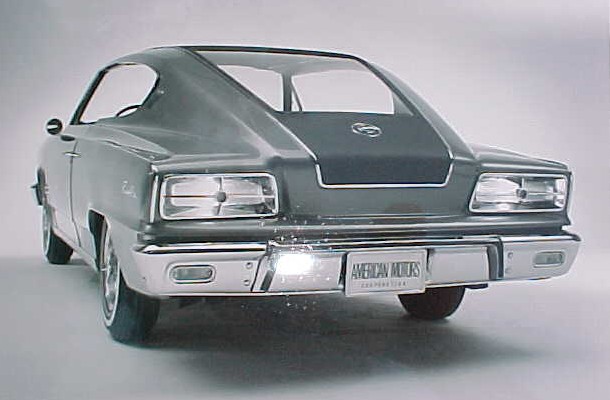 |
|
| Overview | |
| Manufacturer | American Motors Corporation(AMC) |
| Designer |
|
| Body and chassis | |
| Class | Concept car |
| Body style | 2-door fastback |
| Layout | FR layout |
| Powertrain | |
| Engine | AMC Straight-6 |
| Dimensions | |
| Wheelbase | 106 in (2,692 mm) |
| Length | 180 in (4,572 mm) |
| Height | 52.5 in (1,334 mm) |
The Rambler Tarpon was a concept car, a sporty youth-oriented 2 plus 2 hardtop coupé developed in 1963 by American Motors Corporation (AMC). The bright red with black roof design study made its public debut 1964 Chicago Auto Show and served to foretell the fastback design elements of the larger Rambler Marlin that was introduced in 1965.
Design
The Tarpon was an “aquatically-named” design study for a small rear-wheel drive two-door monocoque pillarless hardtop. Characteristic was its sleek sloping fastback roof that narrowed as it met the rear bumper. The Tarpon featured two large and deep taillights that flowed down from the shoulders of the rear fender. The show car was finished in red with a black vinyl roof accenting its clean shape from the windshield back to almost the rear bumper. The smooth roofline was unbroken by the almost horizontal rear window. In a 1991 book about collectible cars, automotive historian Richard M. Langworth described the Tarpon’s sweeping roofline and “roughly elliptical side window openings suited the American’s handsome lines to a T, and the pretty well-peoportioned fastback looked a natural for showroom sale.” However, there was no trunk lid or outside hatch to access the cargo area.
The Tarpon concept “generated much excitement at the Society of Automotive Engineers (SAE International) convention in January 1964.” The concept was shown with the designers worked on a cutaway profile of the car on stage. The Tarpon then generated wide public interest as it toured the auto show circuit starting in January 1964. Its semi-boat tail roof design was accented with black vinyl first appeared at the Chicago Auto Show. It was well received at the automobile shows before the so-called “pony car” market segment was established. The Tarpon appeared together with the Mustang II (a concept design shown before the production version was unveiled) at the 1964 New York International Auto Show.
Development
The automobile marketplace was changing in the early 1960s “when many young, first-time drivers entered the market … and bought cars with flair.”[4] Early in 1963, American Motors’ management began development of “a new car with a sports flair” to modify its image. Richard A. Teague‘s styling team came up with an entirely new concept for AMC – a fastback design. He had a passion for pre-World War II automobiles and had a “passion for taking old styling and making it new again.” He observed the 1963 Chevrolet Corvette spit-window coupe design and the 1963 Ford Galaxie Sports Hardtop, which outsold the notchback models, followed the pattern set by Chevrolet’s distinctive 1942 Fleetline two-door fastback body style called the Aerosedan. Teague knew that his design team had to work with considerably smaller budgets than their counterparts at Detroit’s Big Three (General Motors, Ford, and Chrysler). The small automaker was not willing to undertake the large investment that would be required all-new tooling, so his design team made imaginative use of existing tooling and create spin-offs from existing products.
The Tarpon was made on the compact-sized Rambler American‘s new design and platform already set for the 1964 model year. A convertible chassis was used 106 in (2,692 mm) wheelbase), but the Tarpon was slightly longer, 180 in (4,572 mm) compared to 177.25 in (4,502 mm) for the production Rambler American. The Tarpon’s roof was lowered two inches making it only 52.5 in (1,334 mm) high for an even more dynamic look. The top section of the new Rambler Tarpon was made of reinforced plastic. The windshield was described as “bulbous” and the fastback roofline featuring a “skylight” rear window. The swept back, double-compound curved windshield further enhanced the Tarpon’s low appearance. The Tarpon also featured polished 13-inch aluminum wheels. Production Ramblers rode on ordinary steel 14-inch versions, so the smaller wheels made the car lower. The interior had a complete set of dial-type gauges under a padded dash, a deep-dish aluminum steering wheel rimmed in walnut, and custombucket seats.
The Tarpon seemed to take aim at Plymouth’s new Valiant-based Barracuda and the soon to be announced Ford Mustang. Shown before the introduction of Ford’s compact Falcon-based Mustang, AMC’s Tarpon was “an instant success” with 60 percent of surveyed potential buyers stating they would buy one.
The Tarpon did not go into production. At that time, AMC was still developing its “GEN-2” light-weight V8 engine that would fit the small Rambler American chassis. If produced, the Tarpon would have been a competitor to the Plymouth Barracuda, a fastback derivative of the second-generation compact Valiant. Utilizing an existing compact platform would have paralleled the Mustang’s design approach whose chassis, suspension, and drive train were derived from the Ford Falcon. However, AMC’s market research indicated that offering only a six-cylinder power plant would not satisfy the intended target market segment. The new V8 engine was introduced in 1966 in the sporty hardtop model of the Rambler American called Rogue. Moreover, AMC’s CEO, Roy Abernethy, wanted the company to move away from the marketing image of Ramblers as being only small, economical, and conservative automobiles and designs. According to Abernethy AMC’s “main problem was its image lag — the fact that too many people still thought of American Motors as the builder of plain jane compacts.”
Under Abernethy’s leadership, the company was introducing larger cars that had more options, prestige, and luxury. For example, the new convertibles and more upscale Ambassador potentially offered higher profits. Although the small four-passenger Tarpon anticipated a new market segment that later became known as the pony cars, the decision at AMC was to build its sporty fastback “image” model on the company’s mid-sized or intermediate Classic platform. Teague recalled that “Abernethy had decided that instead of a 2+2 we would build a 3+3 sports-type car.” The new production model, called Marlin, was introduced mid-year 1965 and it added more “sport” to AMC’s car line-up. However, the Marlin had six-passenger capacity and was equipped with features as apersonal luxury car like the Ford Thunderbird or Buick Riviera, rather than a competitor in the pony-car segment. Nevertheless, the production Marlin incorporated many of the design features that were the trademarks of the Tarpon show car. Because it was a much larger car, the Marlin had even more pronounced shoulders extending laterally behind the rear wheels than those on the Tarpon.
In 1965, three years before AMC’s production pony car was unveiled, press reports described the compact-sized design as “Tarpon-like fastback” built on the Rambler American’s platform. The Tarpon “was the car that AMC could have, should have, but didn’t make in response to the Mustang… Instead AMC built the Marlin, which, on the larger Classic chassis, was too big to be a pony car, too slow to be a muscle car, and cursed with ungainly proportions due to the Classic’s stubby hood.” The automaker was niche marketing, offering a larger-sized product that not offered by its much larger competitors. Although the Tarpon show car pointed the way, AMC waited until the 1968 model year to introduce a small fastback, the Javelin, that was aimed directly at the market segment created by Ford’s Mustang.
Designers
The automotive design team at AMC was headed by Richard A. Teague. Stuart Vance was Manager of Engineering and this included the body development, as well as the prototype shop. Others involved with the Tarpon were Teague’s right hand man Fred Hudson (who later contributed to the Javelin), Vince Geraci (who contributed to final look of the Marlin), Chuck Mashigan (Advanced Studio manager), Robert Nixon, Jack Kenitz, Donald Stumpf, Neil Brown Jr., Bill St. Clair, Jim Pappas, as well as Jim Alexander (who designed the interior). Teague selected the names for both the Tarpon show car and the production Marlin.
Teague worked at AMC for 26 years. He was responsible for some of AMC’s timelessly beautiful and advanced vehicles, as well as for some of the company’s disappointments. After his retirement as Vice President at AMC, Teague described the development of the fastback design:
- “… We originally had a car called the Tarpon, which should have been produced … it was really a neat car, a tight little fastback. We showed it to the S.A.E. (Society of Automotive Engineers) convention (February, 1964 in Cobo Hall in Detroit, Michigan) and everybody was steamed up about it! But the thing that killed the Tarpon was the fact that we didn’t have a V-8 for it at that time…. [AMC president] Roy Abernethy didn’t like little cars. Never did. He liked big cars, because he was a big guy — hell of a nice guy. And he felt that this car was too small, so he said, “Well, heck, Teague, why don’t you just put it on the Rambler Classic wheel-base? That way you’ve got V-8 availability and you’ve got more room inside it.” And then on top of that he added an inch to the roof while I was in Europe. I still have never gotten over that…”
Teague was also responsible for the design of AMC’s compact Javelin, as well as the two-seat AMX. Both were ground breaking small fastback sport coupes with well proportioned and timeless lines.
Legacy
The Tarpon served as the direct fastback design influence for the 1965-1967 AMC Marlin. Moreover, components of the original Tarpon design returned to a production car in 2004 in a fastback coupe with a distinctive design “that reminds more than one observer of the old Rambler Marlin.” The principal appearance statements of the small two-seat Chrysler Crossfire include its “provocative boattail theme” in its fastback and rear end design. Automotive journalists noted the Crossfire’s resemblance to the AMC Marlin featuring the Tarpon’s rear-end. For example, Rob Rothwell wrote: “My first glimpse of the rear lines of the Chrysler Crossfire instantly brought back memories of one of my favorite cars, the 1965 Rambler Marlin”
- Show cars
- Rambler Palm Beach: 1950
- Rambler Tarpon: 1964
- International
- Rambler AMX: 1969 – 1970 (Australia)
AMC AMX
- For the AMC AMX of 1978, see AMC Concord.
- For 1979-1980, see AMC Spirit.
| AMC AMX | |
|---|---|
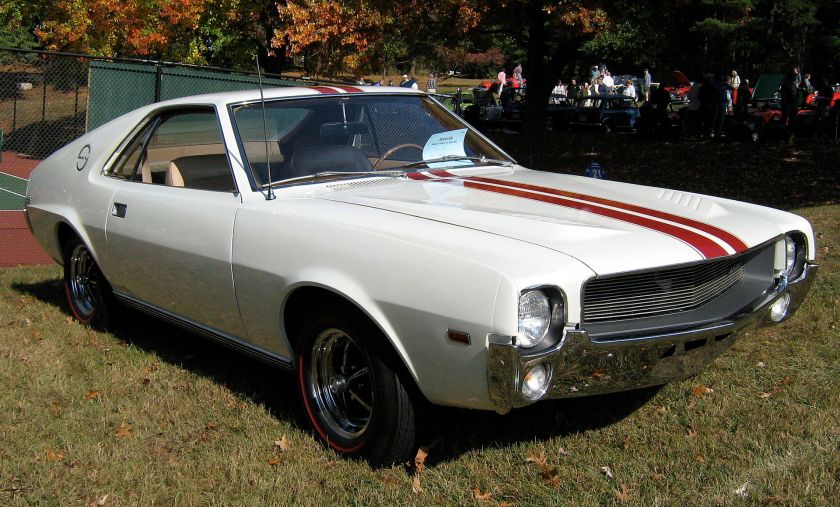
1968 AMX with “Go-Package”
|
|
| Overview | |
| Manufacturer | American Motors Corporation |
| Also called | Rambler AMX (Australia) |
| Production | 1968–1970 |
| Assembly | Kenosha, Wisconsin, United States Port Melbourne, Australia (AMI) |
| Designer | Richard A. Teague |
| Body and chassis | |
| Class | Grand tourer, Muscle car, Sports car |
| Body style | 2-door coupe |
| Layout | FR layout |
| Platform | AMC’s “junior cars” |
| Powertrain | |
| Engine | 290 cu in (4.8 L) 4-bbl V8 225 hp (168 kW; 228 PS) 1968-69 343 cu in (5.6 L) 4-bbl V8 280 hp (209 kW; 284 PS) 1968-69 360 cu in (5.9 L) 4-bbl V8 285 hp (213 kW; 289 PS) 1970 390 cu in (6.4 L) 4-bbl V8 315 hp (235 kW; 319 PS) 1968-69 390 cu in (6.4 L) twin 4-bbl V8 420 hp (313 kW; 426 PS) 1969 SS 390 cu in (6.4 L) 4-bbl V8 325 hp (242 kW; 330 PS) 1970 |
| Transmission | 4-speed manual floor shift 3-speed “Shift-Command”automatic on console |
| Dimensions | |
| Wheelbase | 97 in (2,464 mm) |
| Length | 1968-69: 177 in (4,496 mm) 1970: 179 in (4,547 mm) |
| Width | 71 in (1,803 mm) |
| Height | 51 in (1,295 mm) |
| Curb weight | 3,000 lb (1,361 kg) |
The AMC AMX is a two-seat GT-style sports car that was produced by American Motors Corporation for the 1968 through 1970 model years. The AMX was also classified as a muscle car, but “unique among other American cars at the time due its short wheelbase“. The AMX was also the only American-built steel-bodied two-seater of its time, the first since the 1955-1957 Ford Thunderbird. To a degree, the AMX was a competitor with America’s only other two-seater of the era, the Chevrolet Corvette for substantially less money. With a one-inch (2.5 cm) shorter wheelbase than the Chevrolet’s 2-seater, “the AMX was often seen by the press as a Corvette competitor.”
Fitted with the optional high-compression medium block 390 cu in (6.4 L) AMC V8 engine, the AMX offered top-notch performance at an affordable price. In spite of this value and enthusiastic initial reception by automotive media and enthusiasts, sales never thrived. However, the automaker’s larger objectives to refocus AMC’s image on performance and to bring younger customers into its dealer showrooms was achieved. After three model years, the two-seat version was discontinued, and the AMX’s now signature badging was transferred to a high-performance version of its 4-seat sibling, the Javelin, from 1971-1974.
American Motors capitalized the respected reputation of the original AMXs by reviving the model designation for performance-equipped coupe versions of the compact Hornet in 1977, Concord in 1978, and subcompact Spirit in 1979 and 1980.
Origin of AMX

The AMX name originates from the “American Motors eXperimental” code used on a concept vehicle and then on two prototypes shown on the company’s “Project IV” automobile show tour in 1966. One was a fiberglass two-seat “AMX”, and the other was a four-seat “AMX II”. Both of these radically styled offerings reflected the company’s strategy to shed its “economy car” image and appeal to a more youthful, performance-oriented market.
The original AMX full-scale models were developed in 1965 by AMC’s advanced styling studios under the direction of Charles Mashigan. The two-seat AMX was “big hit on the auto show circuit in 1966” and featured a rumble seat that opened out from the rear decklid for extra passengers called a “Ramble” seat. AMC executives saw the opportunity to change the consumers’ perception of the automaker from Romney’s economy car image, to the realities of the new marketplace interested in sporty, performance oriented vehicles. Robert B. Evans requested a car like the AMX to be put into production quickly.
Two simultaneous development programs emerged for a production car: (1) a modified Javelin and (2) a completely new car bodied in fiberglass. The first approach was selected allowing AMC to use its existing technology and unibody manufacturing expertise to make fairly inexpensive modifications to the Javelin approximating the prototype’s styling and proportions. The automaker could turn out steel bodies in large numbers, so it rejected developing plastic (or fiberglass) bodies because those are intended only for low-production models. The first fully operational unit debuted as part of AMC’s AMX project in 1966. The “once-frumpy” automaker jumped on the “pony car bandwagon” with its “attractive Javelin” and soon introduced the “unique” AMX featuring a design where “hoods didn’t come any longer, nor decks any shorter”.
Vic Raviolo, previously responsible for the Lincolns that raced in the Carrera Panamericana during the 1950s was involved with engineering AMC’s new sports-car-type coupe. The AMX was the first steel-bodied, two-seat American performance car since the 1957 Thunderbird, Ford’s original two-seater having long since evolved into a four-seat personal luxury car. The AMX was also the only mass-produced, domestic two-seater to share the market with Chevrolet’s Corvette since the 1957 Thunderbird. With a short 97 in (2,464 mm) wheelbase, the AMX’s direct competition was the one-inch longer (98 inches (2,489 mm) Chevrolet Corvette. The AMX’s manufacturer’s suggested retail price (MSRP) was US$ 3,245 (US$22,007 in 2015 dollars ), nearly 25% below and over $1,000 less than the Corvette’s price tag.
The AMX was introduced to the press at the Daytona International Speedway on 15 February 1968; just over four months after the Javelin went on sale. In the demonstrations on the race track, the new AMXs ran at speeds up to 130 mph (209 km/h). American Motors’ Group Vice President, Vic Raviolo, described the AMX as “the Walter Mitty Ferrari.” The AMX was designed to “appeal to both muscle car and sports car enthusiasts, two camps that rarely acknowledged each other’s existences.” The problem was the “tire-melting” acceleration of the 2-seater made it “a quick car that handled like a sports car, confusing the buying public.” Automotive journalist Tom McCahill summed up, “the AMX is the hottest thing to ever come out of Wisconsin and … you can whip through corners and real hard bends better than with many out-and-out sports cars.”
Record-breaking
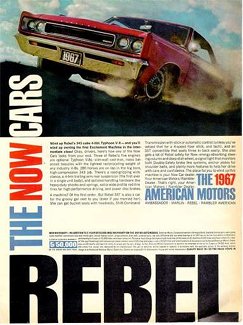
In January 1968, two specially-prepared AMXs set 106 world speed and endurance records at Goodyear‘s track in Texas driven by World Land Speed Record holder Craig Breedlove, his wife Lee, and Ron Dykes. As a way to promote the new car, AMC’s Performance activities manager, Carl Chakmakian, asked Breedlove to put the AMX through its paces before it was even available for sale. Breedlove’s “Spirit of America” crew and Traco Engineering had six weeks to prepare the cars before they were to be displayed at the Chicago Auto Show in February.
The AMC V8 engines, such as the 290 cu in (4.8 L) engine in one car was bored out to 304 cu in (5.0 L) and the 390 cu in (6.4 L) in the other to 397 cu in (6.5 L). The shop installed exhaust headers, eight-quart oil pans, oil coolers, hi-rise intake manifolds, racing camshafts with solid lifters and stronger springs, and larger carburetors. The cars had engine and rear-end oil coolers, and 37 US gal (140 L; 31 imp gal) cell-type safety fuel tanks. Engine components were X-rayed and Magnafluxed to check for cracks, as were chassis components.
Chassis preparation included heavy-duty front and rear springs (part of the factory’s optional handling package), rear spring traction control arms, heavy-duty shock absorbers and a “panhard” type track bar in the rear to eliminate side sway. Stock wheels and tires were replaced by wide magnesium racing wheels and Goodyear racing tires. The cars were aerodynamically modified: the front ends were lowered, the hoods were slanted down and spoilers were installed below the front bumpers. The car interiors had structure-stiffening roll cages for driver protection, a stock bucket seat modified for additional support, and supplementary engine-monitoring instruments.
Breedlove also took the AMX to Bonneville reaching 189 mph (304 km/h) in a United States Auto Club (USAC) sanctioned run, as well as an unofficial run of over 200 mph (322 km/h).
Industry firsts
The AMX was not only sporty and attractive, but it introduced many industry firsts.
The American Society of Automotive Engineers named the AMX as the “Best Engineered Car of the Year” in 1969 and 1970.
For its first year recognition, the reasons cited included the car’s dashboard, which was injection-molded in one piece “for safety purposes, an industry first.” The AMX’s new 390 engine was developed to have a large displacement within its minimal external dimensions and moderate weight, while the use of common components and machining with AMC’s 290 and 343 engines assured manufacturing economy. The 1968 models also included an innovative fiberglass safety padding, a “plastic” on the inside of the windshield posts that was first used on the AMC Javelins.
For the following year’s award, the citation included the 1970 AMXs (and Javelins) being the first production cars to use windshields that were safer, thinner, and lighter than ordinary laminated glass. Developed by Corning, the glass featured a chemically hardened layer designed to give under impact and crumble into small granules to reduce injuries. The inner layer has “stress raisers that will cause it to break before excessively high concussion forces can be developed in the occupant’s skull.”
American Motors also incorporated new designs for windshield sealing for the 1970 models, and developed a systems solutions process that began in the styling studio to insure maximum efficiency.
1968
American Motors promoted the mid-model year launch of the AMX to automotive journalists at Daytona to emphasize its sports car performance, as well as with a marketing agreement with Playboy Enterprises. The AMX was introduced to the public on 24 February 1968, five months after the Javelin and other 1968 AMC cars. It was promoted as “the only American sports car that costs less than $3500”. American Motors advertisements also showed “a helmeted race driver revving up at the starting line in one of AMC’s sporty AMX models, which it describes as ready to do 125 miles an hour.”
The two-seat AMX was “meant for a small, well-defined market niche, and it pulled in young people into AMC dealer showrooms in never before seen numbers”. Numerous road tests described the new AMX as a “handsome two-seater with American-style acceleration and European-style handling”. Journalists gave it a real run workout on all kinds of terrain and wrote “that the AMX is one of the best-looking cars — if not the best-looking car — made in the U.S.A.”
All AMXs came with a 4-barrel carbureted small block AMC V8 engines in several versions: 290 cu in (4.8 L) (225 hp (168 kW), N-code), 343 cu in (5.6 L) (290 hp (220 kW), T-code), as well as the 390 cu in (6.4 L) “AMX” featuring 315 hp (235 kW) with 425 pound force-feet (576 N·m) of torque (X-code). All derived from the same external sized block. However, the three engines differed vastly internally, with the smallest engine having small intake and exhaust valves, thin block webbing, and a cast nodular iron crankshaft; the 343 used larger valves with a thicker block webbing; and the 390 moved up to a forged steel crankshaft and connecting rods, as well as larger rod bearings, 2.250 in (57.15 mm) compared to 2.090 in (53.09 mm) in the smaller two versions.
A BorgWarner T-10 four-speed manual transmission was standard, as were special traction bars, dual exhaust system, and fatter tires for better traction. A “Shift-Command” three-speed automatic transmission with the capability of manual shifting (BorgWarner model M-11B or M-12) was optional together with a floor console mounted shifter.
A popular “Go-Package” option came with either the four-barrel 343 or 390 engine, and included power assisted front disk brakes, “Twin-Grip” differential, E70x14 red-stripe performance tires on “Magnum 500” styled-steel wheels, heavy-duty suspension with thicker sway-bars, heavy-duty cooling, and other performance enhancements. A wide range of specialized performance parts were also available through AMC dealers for installation on customer’s cars. These were known as “Group 19” parts because of the way AMC organized its parts books.
Breedlove AMX
According to several sources, “Breedlove Replica” cars to commemorate the speed and endurance records were offered by AMC. The Standard Catalog of American Muscle Cars 1960-1972 describes an estimated 50 “Breedlove” AMXs were sold featuring the red, white, and blue paint scheme along with the standard 4-barrel 290 cu in (4.8 L) V8 with four-speed manual transmission.
However, AMC historian, Larry Mitchell, argues there was no “factory literature, order sheets, advertising, photographs, or anything else to properly document any factory 1968 or 1969 ‘Breedlove Replica’ AMXs.” According to Mitchell, a new car that was ordered by a dealer in Canada could not have been painted at the factory, but rather outsourced to local Kenosha body shops to perform the final painting.
Hertz rent-a-racer
In the late-1960s, The Hertz Corporation offered “rent-a-racer” program in selected locations that included cars such as Corvettes, Jaguar XK-Es, Shelby Mustangs, and AMXs.
1969
The AMX’s full second model year saw only slight changes, except for a $52 increase in its base price. The five-spoke Magnum 500 steel road wheels were no longer chrome plated, but now came with a stainless steel trim ring. The racing stripes were now available in five colors. The interior featured a revised instrumentation with the 0–8000 rpm tachometer moved to match the speedometer that was now calibrated to 140 mph (230 km/h). Interior door panels were revised, carpeting was upgraded, new leather upholstery was optional, and the gas pedal became suspended. Later production cars received a hood over the instruments in front of the driver. Trunk capacity was 9.7 cubic feet (275 l).
Starting January 1969, all manual transmission AMXs came with a Hurst floor shifter. The center console-mounted three-speed “Shift-Command” automatic remained optional with “1”, “2”, and “D” forward settings. The “D” mode was fully automatic, but the driver could shift manually through all three gears by starting out in the “1” setting for first-gear with no upshift, and the “2” setting for second-gear with no upshift.
A “Big Bad” paint option for $34 became available starting in mid-1969. The neon brilliant blue (BBB), orange (BBO), and green (BBG) exteriors included color-matched front and rear bumpers, as well as a special slim bright lower grille moulding for the front bumper and two vertical rubber-faced painted bumper guards for the rear. The factory-painted 1969 AMXs were 195 in BBB, 285 in BBO, and 283 in BBG.
Popular Mechanics wrote that the 1969 “AMX preserves the status quo this year, being virtually unchanged, remains an absolute delight to drive.”
California 500
A specially equipped version was sold by West Coast AMC dealers in 1969. The cars came with several options that included “Trendsetter Sidewinder” sidepipes and brass plaques on the hood blisters.
Super Stock AMX
AMC also introduced the Super Stock AMX. To maximize quarter-mile performance, the 390 engine was equipped with twin Holley carburetors and 12.3:1 compression-ratio cylinder heads, plus aftermarket Doug’s headers and exhaust system, and the tires were drag-radial slicks. Hurst Performance carried out several additional modifications.
American Motors rated the car at 340 hp (250 kW), but the National Hot Rod Association ultimately rated it at 420 horsepower (310 kW) and shuffled it among various competition classes: SS/G, SS/D, and SS/C. Its best recorded quarter-mile was 10.73 seconds at 128 mph (206 km/h).
The Super Stock AMX was meant for the race track and lacked comfort equipment such as a heater. The car could be ordered all white, or in the vertical bands of red, white, and blue that distinguished numerous AMC competition cars of the day. Base price was $5,994, some $1,900 more than a fully loaded regular 1969 AMX. There was no factory warranty.
Playmate AMX
Playboy magazine’s 1968 Playmate of the Year, Angela Dorian, was awarded a specially painted “Playmate Pink” 1968 AMX. It was powered by the base 290 V8 with automatic transmission, air conditioning, tilt wheel, AM/8-track radio and optional rear bumper guards. Aside from the unique color, it differed from other AMXs with its dashboard number plate containing Dorian’s measurements, making her car AMX 36-24-35.
Some sources describe other AMXs to have been painted Playmate Pink at the factory. AMC’s marketing vice-president, Bill McNealy, who handed over the keys to Angela Dorian’s car mentioned that “a number of them” were finished in pink.
In late 1968, a Playmate Pink AMX was special-ordered by a dealership in rural Potosi, Missouri. This 1969 model year car’s door tag indicates a “00” paint code (meaning a special-order color) and it has a 390 V8 with automatic transmission, as well as the performance “GO” Package, air conditioning, and leather seats.
Pikes Peak cars
The Pikes Peak International Hill Climb used 1969 AMXs as pace cars for the hillclimb race to the summit of Pikes Peak that was held on 29 June 1969 in Colorado.
The AMX Pace and Courtesy cars were used by racers (including Bobby Unser) to practice the week prior to the race up the mountain. There were 12 (10 according to some sources) pace/courtesy AMXs, and all were equipped with the “390 Go-Pac” option and finished in “Frost White” with red stripes and red interiors.
A number of AMC and Jeep vehicles have participated in the annual race, winning class titles and setting records, but the only two-seat AMX that was officially raced in the hillclimb was a 1969 model piloted by Larry G. Mitchell in the 1987 “Vintage” class.
AMX-R
The original AMX’s “Ramble” seat idea was considered for possible production. A working prototype was built in 1968 from a regular AMX by James Jeffords, a designer-customizer, and was named the AMX-R. Jeffords was also head of the Javelin Trans Am Racing Team for AMC. Together with industrial designer Brooks Stevens, they decided to also “plush up” the interior, add custom paint treatment and hood with Jeffords’s name in badge form, as well as a modified suspension as part of their plan to offer an optional Ramble seat for 500 production cars. The first prototype was prepared by Dave Puhl’s House of Kustoms in Palatine, Illinois. However, numerous problems prevented serial production, including safety and product liability concerns, AMC’s refusal to sell him the cars to modify, as well as the negative reaction from Ralph Nader to the exposed exterior seating idea. The AMX-R’s special blacked-out hood treatment would later to be offered as “shadow mask” option on 1970 AMX models.
1970
American Motors 1970 AMX advertising headlined, “We made the AMX look tougher this year because it’s tougher this year”. They were mildly facelifted resembling the first two model years, but the changes were different enough to be a separate design for 1970. Featured was a new front end design with a longer hood that had a “power blister” with two large openings. These were a functional cold ram-air induction system with the popular “Go Package” available with the 360 and 390 engines. The new grille was flush and full-width incorporating the headlamps. The revised rear end also featured full-width taillamps and a single center mounted backup light. Side marker lights were now shared with several other AMC models. Riding on the same wheelbase 97-inch (2,464 mm) as before, the changes increased the AMX’s overall body length by about two inches (51 millimeters) to 179 in (4,547 mm).
American Motors also changed the AMX’s engine lineup for 1970 with the introduction of a new 360 cu in (5.9 L) four-barrel (290 hp (220 kW), P-code) to replace the 343 V8. The smallest 290 was dropped and AMC could claim 65 more base horsepower than the AMXs had previously. The 390 V8 engine continued, but upgraded to new heads with 51 cc combustion chambers that increased power to 325 hp (242 kW). The code remained “X” for the engine on the vehicle identification number (VIN). The “Go package” was available with the 360 engine (including power front disc brakes, F70x14 raised white letter tires, handling package, and the ram-air induction system) for $298.85, or including the 390 engine for $383.90.
Also new, the double-wishbone front suspension had ball joints, upper and lower control arms, coil springs and shock absorbers above the upper control arms; as well as trailing struts on the lower control arms. The “Magnum 500” road wheels were now standard, but the new “Machine” 15×7 inch slot-styled wheels were optional.
The interiors of the AMX were also redesigned. The broad wood-grained dashboard, center console, and two-spoke “Rim Blow” steering wheel were new. Tall bucket seats now featured a “clamshell” design integrating the headrests. Leather upholstery was $34 extra. The exterior rear view mirror featured a new design and in some cases matched the car’s body color. The three “Big Bad” exterior paints continued to be optional on the 1970 AMXs, but they now came with regular chrome bumpers. A new “shadow mask” exterior finish applied over any available AMX color was a $52 option, which included a satin black-painted hood, engine compartment, front fender tops, and side window surrounds offset by thin silver striping. The optional “C-stripe” was $32.
The manufacturer’s suggested retail price (MSRP) for the base model was US$ 3,395 (US$ 20,617 in 2015 dollars) as AMC promoted the 1970 AMX as, “A sports car for the price of a sporty car.”
Motor Trend summed up a road test of a 1970 AMX with the 390 engine as “one of better constructed cars around.” Described as “the best version yet of this blend of muscle car and sports car”, the 1970 model was also the last “true AMX”.
Performance figures
Original road test of a 390 AMX by Car and Driver (1968)
- 0 to 60 mph = 6.6 seconds
- 0-100 mph = 16.3 seconds
- Dragstrip quarter-mile acceleration = 14.8 seconds @ 95 mph (153 km/h)
- Top speed = 122 mph (196 km/h)
Original road test of a 390 AMX by Motor Trend (December 1969)
- 0 to 60 mph = 6.56 seconds
- Dragstrip quarter-mile acceleration = 14.68 seconds @ 92 mph (148 km/h)

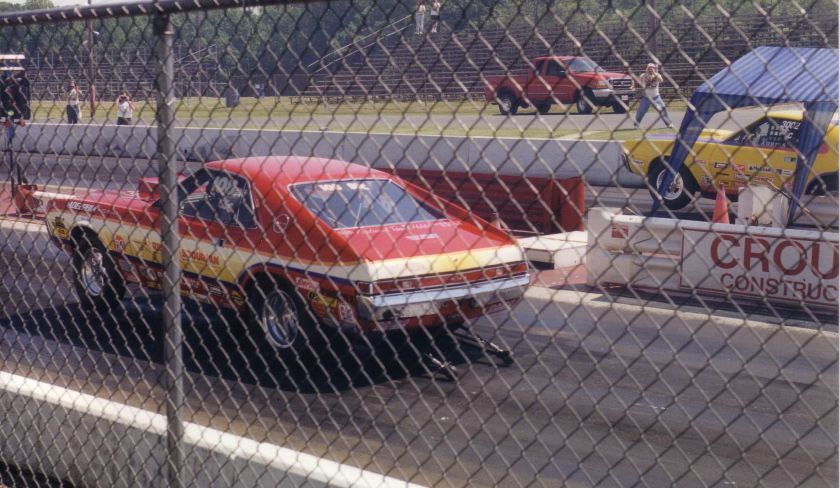
In 1969, the TV show Car and Track posted the following times with an AMX 390 cu in (6.4 L) running a standard 4-barrel carburetor and 10.2:1 compression ratio:
- 0 to 60 mph acceleration = 6.5 seconds
- Dragstrip quarter-mile acceleration = 14.1 seconds
Racing
The AMC AMX, while not a Corvette, was a high-performance car with few equals. The cars were regular performers on dragstrips around the country. Drivers included Shirley Shahan, better known as the “Drag-On Lady”, and Lou Downy. National Hot Rod Association (NHRA) champion Wally Booth raced AMXs in the both the Super Stock and the Pro Stock classes. Herman Lewis, often described “as ‘the Godfather of AMC Racing’ … won 200 events in his hellacious red, white, and blue AMX.”
The 1968 and 1969 AMXs with AMC’s 390 cu in (6.4 L) engines compete in contemporary Nostalgia Super Stock drag racing. Owners have also modified AMXs to compete in modern Pro Touring car racing.
The AMX was campaigned in amateur Sports Car Club of America (SCCA) competition. An AMX was in second place in the 1969 SCCA national championship. Dwight Knupp drove his AMX just 1 minute and 14 seconds behind a Corvette’s winning average of 102.385 mph (165 km/h) on 30 November 1969, at the Daytona International Speedway with 16 cars in the B production class, and placed sixth overall out of the total of 28 A and B class cars competing in the race.
A 1969 AMX was entered in the 1971 and 1972 Cannonball Baker Sea-To-Shining-Sea Memorial Trophy Dash, an unofficial automobile race from New York City and Darien, CT, on the US Atlantic (east) coast, to Redondo Beach, a Los Angeles suburb on the Pacific (west) coast. This was during the time of the newly imposed 55 mph (89 km/h) speed limit set by the National Maximum Speed Law. A team of enthusiastic brothers, Tom and Ed Bruerton, finished the 1971 competition in fifth place. They drove 2,897 miles (4,662 km) in 37 hours and 48 minutes at an average of 77.3 mph (124 km/h), with no speeding tickets. Their AMX already had 90,000 miles (144,841 km) on the odometer and the brothers had previously taken it on numerous endurance rides, including “a rocky ride the entire length of the Baja California peninsula.” They again entered “their battlescarred AMX one more time” in the 1972 run. The brothers finished in eighth place, making the coast-to-coast outlaw race in 39 hours and 42 minutes at an average of 72.3 mph (116 km/h).
Production
The two-seat AMX was built for three model years following its debut as a mid-year model on February 15, 1968. The first 1968 model year cars were scheduled to appear in dealer showrooms on March 19, 1968.
AMC AMX model year production totals in the U.S., by engine and transmission:
| 1968 | 1969 | 1970 | Total | |
|---|---|---|---|---|
| 290 manual | 525 | 619 | n.a. | 1,144 |
| 290 automatic | 484 | 299 | n.a. | 783 |
| 343 manual | 415 | 843 | n.a. | 1,258 |
| 343 automatic | 902 | 729 | n.a. | 1,631 |
| 360 manual | n.a. | n.a. | 836 | 836 |
| 360 automatic | n.a. | n.a. | 747 | 747 |
| 390 manual | 2,112 | 3,690 | 1,632 | 7,364 |
| 390 automatic | 2,287 | 2,183 | 901 | 5,371 |
| Model year and grand totals | 6,725 | 8,293 | 4,116 | 19,134 |
In 1969, American Motors showed the next generation AMX/2 concept car in the automobile show circuit. As the two-seater AMX production ceased in 1970, AMC was developing a sophisticated European-engineered alternative, the AMX/3 for 1971 introduction. However, overall economic conditions changed with spiraling inflation pushing sales of smaller cars along with the insurance companies’ decision to penalize high-powered automobiles resulting in decreasing the sports-type car market segment, and the AMX was made into a high-performance model of the 4-seat Javelin starting in 1971.
Assembly in Australia
A total of 24 right hand drive 1969 model year AMXs were hand assembled under license in Australia by Australian Motor Industries (AMI) between August, 1969, and July, 1970. They used the name Rambler AMX as AMI produced the Rambler range of cars since October 1960. Complete knock down (CKD) kits were shipped from Kenosha, Wisconsin to AMI’s facilities at Port Melbourne in Victoria.
Differences to the RHD Australian AMXs (compared to the U.S. models) included different outside rear-view mirrors, and black vinyl trim inside the “AMX” circle logo on the C-pillars, As with Rambler sedans built in right hand drive, windscreen wipers were not reversed, remaining LHD pattern, but the power brake booster and heater on the firewall were swapped over. Although the power steering pump remained in its usual left location, the remainder of the steering components were on the right side of the car. The cars came with 343 cu in (5.6 L) and automatic transmission, power steering, power disk brakes, “twin-grip” rear axle, and other items that were optional on the U.S. models. All of the Australian AMX interiors were finished in black and featured unique seats, door panels, and a fiberglass RHD dashboard with a wood-grained instrument cluster in front of the driver. The Australian AMXs came with a large high level of equipment and were promoted as “super” personal luxury cars.
Concept and show cars
AMX/2
Vince Gardner, an outside consultant, designed the fiberglass-bodied AMX II concept car in 1966 as part of AMC’s “Project IV” exhibit. Corporation president Roy Abernethy sanctioned the Turin coachbuilder Vignale to construct an operational car in steel. Delivered in 78 days and known as the “AMX Vignale”, it was first displayed at the 1966 New York International Auto Show.
AMX GT
Developed for the 1968 auto show circuit, the AMX GT is a concept car based on a shortened and “chopped” Javelin with a Kammback rear end. The AMX GT show car provided several design clues to future production models and performance options.
AMX-400
In the late-1960s, George Barris made bolt-on customizing kits for the AMX that were marketed through AMC dealers. He also performed a radical custom treatment on a 1969 AMX. The car was built for the second Banacek TV season episode. The car was lowered and its body was heavily modified. Its roof was cut down almost 5 in (127 mm) and the car was lengthened by 18 in (457 mm). Featuring a sculpted body with louvered accents, it became known as the AMX-400. The car featured a taillight system that glowed green during acceleration, amber during deceleration, and red during braking.
AMX/3
Widely considered as the best AMC design of all time, a third-generation AMX concept car, the AMX/3, debuted at the 1970 Chicago Auto Show. Engine-less and fashioned in fiberglass, the original AMC/3 prototype was a show car only.
American Motors placed an order for 30 operational cars. The AMX/3 body mold was sent to Italian GT maker Giotto Bizzarrini, whose Turin facility hand made drivable mid-engined, steel bodied cars. Built on a 105.3-inch (2,675 mm) wheelbase, the Bizzarrini prototypes used the AMC 390 cu in (6.4 L) V8 and an Italian OTO Melara four-speed transaxle. Road testing was done by BMW, which declared the AMX/3’s chassis one of the stiffest and most neutral handling they had ever tested.
The steel Italian cars differed from the original AMC design in having fewer but functional rear decklid louvers, louvered hoods, and, in some cases, hood scoops to direct fresh air into the heating-A/C system.
Five completed cars were produced before the US$ 2,000,000 program was cancelled. Escalating costs and pending bumper regulations put a stop to the mid-engined AMX/3. The remaining extra parts were used by erstwhile Bizzarini collaborator Salvatore Diomante to assemble a sixth car.
1971 Teague AMX
Sales of the two-seat AMX were not up to the numbers that American Motors management wanted, but AMC’s vice president for styling, Richard A. Teague, wanted to continue the sports model. American Motors’ Advanced Design Studio made design proposals for a 1971 AMX and Teague requested—and received permission—to produce a fully workingconcept car.
Starting with a Frost White 1968 AMX coupe as the development mule, Teague updated its front end to the grille and swooping front fenders of what was incorporated into the production 1971 Javelin. The concept car also featured the interior to what was to become AMC’s characteristic high-backed bucket seats and corduroy upholstery introduced in 1970. The concept car was repainted light metallic blue with red striping to match the interior. A short-wheelbase, two-seat 1971 AMX was not approved for production by the automaker, but Teague used this car as his daily driver.
Collectibility
Automotive historian and author, Richard M. Langworth noted that the AMX has “all the right sports-car stuff” and that the “little machine that can only go up in value over the long haul.”
Prior to 2004 the AMX had been under-appreciated from an investment standpoint, according to CNN.
In 2004, there was considerable variation between the values of two-seat AMXs and four-seat Javelin AMXs. Craig Fitzgerald mentioned “the satisfaction in owning a car that you don’t see every single day, or on the cover of every single magazine,” and favored the two-seater, on the grounds of its rarity; but he noted that parts for either car were extremely expensive.
In 2006, the editors of Hemmings Muscle Machines magazine said that AMCs had “experienced notable value increases over the last few years–especially AMXs…” The book Keith Martin’s Guide to Car Collecting, in collaboration with the editors of the monthly Sports Car Market, lists the 1970 AMX as one of the picks under $40,000 among “Nine Muscle Car Sleepers”.
Unique versions, such as the California 500 Specials and the 52 Hurst-modified SS/AMX drag race cars are perhaps the most highly sought after by collectors. In 2006, a California 500 AMX sold for $54,000 at the Barrett-Jackson auction in Scottsdale, Arizona, while a regular AMX went for over $55,000 at the Mecum collector auction in Belvidere, Illinois. In 2007, Hemmings wrote that only about 39 of the original SS/AMX turn-key race cars may have survived.
By 2007, the AMX was “among the most highly sought AMC cars” and “really taking off in the muscle-car market”. Also in 2007, Hemmings said that the two-seater AMX had “a strong following among old car hobbyists and collectors of historic vehicles and nearly every one of the 19,134 built…remains in circulation and in demand, ensuring a good future for the first-generation AMX as a collectible muscle car.” The 2007 book Classic Carsstates that AMC’s small and powerful AMX “had tire-burning speed” and “all have become collector’s items.”
Noting the increasing values of the 1968-1970 AMXs, Hemmings listed them among the “21 hottest cars” that enthusiasts wanted in 2007 “and will want tomorrow.”
In 2008, Hemmings said that buyers had “only recently ‘discovered’ the AMX; they’re now snapping them up left and right. Prices … are on the rise, though they still represent a relative bargain compared to many more common muscle machines.”
In 2010, Hemmings Classic Car included the two-seat AMXs in their list of 32 best cars to restore in terms of economic sense after factoring purchase price, parts availability, as well as restored value and desirability.
Although low in production, the AMX shared parts and components with other AMC models. There are many active AMC car clubs for these cars. Parts, including reproduction components, are available. However, “AMC did not build cars in the vast numbers the Big Three did back in the day; therefore, there are fewer to restore and not as many parts to go around.” As of 2010, Hemmings Classic Car wrote that the AMXs are “pretty basic” so they are not hard to restore, and that “reproduction parts are available” and continues to grow with many mechanical parts interchanging with other cars.
More valuable according to automotive historian and author, James C. Mays, is the “wow factor”. His book, The Savvy Guide to Buying Collector Cars at Auction, explains this important and measurable pleasure to an owner, whether their car is driven or sits in a climate-controlled garage, such as a red 1969 AMX that attracts more attention than the more prestigious Ferraris and Lamborghinis.
Number matching
American Motors did not provide identification on the engine block, known as VIN stamping, as some other car manufacturers had been doing at that time. Other than the actual displacement, there was no way to associate a vehicle with the original “born with” engine. Since this was common practice at the GM and Chrysler plants it is much easier to verify that the exact engine in the car is actually the factory original unit. Each AMC vehicle was inspected to confirm that the engine displacement (identified by numbers cast on the block under the engine mounts) corresponded to its corresponding engine code in the vehicle identification number (VIN). A tag screwed to the valve cover provides an engine’s build date, and that date code always preceded a specific car’s production sequence. However, there is no engine “numbers matching” test for AMXs or any other AMC automobiles.
As a marketing move for the AMX, AMC affixed a small plate with a number to the center of the dash (1968-1969) or to the glovebox door (1970). These are random numbers. They do not coincide with any other identifying number such as the car’s VIN code, dealer or zone order, production sequence, nor build date. For example, the numbers on the 1970 models ranged from 014469 to 18584.
Scale models
A variety of scale models of the AMX are available including promotional 1/25-scale model manufactured under license from AMC by Jo-Han in factory colors. Hot Wheels offered a 1969 AMX custom in 1:64 scale, and in 1971 issued the AMX/2 show car model. Newer models in 1:18 scale diecast were issued, including the Playboy Pink version in the “Best of the Best” series, as well as the modified “Drag-On Lady” race car. According to the editors of Die Cast X Magazine, “muscle cars are the largest, most popular category in die-cast” collectors, and they included the AMC AMX among the 34 models that represent “the best and most important from the genre … performance and style that are the hallmarks of the high point of American automotive history.”
- Rambler Hornet: 1970 – 1975 (Australia)
AMC Hornet
| AMC Hornet | |
|---|---|
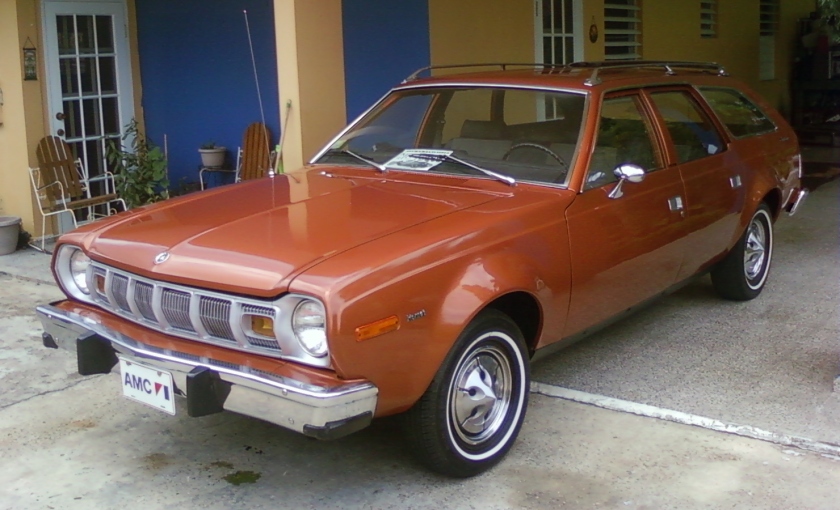
1976 AMC Hornet Sportabout wagon
|
|
| Overview | |
| Manufacturer | American Motors Corporation(AMC) |
| Also called |
|
| Production | 1969–1977 |
| Model years | 1970–1977 |
| Assembly |
|
| Designer | Richard A. Teague |
| Body and chassis | |
| Class | Compact |
| Body style |
|
| Layout | FR layout |
| Platform | AMC’s “junior cars” |
| Related | AMC Gremlin |
| Powertrain | |
| Engine | |
| Transmission |
|
| Dimensions | |
| Wheelbase | 108 in (2,743 mm) |
| Length |
|
| Width | 70.6 in (1,793 mm) |
| Chronology | |
| Predecessor | Rambler American |
| Successor | AMC Concord |
The AMC Hornet is a compact automobile which was manufactured and marketed by the American Motors Corporation (AMC) in a single generation from model years 1970 through 1977. The Hornet replaced the compact Rambler American marking the end of the Rambler marque in the American and Canadian markets. Hornets were also marketed in foreign markets, as well as assembled under license agreements with AMC that included Vehículos Automotores Mexicanos (VAM), Australian Motor Industries (AMI), and by Toyota S.A. Ltd. in South Africa.
The new Hornet became an important vehicle and platform for AMC. It served the company in one form or another for eighteen years, until the 1988 model year. It would outlast all other compact platforms from the competition that included the Chevrolet Nova, Ford Maverick, and Plymouth Valiant. The Hornet was also the basis for AMC’s Gremlin, Concord, Spirit, and the innovative all-wheel drive AMC Eagle.
The AMC Hornet served as an experimental platform for alternative fuel and other automotive technologies. Hornets were campaigned in various motorsports events with some corporate support. A hatchback version was also was featured as part of a special aerial jump in The Man with the Golden Gun, a James Bond film released in 1974.
Origins of the “Hornet” name
The Hornet name plate goes back to the mid-1950s. The name originated from the merger of Hudson Motor Company and Nash-Kelvinator Corporation in 1954. Hudson introduced the first Hudson Hornet in 1951. The automaker formed a stock car racing team centered on the car, and the “Fabulous Hudson Hornet” soon became famous for its wins and stock-car title sweeps between 1951 and 1954. American Motors, the resulting corporation formed by the merger of Nash Motors and Hudson, continued to produce Nash-based Hornets, which were sold under the Hudson marque from 1955 to 1957. The automaker retained rights to the name while it was dormant from 1958 to 1969. The rights to the “Hornet” nameplate then passed to Chrysler with that company’s acquisition of AMC in 1987.
History
The Hornet’s styling was based on the AMC Cavalier and Vixen show cars. The Hornet, as well as the Ford Maverick, were considered a response by the domestic automakers to battle with the imports.
Development of the new model took AMC three years, a million man-hours, and US$40 million. The Hornet was an all-new design sharing no major body components, but utilizing some of the Rambler American’s chassis and drivetrain. An all-new front suspension with anti-brake dive was developed for AMC’s large-sized “senior” 1970 models, and instead of developing lighter components for the new compact-size platform, the same parts were incorporated into the Hornet.
Introduced in 1969 for the 1970 model year, the Hornet was the first car in a line of new models that AMC would introduce over the following three years, and it set the tone for what designer Richard A. Teague and chief executive officer Roy D. Chapin, Jr., had in mind for the company for the 1970s. The Hornet marked the return of AMC to its original role as a “niche” marketer specializing in small cars. It also became one of AMCs best sellers.
With its manufacturers suggested retail price (MSRP) of US$ 1,994 for the base model, the Hornet was an economical small family car. However, it took design cues from the popular Ford Mustang and Chevrolet Camaro, and the company’s own Javelin with a long hood, short rear deck and sporty looks. The Hornet’s 108-inch (2,743 mm) wheelbase platform (two inches or 5.08 centimeters longer than its predecessor, the Rambler American) evolved into a number of other models (including the four-wheel-drive Eagle) and was produced through 1988. The Hornet was initially available in a choice of two thrifty straight-six engines or a 304 cu in (5.0 L) V8.
The Hornet was offered as a two-door and four-door notchback sedan in its introductory year. The hardtop (no “B” pillar) coupe body style was not continued from the 1969 Rambler American. A four-door station wagonvariant named the “Sportabout” was added to the 1971 lineup. Also for 1971, the SC/360 was added. This was a 360 cu in (5.9 L) V8 powered compact muscle car that was available only as a two-door sedan. (The tire pressure sticker on the first 1970 models hinted at the SC/360). For 1973, a semi-fastback hatchback coupe with fold down rear seats was added to the lineup.
AMC used the Hornet as the basis for its AMC Gremlin, which consisted of the front half of the two-door Hornet’s body and a truncated rear section with a window hatchback.
In 1973 a Levi’s Jeans trim package – based on the world-famous jeans manufacturer – was added. The Levi’s trim package was popular and was available for several years. The Hornet station wagon version was offered for two model years with a luxury trim package designed by Italian fashion designer Dr. Aldo Gucci. It is notable for being one of the first American cars to offer an upscale fashion “designer” trim level.
The AMC Hornet was also the first U.S. made automobile to feature guardrail beam doors to protect occupants in the event of a side impact. The 1973 Hornet hatchback was the first U.S.-made compact hatchback design, introduced one year ahead of the 1974 Ford Mustang and the Chevrolet Nova hatchback versions.
The Hornet was phased out after 1977 and transformed into a new “luxury compact” line of automobiles, the AMC Concord. It also served as the basis of an innovative “crossover” all-wheel drive vehicle, the AMC Eagle that was introduced in 1979.
Year-by-year changes
1970
Introduced in September 1969, the first year Hornets came in “base” and higher trim SST models, and in 2 and 4-door sedans. The 199 cu in (3.3 L) straight-6 engine was standard on the base models with the 232 cu in (3.8 L) standard on the SST. The 304 cu in (5.0 L) V8 engine was optional.
The annual new car issue of Popular Science introduced the 1970 model by entitling its article: “Rambler is dead – long live the Hornet!” The authors not only compared the new Hornet with the outgoing Rambler American, but also with its primary competition, the Ford Maverick and finding the Hornet better to Ford’s new model in several factors that are significant to consumers, as well as “certainly superior among economy cars” in ride-and-handling and “way ahead” in performance.
Popular Mechanics road test of a SST model with V8 engine and automatic transmission summarized the findings in the article’s sub-title: “it has a lot of good things in a not-too-small package.”
Popular Science conducted a road test of four of lowest priced U.S. cars (AMC Hornet, Ford Maverick, Plymouth Duster, and Chevrolet Nova) describing the 1970 Hornet offering more interior and trunk room, excellent visibility in all directions, achieved the highest fuel economy, needed the optional disk brakes, and the authors concluded that it was the “practical family car … better value than any of the others”.
- 1970 production:
- 2-door base: 43,610
- 4-door base: 17,948
- 2-door SST: 19,748
- 4-door SST: 19,786
1971
The 1971 model year was the introduction of the Sportabout, a 4-door wagon using a single hatch design in place of the traditional tailgate. The 2- and 4-door sedans were carryovers. The 232 I6 engine was now standard across the range.
A marketing promotion in the Spring made available a new fabric folding sunroof on specially equipped Hornets, as well as on the Gremlin. The opening roof feature was included with the purchase of whitewall tires, custom wheel covers, pinstripes or rally stripes, a light group, and a special visibility group.
SC360
A notable addition was the SC360 version, a compact 2-door muscle car that was intended as a follow-up to the 1969 SC Rambler. Powered by the AMC’s 360 cu in (5.9 L) V8, the SC was distinguished by styled wheels, hood scoop, body striping, and other performance and appearance upgrades. In standard form, with two-barrel carburetor, the 360 produced 245 hp (183 kW; 248 PS) (gross) and was priced at just US$ 2,663 (about $40 below the 1971 Plymouth Duster 340). With the addition of the $199 “Go” package’s four-barrel carburetor and ram-air induction, the SC’s power increased to 285 hp (213 kW; 289 PS). Optional in place of the standard three-speed was a Hurst-shifted four-speed or an automatic transmission. Goodyear Polyglas D70x14 tires were standard, with upgrades running to the handling package and the “Twin-Grip” limited slip differential with 3.54:1 or 3.90:1 gears.
Although the SC/360 could not compete with the holdover big-engined muscle cars, the SC combined respectable quickness (0 to 60 mph in 6.7 seconds and the 1/4 mile dragstrip in 14.9 at 95 mph (153 km/h) with a taut suspension, big tires, and modest size; thus Motor Trend magazine described it as “just a plain gas to drive … it handles like a dream.”
American Motors originally planned to build as many as 10,000 of the cars, but high insurance premiums killed the SC/360 after a single year’s production of just 784 examples.
The Sportabout on the other hand was the most popular model by far, outselling all other Hornet models combined in its debut year. For most of its life it was the only American-made station wagon in its size class.
- 1971 production:
- 2-door base: 19,395
- 4-door base: 10,403
- 2-door SST: 8,600
- 4-door SST: 10,651
- Wagon SST: 73,471
- SC360: 784
1972
American Motors established a new focus on quality with the 1972 model year. The “Buyer Protection Plan”, was the industry’s first 12 month or 12,000 miles (19,000 km) comprehensive, bumper-to-bumper warranty. This innovative AMC Buyer Protection Plan included numerous mechanical upgrades to increase durability, as well as a focus on quality in sourcing and production.
The 1972 Hornet was promoted by AMC as “a Tough Little Car”. American Motors promised to repair anything wrong with the car (except for the tires), owners were provided with a toll-free telephone number to the company and a free loaner car if a warranty repair took overnight.
To consolidate AMC’s product offering, reduce production costs, and offer more value to consumers, the base models were dropped in 1972 and all models were designated as “SST”. The SST offered more items standard than the previous year’s base model at about the same price. Hornets now came with comfort and convenience items that most consumers expected, and these items were typically standard on imported cars.
Other changes included dropping the SC/360 compact muscle car, but the two-barrel version of the 360 cu in (5.9 L) remained optional in addition to the 304 cu in (5.0 L) V8 engine. For those desiring more performance, a four-barrel carburetor was a dealer-installed option on the 360 V8. Automatic transmissions were now the Torque Flites sourced from Chrysler, and AMC called it the “Torque-Command”.
New for 1972 were the “X” package that tried to repeat the success AMC had with this trim option on the 1971 Gremlin. The Hornet X trim was optional on the two-door and the Sportabout, adding among others slot-styled steel wheels, rally stripes, and sports steering wheel. A performance oriented “Rallye” package was also introduced. It included among other items: special lower body stripes, bucket seats, handling package, front disc brakes, quick-ratio manual steering, and a sports steering wheel.
- 1972 production:
- 2-door SST: 27,122
- 4-door SST: 24,254
- Wagon SST: 34,065 (Gucci version: 2,583)
Gucci Sportabout
The 1972 Hornet was notable for being one of the first American cars to offer a special luxury trim package created by a fashion designer. Named for Italian fashion designer Dr. Aldo Gucci, the Gucci package was offered only on the Sportabout, the four-door wagon with a single sloping hatch replacing the then traditional window/tailgate door. The option included special beige-colored upholstery fabrics on thickly padded seats and inside door panels (with red and green striping) along with Gucci logo emblems and a choice of four exterior colors: Snow White; Hunter Green; Grasshopper Green, and Yuca Tan. The Gucci model proved to be a success, with 2,583 produced in 1972 (and 2,252 more for 1973) Sportabouts so equipped.
AMC also produced a one-off Sportabout for Gucci’s personal use. The car was powered by a 5-litre V8 engine and had a three-speed automatic transmission. The interior featured leather was door panels, cargo area as well as the front and rear centre arm rests. The doors and custom-designed bucket seats received red and green striped inserts. The instrument panel was given a centrally located, pull-out writing desk, graced with a scribbler and a sterling silver bamboo pen. A map light at the end of a flexible arm extended from the right side of the desk, the left carried a vanity mirror, also on a flex stem.[26] The back of the front seats popped open. The one on the passenger’s side served as a snack table or provided a flat surface for playing games. The compartment behind the driver concealed a miniature liquor cabinet, complete with four sterling silver tumbles and two decanters—all decorated with red and green enamel stripes.
American Motors followed this designer influence in successive years with the Cardin Javelin in 1973 and the Cassini Matador in 1974, but there were no new signature designer versions after those. This trim package concept inspired other automakers – including Ford‘s luxury marque, Lincoln in 1976 – to offer packages styled by other famous fashion designers.
1973
The biggest visible changes among all AMC automobiles for the 1973 model year were to the Hornet line and its new model, a two-door hatchback. Car and Driver magazine called it “the styling coup of 1973”. Other changes included a new front-end design and bodywork with a V-shaped grille, a slightly recessed and longer hood, and longer peaked front fenders. The facelift incorporated a new stronger and larger energy-absorbing recoverable front bumper system with a horizontal rubber strip that met the new no-damage at 5 miles per hour (8.0 km/h) NHTSA safety legislation. The rear also received a new 2.5 miles per hour (4.0 km/h) bumper with twin vertical rubber guards, but the 5 mph unit (matching the front) was optional. The overall length of the Hornet increased 6 inches (152 mm).
For the 1973 model year, the SST designation was dropped from the Hornet line, and all were simply called Hornet. The newly introduced two-door hatchback incorporated a fold-down rear seat for increased cargo volume from 9.5 to 30.5 cubic feet (269 to 864 l). An optional hinged floor made a hidden storage space that housed a temporary use “space-saver” spare tire, and created a flat load area totaling 23 cu ft (650 l). An optional dealer accessory was available to convert the open hatchback area into a tent camper with mosquito net windows. The new hatchback was available with a Levis bucket seat interior trim option that was actually made of spunnylon fabric, rather than real cotton denim, to comply with flammability standards as well as offer greater wear and stain resistance.
The two- and four-door sedan models were carried over while the Sportabout wagon received a new optional upscale “D/L” package. This trim package included exterior woodgrain body side decal panels, a roof rack with rear air deflector, and individual reclining seats upholstered in plush cloth. The Gucci edition wagon was continued for one more year with five exterior color choices. The “X” package was now available only for the Sportabout and hatchback.
Spurred by AMC’s success in its strategy of improving product quality, and an advertising campaign focusing on “we back them better because we build them better”, the automaker achieved record profits. American Motors’ comprehensive “Buyer Protection Plan” warranty was expanded for the 1973 models to cover lodging expenses should a car require overnight repairs when the owner is away from home.
Engines incorporated new emissions controls and the choices on all Hornet models included two I6s, the standard 232 cu in (3.8 L) or a 258 cu in (4.2 L) version, as well as two V8s, the base 304 cu in (5.0 L) or the 175 hp (130 kW; 177 PS) 360 cu in (5.9 L).
Research sponsored by the U.S. National Highway Traffic Safety Administration (NHTSA) to improve front and side crashworthiness was first applied into production compact vehicles starting with the 1973 Hornet, which included stronger doors designed to withstand 2,500 pounds (1,134 kg) penetration in the first 6 inches (152 mm) of crush.
Suggested prices began at $2,298 for the base model two-door sedan with the more popular new hatchback going for $2,449.
- 1973 production:
- 2-door: 23,187
- 4-door: 25,452
- Wagon: 44,719 (Gucci version: 2,251)
- Hatchback: 40,110
1974
All four versions of the Hornet were mostly carryovers in 1974, with minimal trim changes. The car’s front bumper lost its full-width vinyl rub strip, but gained two rubber-faced bumper guards. A larger rear bumper was added to meet new 5 mph legislation, and the license plate was moved up to a position between the taillights.
New inertial-reel seat/shoulder belts were standard, along with a new electronic system requiring front seat passengers to buckle up before the engine would start.
- 1974 production:
- 2-door: 29,950
- 4-door: 29,754
- Wagon: 71,413
- Hatchback: 55,158
1975
Focusing on the new Pacer, AMC kept the Hornet mostly the same. A new grille with vertical grating was the primary change. A new “Touring Package” included special upholstery and luxury features. In a return to its philosophy of economical compact cars, AMC emphasized its comprehensive “Buyer Protection Plan” warranty in marketing the Hornets.
Six-cylinder Hornets could be ordered with a new British supplied Laycock de Normanville “J-type” overdrive. Optional on cars with a manual three-speed transmission, the unit was controlled by a pushbutton at the end of the turn signal stalk. The overdrive unit engages automatically at speeds above 35 miles per hour (56 km/h) and drops out at 32 mph (51 km/h). It also included an accelerator pedal kickdown switch for faster passing.
All U.S. market Hornets featured catalytic converters and now required gasoline without tetraethyl lead. “Unleaded Fuel Only” warnings were displayed on both the fuel gauge and on a decal by the fuel filler. Consumers complained loudly about the 1974 “mandatory seat belt” system, and it was replaced in 1975 with a simple reminder buzzer and light.
The U.S. economy was experiencing inflation, and new car sales fell for all the automakers. The industry sold 8.2 million units, a drop of more than 2.5 million from the record pace in 1973. Sales of the Hornet also suffered.
- 1975 production:
- 2-door: 12,392
- 4-door: 20,565
- Wagon: 39,593
- Hatchback: 13,441
1976
In its sixth year as a carryover, AMC priced the sedan and hatchback at the same identically, with the Sportabout slightly higher. That year, the Dodge Aspen and Plymouth Volare were introduced; the line included a station wagon, ending AMC’s monopoly on 6-cylinder domestic compact wagons.
- 1976 production:
- Total: 71,577
1977
The Hornet line was mostly unchanged for 1977 with improvements made to engines and transmissions for increased fuel efficiency and the effects of new nitrogen oxides (NOx) emission standards. All 3-speed manual transmissions were now on the floor. A new “AMX” model also appeared.
- 1977 production:
- 2-door: 6,076
- 4-door: 31,331
- Wagon: 28,891
- Hatchback: 11,545
In fall 1977, the Hornet was reengineered and restyled to become the 1978 Concord and helped establish the “luxury compact” market segment. With its upgraded design, components, and more standard features, the new Concord was moved upscale from the economy-focused Hornet. Changes to the AMC’s “junior” platform made the new Concord more comfortable and desirable to buyers seeking an image of luxury, as well as greater value.
AMX
A new sports oriented model, the AMX, was introduced to appeal to young, performance-oriented car buyers. The AMX was available only as a hatchback with the six or the V8 engine featuring a floor shifted four-speed manual or automatic transmission. Standard was an upgraded black or tan interior with a floor console, “rally” instrumentation with tachometer, and “soft-feel” sports steering wheel. The special “Hornet AMX” was only available in four exterior colors that included matching painted bumpers with a wraparound rubber guard strip, body side rubber guard strip and contrasting AMX model identification bodyside decals ahead of the rear wheels. The exterior included a front spoiler integrated into the front lower fender extensions, rear lower fender flares, sport-styled road wheels, brushed aluminum “Targa top” band over the B-pillars and roof, black left and right outside mirrors, and louvers for the rear hatch window. Options included bright aluminum road wheels and large Hornet-graphic decals on the hood and on the decklid. This model marked the return of a famous name that evoked AMC’s original AMX two-seat sports car.
International markets
The AMC Hornet was exported to international markets, as well as assembled under license from Complete knock down (CKD) kits that were shipped from AMC’s factories the U.S. or Canada. The foreign built cars incorporated numerous components and parts that were produced by local manufacturers to gain tax or tariff preferences.
Australia
A total of 1,825 Hornets were built at the Australian Motor Industries (AMI) factory at Port Melbourne in Victoria, Australia between 1970 and 1975. The Hornet was sold in Australia as the Rambler Hornet, only in four-door sedan body style. It was fitted with either a 232 cu in (3.8 L) or 258 cu in (4.2 L) six-cylinder engine and with an automatic transmission.
While the Hornet was the least expensive compact model in the United States, the Hornet in Australia was a luxury model, with high levels of trim, carpet, tires, and accessories. These included high-back seats, fully lined boot and covered spare wheel. The Hornet used a PBR fully assisted dual braking system, and front disc brakes from the Javelin Trans Am. The Hornet sold for $3,999 in 1970, with 407 cars being sold in Australia in that year.
Mexico
American Motors has partial ownership of Vehículos Automotores Mexicanos (VAM) and produced Hornets in Mexico from 1970 through 1977. The VAM built cars continued to be called VAM Rambler following the tradition of the VAM-built Rambler American models up to 1974. The Mexican models included:
- VAM Rambler American (up to 1974) U.S. equivalent: AMC Hornet
- VAM Rambler American Rally – U.S. equivalent: AMC Hornet X sedan instead of hatchback
- VAM American (after 1975) U.S. equivalent: AMC Hornet base model
- VAM American Rally – U.S. equivalent: AMC Hornet X sedan instead of hatchback
- VAM American ECD (1975–1977) U.S. equivalent – AMC Hornet DL two- and four-door sedans
- VAM American GFS (1977) U.S. equivalent: AMC Hornet DL two-door sedan, replaces two-door ECD
- VAM Camioneta American automática (1977) U.S. equivalent: AMC Hornet DL wagon with automatic transmission
The VAM cars came with different trims and interiors than the equivalent AMC-made models. The models also combined different front clips, such as the 1977 VAM American came with the shorter U.S. and Canadian market 1977 Gremlin front end, while its interior trim featured premium seats and upholstery.
VAM Rambler American
The initial VAM Rambler Americans were available in a single nameless trim level (equivalent to the U.S. SST models), with only an optional performance-minded “Rally” package for the two-door sedans that was carried over from 1969.
1970
The Hornet-based 1970 VAM Rambler American featured a standard a 232 cu in (3.8 L) I6 producing 145 hp (108 kW; 147 PS) with a 244 degree camshaft, 8.5:1 compression ratio, and a single-barrel Carter RBS or YF carburetor. A fully synchronized three-speed manual transmission with column-mounted shifter, heavy duty clutch, and a 3.54:1 rear differential gear ratio were standard. The cars came with four-wheel drum brakes, manual steering, four-rigid-bladed engine fan, and regular-duty cooling system. Convenience equipment included a two-tone padded dashboard with a three-pod instrument cluster, “RAMBLER” emblem on the glove box door, electric windshield wipers and washers, a 200 km/h speedometer, side marker lights, four-way hazard lights, antitheft steering column locking mechanism, base steering wheel, brake system warning light, AM radio, front ashtray, cigarette lighter, locking glove box, padded sunvisors, day/night rearview mirror, cardboard-type sound-absorbing headliner, round dome light, dual coat hooks, flip-open rear side vents, full carpeting, driver’s side rubber floor mat sewed to the carpet, front bench seat with split folding backs on two door sedan or with a fixed back on the four door, bench rear seat, two-point front seatbelts, dual rear ashtrays, front and rear side armrests, vinyl-cloth upholstery on seats and side door panels, aluminum grille, backup lights, steel wheels with center hubcaps, dual “232 SIX” rear quarter panel emblems, dual “bulleye” emblems on the lower corner of the rear side vents, script “American” emblems on both front fenders, capital lettered “RAMBLER” rectangular emblem between the right taillight and the gas filler, non-locking gas cap, manual driver’s side remote mirror, and radio antenna. Factory options consisted of a heating system with windshield defroster, power drum brakes, power steering, bright molding package, protective side moldings, parcel shelf, courtesy lights (separate or in-shelf), 6000 RPM VDO tachometer with dual hands, luxury wheel covers, sports steering wheel, custom steering wheel, passenger’s side remote mirror, remote-controlled driver’s side remote mirror, bright panel between taillights, metal bumper guards with rubber edges, full vinyl roof with additional bright moldings, and a heavy-duty suspension (front sway bar and stiffer adjustable shock absorbers).
1971
The VAM Rambler American sedans for 1971 were carried over from 1970. Among the changes was the incorporation of VAM’s 266 degree camshaft to the 232 engine replacing AMC’s 244 degree unit. Despite power increase, the official announced output of the engine was still 145 hp (108 kW; 147 PS) at 4,400 rpm. New interior colors, side armrest and side panel designs were available. The AM radio was updated to a newer model. The new year introduced the Hornet Sportabout-based Camioneta Rambler American. The station wagon version included the same equipment as the two sedan models with a several additional features. The Camioneta Rambler American included the parcel shelf with courtesy lights as standard equipment and was the only Mexican Hornet version to be available with a three-speed automatic transmission as optional equipment. Cars with the automatic transmission included the one-barrel 145 hp 232 six, while those with manual transmission had the 155 hp (116 kW; 157 PS) 232 six with Carter WCD carburetor.
1972
The 1972 model year VAM models incorporated the same engineering revisions and upgrades of the U.S. market AMC-built counterparts. All VAM Rambler Americans were limited to the 145 hp 232 engine and featured a front sway bar as standard equipment. The 1972 models also included a new plastic grille with a revised hood latch, along with a new tail light design with larger backup lights, a new optional wheel cover design, a third AM radio model (shared with the VAM Javelin), and new interior door panels. This was also the first year of the seatbelt warning buzzer located above the light and wiper knobs. The Camioneta Rambler American featured the Chrysler-built TorqueFlite A904 automatic transmission, replacing the previous Borg-Warner “Shift-Command” units.
1973
The 1973 model year VAM Hornets were redesigned and incorporated a new front end design with larger horizontal rectangular side marker lights, semi-square headlight bezels, and a “V”-shaped grille and hood edge. The front bumper included AMC’s five-mile-per-hour design, but without the recovering shocks; in their place were regular rigid bumper mounts as in previous years. The automobile product standards in Mexico were less restrictive than in the U.S.; thus, VAM’s mounted the bumpers placed closer to the body than their AMC counterparts. The 232 engine was replaced by the AMC 258 cu in (4.2 L) I6 rated at 170 hp (127 kW; 172 PS) gross with Carter RBS/YF one-barrel carburetor, 266 degree camshaft, and a 8.5:1 compression ratio. The three-speed automatic transmission for the first time became available in the sedan models as an option and the rear differential gear ratio changed to 3.31:1 in all units. Other features included new door panels, longer narrower inside door latches, controls for the cigarette lighter, wiper/washer, and lights knobs had rubber knobs, modified tail light lenses, the deletion of the rectangular “RAMBLER” emblem in favor of “American” script on the rear panel, “258” emblems replacing the “232 SIX” rectangular ones, and the removal of the bullseye emblems on the C-pillar base.
1974
The 1974 Rambler American was a carryover. The only difference was the presence of the rear five-mile-per-hour bumper and the rear license plate was relocated to the center of the rear panel over the gas filler. The standard wheels for the year were VAM’s new 14×6-inch five-spoke design with volcano hubcaps. The 258 six included an evaporative canister to reduce emissions, and a slightly lower 8.3:1 compression ratio. However, during the mid-year, the compression ratio was lowered even more to 7.6:1. In both cases, the engines were still advertised as having an output of 170 hp. The Seat and door panel designs were revised.
VAM American
The introduction of the Gremlin line by VAM in 1974, which became the company’s most affordable model, created a gap between the lower end Rambler American line and the larger, top Classic line (the situation was also applicable to the Javelin line despite being discontinued in 1973). The VAM Rambler American was restricted to the economy segment since its introduction to the Mexican market, the only exceptions to this being the luxury limited edition Rambler American Hartop (Rambler American 440H in US) for 1963 and 1965, as well as the sporty Rambler American Rally (Rambler American Rogue and Hornet Rallye X/Hornet X in US) from 1969 through 1974. By this time, the Hornet-based Rambler American had been on the market for five years and saw continued sales and positive image. The model was shifted from the economy to the mid-segment, as an all new generation was introduced for 1975. The name was simplified from Rambler American to just American, marking the discontinuation of the Rambler brand in Mexico. The greatest change was the creation of the new luxury American ECD trim level followed by revised and improved American Rally and American base models, which helped to distance the line further from the Gremlin. The cars in all versions obtained substantial updates and upgrades.
The American base model in its first year was characterized by incorporating all-new designs for the parking lights, grille and headlight bezels. Manual front disk brakes were standard and the 258 six cylinder engine featured electronic ignition. This engine was carried over with a 7.6:1 compression ratio, 266 degree camshaft, 170 hp (127 kW; 172 PS), and a single-barrel Carter carburetor. Interiors included new door panels, seats, and upholstery patterns. The two-tone dashboard was replaced by a color-keyed unit with a new “American” emblem on the glove box door and a standard fuel economy gauge. Cars equipped with automatic transmission included a heater and power steering. The 1976 models were almost the same; their differences were limited to a compression ratio increase for the 258 six from 7.6:1 to 8.0:1. New gauges appeared in the form of a 160 km/h speedometer and revised warning lights, sunvisors were redesigned to larger units with bending portions, a new dome light lens, new seat and side panel designs, while a rear defroster was added to the options. The 1977 models had numerous changes. Most noticeable was a new front end that AMC intended to make exclusive for the Gremlin line. The two-point seatbelts were replaced by fixed three-point units. The Carter RBS carburetor was discontinued leaving only the YF model on the 258 six. Two-door sedans with the manual transmissions now featured a floor-mounted gearshift with low-back fold-down individual seats, while models with automatic transmissions retained the bench seat with split folding backs and a column-mounted shifter. The seats and door panels were modified. A new “American” emblem with new typograhpy was applied to glove box door.
Rambler American Rally and VAM American Rally
The sporty Rally package in 1970 consisted of a sports steering wheel, wide reclining individual front seats, floor-mounted Hurst Performance shifter three-speed manual transmission with locking mechanism connected to the steering wheel ignition switch, full bright molding package including rear panel overlay between the tail lights, two courtesy lights, and a 160 hp (119 kW; 162 PS), 9.8:1 compression ratio 232 six cylinder with Carter WCD carburetor designed by VAM. It was a continuation of the 1969 version with a longer list of equipment and several engineering improvements. The “Rally” model as a sporty Hornet was available a full year ahead of AMC’s Hornet SC/360 and two years ahead of the Hornet X and Hornet Rallye-X models. The Rambler American Rally for 1971 saw only minor changes; the script “American” fender emblems were replaced by script “Rally” units, seat controls were revised and new side panels and steering wheel designs became present along a with a different AM radio. The Rally package became a trim level for 1972, losing the shifter locking mechanism and having front sway bar, while the previously optional 8000 RPM tachometer became standard equipment along with AMC’s new three-spoke sports steering wheel. Smaller more bucket-like front seats were new, and the floor shift base was changed from round to a squared design. The bright rear panel and taillight lenses featured new designs and the grille was changed from aluminum to plastic. The 1972 Rally engine was the VAM 252 six producing 170 hp (127 kW; 172 PS) at 4,600 rpm, 9.5:1 compression ratio, with a high-flow Carter RBS-PV1 single-barrel carburetor and the 266 degree camshaft. A 170 gross HP, 8.5:1 compression ratio AMC 258 with 266 degree camshaft and single-barrel Carter RBS or YF carburetor was used for 1973. This year also saw, aside from the new front end design, the first set of high-back bucket seats and standard parcel shelf, even though the reclining mechanism of the seats was removed. The front end was completely updated as in the standard Rambler American models except for the unique characteristic of the blackout grille. The 1974 Rallys incorporated the first set of VAM side decals and five-spoke wheels plus a T-shaped Hurst shifter, aside from new five-mile-per-hour rear bumper and relocated rear license plate.
The marketing concept for VAM’s compact model was also included for its sporty version. The 1975 American Rally gained electronic ignition, manual front disk brakes, and a TREMEC 170-F four-speed manual transmission with Hurst linkage (on most units) and a lower 7.6:1 compression ratio on the 258 six. The interiors were revised to a higher level of luxury and sportiness, plus the presence of the heater as standard equipment (most units). All previously exposed metal parts like the inner faceof the B pillars, top edge of the doors and sides were covered; the dashboard changed from being two-tone to color-keyed, and the door panels obtained an etched “Rally” emblem on their top front corners. The 1976 Rally models switched to the 200 hp (149 kW; 203 PS) 7.7:1 compression ratio VAM 282 with Holley 2300 two-barrel carburetor and 266 degree camshaft, power front disk brakes, power steering and tinted windshield were now standard equipment. The four-speed transmission and heater were fully standardized this year. New seat patterns and side panel designs (without the etched Rally emblem) were used, while gauges were changed to a 160 km/h speedometer and 6,000 RPM tachometer. The 1977 American Rallys obtained a more powerful 8.0:1 compression ratio 282 with an upgraded head design, a new aluminum intake manifold, high-back bucket seats with new patterns and reclining mechanism (for the first time since 1972), three-point retractable front seatbelts, a VAM-designed digital tachometer, as well as AMC’s Gremlin front clip for the year. Like the three luxury versions of the year, the 1977 American Rally was the first sports model to offer the air conditioning system as a factory option. At the mid-1976 discontinuation of the Classic AMX (Matador X) model, the American Rally became VAM’s top-of-the-line performance model.
The Rally included D70x14 radial tires in all years and rear gear ratios of 3.54:1 (1970–1972), 3.31:1 (1973–1976) and 3.07:1 (1977). The American Rally was discontinued in 1977 along with all other Hornet-based VAM Americans. It would find a successor in the 1978 American Rally AMX model (VAM’s version of the 1978 AMC Concord AMX) meaning a change from being a sedan into a hacthback coupe.
American ECD and American GFS
In 1975, the VAM American obtained its third trim level to accompany the nameless base and Rally. This was the American ECD or Edición Cantos Dorados (Golden Touches Edition), the first regular-production luxury compact made by VAM. They were the equivalent of the U.S. Hornet DL models. The American ECD was available on both sedan models, while the wagon remained without a model designation. The ECD included a 258 cu in (4.2 L) I6, automatic transmission, power steering, power brakes (since 1977), heater, luxury steering wheel, vacuum gauge (1975 only), electric clock (since 1976), high-trim upholstery, parcel shelf, courtesy lights, tinted windshield (since 1976), full bright molding package, wheel covers, vinil roof, and golden “ECD” emblems on the base of each C-pillar. The two-door American ECD featured individual high back seats with floor-mounted transmission, while the four-door versions had a bench seat with column-mounted shifter. For 1977 the two-door model gained an exclusive designation: the American GFS (Grand Formula Sport), thus reserving the ECD nameplate to the four-door sedan. The 1977 American GFS incorporated a half Landau-type vinyl top carrying the roof Targa band AMC used for the 1977 Hornet AMX models and shortened rear side windows. AMC liked this styling touch and used it for its 1978–1979 Concord DL/Limited two-door models (except for the Targa band). Unlike the 1977 American ECD, the 1977 American GFS featured the 282 cu in (4.6 L) engine with a 3.07:1 rear differential gear ratio, instead of the 258 I6 with a 3.31:1 rear ratio. The station wagon (Camioneta American) offered an optional package for 1977. If the automatic transmission was ordered, it included all the accessories and features of the GFS/ECD models, as well as the 282. These station wagons the “Camioneta Automática” (automatic wagon) model name.
The engines in VAM models were based on AMC designs, but modified and built by VAM. Unique to Mexico included the 252 cu in (4.1 L) and 282 cu in (4.6 L) I6 engines. These were designed to cope with low octane fuel and the high altitudes encountered in Mexico.
South Africa
Both Nash and Hudson models were assembled under license in South Africa for many years. In the 1960s, AMC’s compact Rambler model had entered the market and was assembled at the Jacobs plant in Durban by Motor Assemblies Limited. In South Africa, the Hornet’s predecessor (the Rambler American) was marketed through the 1970 model year. The Ramblers were assembled by Toyota South Africa Ltd, a company that was wholly owned by South Africans, and the cars were marketed and serviced by 220 Toyota dealers.
Starting in 1971, the new Hornet was built and continued to be marketed under the Rambler brand. American Motors South America (Proprietary) Limited was the official license holder for production of the Rambler Hornet at the Motor Assemblies Ltd plant. However, sales after 1971 were hampered by problems arising from regulations. The nation’s tariff structure considered only the weight of parts or materials made in South Africa would be calculated toward local content requirements. The objective was to increase indigenous production. As a result, the last of the South African-built Rambler Hornets had 4.1 L (250 cu in) Chevrolet straight-6 engines. The objective was to standardize the manufacture of vehicle components within South Africa. In this case, a large component, the Hornet’s original AMC engine was eliminated from the marketplace, while the switch also provided greater local production volume to the General Motors engine.
Motorsports
AMC Hornets were campaigned in various motorsports events. Some technical and financial support was provided by the automaker in the early years.
Stock Car Racing
Bobby Allison was AMC’s factory-backed NASCAR driver, racing #12 Matadors fielded by Roger Penske. Bobby also did a lot of short-track racing, often using a modified stock car he rebodied using Hornet sheet metal, painted red/white/blue in the AMC scheme and numbered 12.
Drag racing[
Hornets were campaigned on dragstrips from 1972 and became well known by their bold red, white, and blue graphics. Dave Street was an early Hornet racer in Northeast Pro Stock events. Drivers on the Pro Stock circuit included Wally Booth (backed by AMC until 1974), as well as Rich Maskin and Dave Kanners captured top awards. Booth drove a Hornet to the top qualifying spot at the 1975 NHRA U.S. Nationals.
Some drivers converted from AMC Gremlins when tests with identical engines in 1973 showed that the hatchback Hornet had an advantage with higher speeds and lower times. The 1974 Gatornationals, as well as the 1976 NHRA U.S. Nationals and the World Finals were won by Wally Booth driving an AMC Hornet. The Hornets would do the quarter-mile in 8 seconds reaching 150 mph (240 km/h).
The last AMC Pro Stocker was campaigned through the 1982 season in American Hot Rod Association events. It was a Hornet AMX with nitrous injection.
Endurance
In 1970, Lou Haratz drove an AMC Hornet over 14,000 miles (22,531 km) to set a new Trans-Americas record by going from Ushuaia, Argentina to Fairbanks, Alaska in 30 days and 45 minutes. He also went on to be the first to drive completely around the widest practical perimeter of the North, Central, and South American continents for a distance of 38,472 miles (61,915 km) in 143 days. The Hornet received a tune-up service in Caracas as well as in Lima, and the endurance record was promoted in various popular magazine advertisements for Champion spark plugs that were standard equipment in AMC engines.
IMSA racing
From 1971 the AMC Hornet was campaigned in the International Motor Sports Association (IMSA) races. Hornets ran in GTO class (Grand Touring type with engines of 2.5 L or more) and American Challenge (AC) class. American Motors provided only limited support in the form of technical help. The cars were gutted and powered by highly modified AMC 232 straight-six engines.
In 1973, AMC cars very nearly placed 1-2-3, in a BF Goodrich Radial Challenge Series race, but Bob Hennig driving an AMC Hornet went out while in third place with only six laps to go. BMW driver Nick Craw and AMC Hornet driver Amos Johnson ended the IMSA series as co-champions in Class B.
On 6 February 1977, out of 57 cars that started the 24 Hours of Daytona, Championship of Makes, at Daytona International Speedway, an AMC Hornet driven by Tom Waugh, John Rulon-Miller, and Bob Punch drove car #15 to 22nd place overall and 12th in the GTO class by completing 394 laps in 1,582 miles (2,546 km).
Amos Johnson drove car #7, an AC Class Hornet, in the 100 mile Road Atlanta race on 17 April 1977, as well as with co-driver Dennis Shaw to finish 11th in the Hallett Motor Racing Circuit on 24 July 1977.
A 1977 Hornet AMX was prepared by “Team Highball” from North Carolina and driven by Amos Johnson and Dennis Shaw. Car #77 finished in 34th place in the GTO class out of the 68 that started the race by completing 475 laps, 1,824 miles (2,935 km) in the 17th Annual 24 Hours of Daytona Camel GT Challenge.
The AMC cars “were killers at places like Daytona. Despite being about as aerodynamic as a brick they had those nice, big, reliable straight sixes …”
SCCA Trans Am
Buzz Dyer drove a 1977 AMC Hornet AMX (car #77) with a V8 engine in the Sports Car Club of America (SCCA) Trans Am events at the Laguna Seca Raceway on 8 October 1978 and finished 46 laps.
Coast-to-coast run
Two Hot Rod staffers, John Fuchs and Clyde Baker, entered a 1972 AMC Hornet in the Cannonball Baker Sea-To-Shining-Sea Memorial Trophy Dash. This was an unofficial automobile race from New York City and Darien, CT, on the U.S. Atlantic coast, to Redondo Beach, a Los Angeles suburb on the Pacific coast during the time of the newly imposed 55 mph (89 km/h) speed limit set by the National Maximum Speed Law. The Hornet X hatchback was modified with a 401 cu in (6.6 L) AMC V8 and auxiliary racing fuel cells to increase gasoline capacity. They finished in 13th place after driving for 41 hours and 15 minutes at an average speed of 70.4 mph (113 km/h).
James Bond movie

The 1974 Hornet X Hatchback featured in The Man with the Golden Gun on display at the National Motor Museum, Beaulieu
As part of a significant product placement movie appearance by AMC, a 1974 Hornet X Hatchback is featured in the James Bond film: The Man with the Golden Gun, where Roger Moore made his second appearance as the British secret agent.
The film’s “most outrageous sequence” begins with Sheriff J.W. Pepper, who on holiday in Thailand with his wife, admiring a new red AMC Hornet in a Bangkok showroom. He is about to test drive the car. The action begins as secret agent 007 commandeers the Hornet from the dealership with Pepper in it for a car chase. The Hornet performs an “airborne pirouette as it makes a hold-your-breath jump across a broken bridge”.
The stunt car is significantly modified with a redesigned chassis to place the steering wheel in the center and a lower stance, as well as larger wheel wells compared to the stock Hornet used in all the other movie shots. The 360-degree mid-air twisting corkscrew was captured in just one filming sequence. Seven tests were performed in advance before the one jump performed by an uncredited British stuntman “Bumps” Williard for the film with six (or 8, depending on the source) cameras simultaneously rolling. Two frogmen were positioned in the water, as well as an emergency vehicle and a crane were ready, but not needed. The Cornell Aeronautical Laboratory(CAL) was used for computer modeling to calculate the stunt. The modeling called for a 1,460.06 kg (3,219 lb) weight of car and driver, the exact angles and the 15.86-metre (52 ft) distance between the ramps, as well as the 64.36-kilometre-per-hour (40 mph) launch speed.
This stunt was adapted from Jay Milligan’s Astro Spiral Javelin show cars. These were jumps performed in AMC sponsored thrill shows at fairs around the US, including the Houston Astrodome, where Gremlins and Hornets were also used to drive around in circles on their side two wheels in the arena. Using exactly the same ramp design, movie artists made the ramps convincingly look like a rickety old bridge that was falling apart. The movie’s director ruined the continuous spiral effect of the stunt. By cutting camera shots as the car was in mid-air, it looks like trick photography to get the car upside-down instead of one continuous actual jump.
Months of difficult work went into the scene that lasts only fifteen seconds in the movie. The Guinness World Records 2010 book describes this “revolutionary jump” as the “first astro spiral used in a movie” and lists it as third among the top ten James Bond film stunts.
The actual Bond Hornet is preserved in the National Motor Museum in Beaulieu, UK together with other famous items owned by the Ian Fleming Foundation and used in the 007 films.
The AMC Hornet is one of Hagerty’s favorites Bond cars for vintage automobile collectors on a budget. Several scale models of the AMC Hornet are available that include the James Bond hatchback versions made by Corgi Toys and Johnny Lightning.
Experimental Hornets
The AMC Hornet served as a vehicle for several experimental alternative power sources.
Gas turbine
In the aftermath of the Clean Air Act Amendments of 1970, research grants were funded by the government in further developing automotive gas turbine technology. This included conceptual design studies and vehicles for improved passenger-car gas-turbine systems that were conducted by Chrysler, General Motors (through its Detroit Diesel Allison Division), Ford in collaboration with AiResearch, and Williams Research teamed with American Motors. In 1971, a long-term test was conducted to evaluate actual road experience with a turbine powered passenger car. An AMC Hornet was converted to a WR-26 regenerative gas turbine power made by Williams International.
A Williams gas turbine powered 1973 Hornet was used by New York City to evaluate comparable cost efficiency with piston engines and funded by a grant from the National Air Pollution Control Administration, a predecessor of the United States Environmental Protection Agency (EPA). The Hornet’s experimental power source was developed by inventor Sam B. Williams. Weighing in at 250 lb (113 kg) and measuring 26 in (660 mm) by 24 in (610 mm) by 16 in (406 mm), it produced 80 hp (60 kW; 81 PS) at 4450 rpm with a clean exhaust.
Gasoline direct injection
Research to develop a Straticharge Continuous Fuel-Injection (SCFI) system (an early gasoline direct injection (GDI) design) was conducted with the backing of AMC. The Hornet’s conventional spark ignited internal combustion straight-6-cylinder engine was a modified with a redesigned cylinder head, and road testing performed using a 1973 AMC Hornet. This SCFI system was a mechanical device that automatically responded to the engine’s airflow and loading conditions with two separate fuel-control pressures supplied to two sets of continuous-flow injectors. It was “a dual-chamber, three-valve, fuel-injected, stratified-charge” engine. Flexibility was designed into the SCFI system for trimming it to a particular engine.
Hybrid
In 1976, the California Air Resources Board bought and converted AMC Hornets for its design research into hybrids.
Natural gas
The Consumers Gas Company (now Consumers Energy) operated a fleet of 1970 AMC Hornets converted dual-fuel system with compressed natural gas (CNG). This was an early demonstration project for clean and efficient vehicles.
Plug-in electric
In 1971, the Electric Fuel Propulsion Company began marketing the Electrosport, a plug-in electric vehicle (PEV) based on the Hornet Sportabout wagon. It was designed to be a supplementary battery electric vehicle for commuting or daily chores, and to be recharged at home using household current or at “Charge Stations away from home to replenish power in 45 minutes, while you shop or have lunch.”
LaForce Vertur-E
The United States Environmental Protection Agency (EPA) conducted extensive tests of 1974 and 1975 AMC Hornets to evaluate the fuel economy claims made for the LaForce Ventue-E modifications. The LaForce prepared Hornet included a special carburetor that was designed to vary the fuel to air mixture under all operating conditions. Other modifications were made to the camshaft, a smaller combustion area, special “dual” exhaust manifolds, and the installation of solid valve lifters (in place of the standard hydraulic tappets. The manifold was designed to intercept gasoline between the carburetor and engine and “to use even the harder to burn heavy gasoline molecules” – thus, claiming mileage increases of 40 to 57%. However, the EPA tests did not fully support the performance and economy claims that were to be achieved by these modifications in comparison to standard factory tuned vehicles.
Concept cars
The AMC Hornet platform served as the basis for evaluating design and styling ideas by AMC. In the late-2000s, the Hornet name was revived for a Dodge concept car.
Cowboy
In the early 1970s, AMC was planning a compact coupé utility (pickup) based on the Hornet to compete with the increasing sales of Japanese compact pickup models. A prototype called the Cowboy was developed under the leadership of Jim Alexander. The prototype vehicle featured a modified AMC Gremlin front design and a cargo box with a Jeep logo on the tailgate. The standard I6 engine would be more powerful than the 4-cylinders found in the imported pickups. The only surviving prototype was built using a 1971 Hornet SC360 with the 360 V8 and 4-speed manual transmission. It was used by AMC on their proving grounds for several years before being sold to an employee, who later installed a 1973 Hornet updated front end. However, with the increasing sales of the Hornet models, and the 1970 acquisition of Jeep and no 4WD option ready for the Cowboy (at the time ALL Jeeps were 4WD), AMC’s product planners shelved the Cowboy truck program. A 4WD system was developed and later used on the 1980 AMC Eagle, and the “uniframe” construction (“frame” rails under the truck bed made of folded sheet metal and incorporated into the cab structure as one piece) resurfaced for the 1985 Jeep Comanche pickup, based on the unit body XJ Cherokee.
Hornet GT
In 1973, the Hornet GT toured auto shows as an asymmetrical styling exercise. The left (or driver’s) side featured more glass area and a narrower “C” pillar for better visibility in comparison to the concept car‘s different design on its right side. Using different designs on each side is common practice within automobile styling studios, especially when money was tight; however, showing such an example to the public was unusual and AMC was not afraid to measure consumer reaction to new ideas. Other design elements and ideas presented on the Hornet GT show car included sealed glass to allowing hollow doors that could house easily accessible components while freeing up space in the dashboard area, as well as a stronger roof and support pillars for additional crash and rollover protection.
Hornet by Dodge
A mini-sized front-wheel-drive, concept car called Hornet was designed and developed by Dodge in 2006 for possible production in 2008 as the brand was entering European markets and attract younger customers. As the price of fuel increased, Chrysler continued work to launch the Hornet in 2010 in Europe, the United States and other markets. This Hornet project may have been cancelled as part of Fiat‘s partnership with Chrysler; but it was also rumored that the Hornet nameplate would instead be applied to a small Dodge sedan slated for introduction in 2012 based on the same “C-Evo” platform as the Alfa Romeo Giulietta.
In October 2011, Chrysler trademarked four names: Hornet, Dart, Duster, and Camber. One month later, the head of the Dodge brand, Reid Biglund, stated that Hornet will not be used for the new car. The automaker “surprised industry pundits and insiders” with an announcement that the small sedan for 2013 will be called the Dodge Dart (PF).For a long time, both company insiders and industry experts “had insisted that the compact Dodge would be called the Dodge Hornet, in homage not only to the well-received 2006 concept car that carried the name but also to an ancestry of vehicles stretching back 60 years to the original Hudson Hornet.”
- Rambler Javelin: 1970 – 1973 (Australia)
- Rambler Matador: 1971 – 1977 (Australia)
- Rambler Rebel: 1967 – 1971 (Australia)
International production
Companies which undertook the production of Rambler vehicles outside of the United States included the following:
- Australian Motor Industries 1960 – 1978
- Campbell Motor Industries (New Zealand): 1960 – 1975
- Constructora Venezolana de Vehículos: 1968 – 1974
- Industrias Kaiser Argentina: 1962 – 1972
- Vehículos Automotores Mexicanos: 1963 – 1983




